
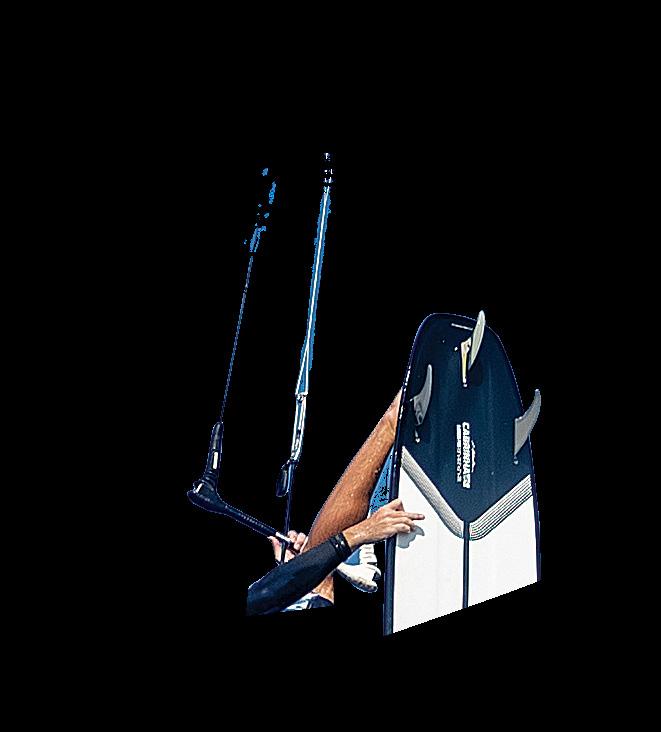
$8.99 VOLUME 9, ISSUE 1, #19 DISPLAY UNTIL: / SEPT 31ST, 2023 STYLN’ & PROFILIN’ FRANCES KELLY ON THE SET ON THE SPOT ANTIGUA FOR THE WIN! TOTALLY TRIPPIN’ NORTH OF NORWAY GEAR & BEER PUTTING IT TO THE TEST THE PACIFIC COAST SHADOW & LIGHT PARK IS NOT DEAD STOMPING THROUGH PATAGONIA RIPPING THE OUTER BANKS THE LEADING VOICE IN ALL THINGS KITE
Luff Strut
Adaptable framework made with a fill panel provides low-end power
One Point Inflation System Quick and easy inflation and deflation through 9 mm hoses
Diagonal Load Seam

Distributes kite tension with direct input steering to the middle of the kite for a powerful and balanced kite

Molded Strut Ends
Reinforcements protect the struts and bladder ends
Horizontal Seam Shaping Precisely shaped horizontal panel layout creating a perfect profile

Quad-Tex Ripstop Fabric
Strongest and stiffest canopy material on the market
Wing Tips
35% Stronger and lighter
Segmented Leading Edge
Durable, stiffer and strong. Made of Teijin dacron, it’s resistant to impact and high air pressure from the leading edge
Aramid Patches
Durable and lightweight seam reinforcements
2023 T RIAD
ALL-AROUND FREERIDE/WAVE
Quality, durability and heritage are undisputable. Re-designed for 2023, we kept the perfect Freeride kite and added an extra wave feel to it. Direct bar feel and more instant power makes this year’s Triad the perfect kite to add to your quiver.


NaishKiteboarding Naish_Kiteboarding Naish.com Kubus Sports BV info@kubus-sports.nl +31 (0) 88 5525200
Fill Panel View
SIZES: 4 | 5 | 6 | 7 | 8 | 9 | 10 | 11 | 12 | 14

 Amanda Cantor Ewan Jaspan: Triad Kite, Motion Twin Tip
Amanda Cantor Ewan Jaspan: Triad Kite, Motion Twin Tip
R E B E L


TAKE YOUR RIDING TO THE NEXT LEVEL
STRONG LIGHT SUPERIOR

4 -
OUR WAY TO MAKE THE WORLD A BETTER PLACE DUOTONESPORTS.COM FOLLOW US HIGH PERFORMANCE FREERIDE / BIG AIR






kitesurfingmag.com - 5
REBEL SLS
REBEL SLS CC06
CC08 REBEL SLS CC05
We’ve engineered the Navigator for fast, safe releases and single-action reload. Refined it for durability, comfort and tactile control. Made switching between disciplines intuitive, no-tools required.

NAVIGATOR
Think less. Feel more.
NORTHKB.COM
Knowing your kite’s position just became second nature.



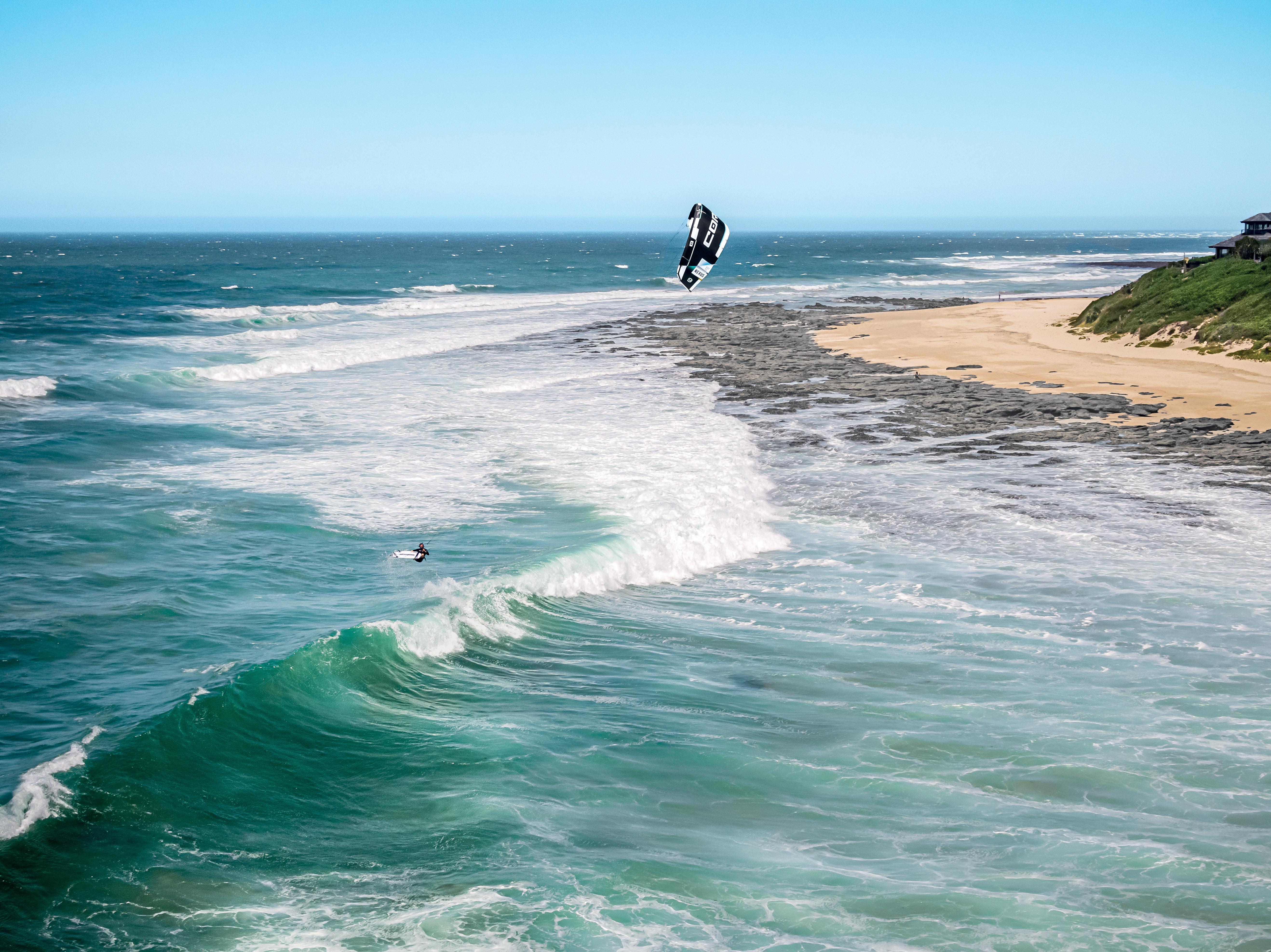

CORE Kiteboarding GmbH +49 (0) 4371 88934 - 0 info@corekites.com Fehmarn, Germany F OL L O W U S O N co re kit es .co m fac e boo k .com/co reki te s in s tag ram.co m /co rekites twitte r.co m /co rekite s
WAVE FREESTYLE FREERIDE —


BUILT FOR EVERYTHING, TUNED FOR EVERYWHERE
No-compromise all-round performance

From now on there is no need to worry about whether power, turning speed, lift or drift are more important. The ultra versatile handling of the CORE Nexus 3 makes compromise a concept of the past.
A brand new material mix of ExoTex 2 in the leading edge, ExoTex Light in the struts and CoreTex 2 in the canopy not only make the Nexus 3 stronger and more robust, but also lighter and more agile.

Don't let your sessions be limited by the kite you fly.





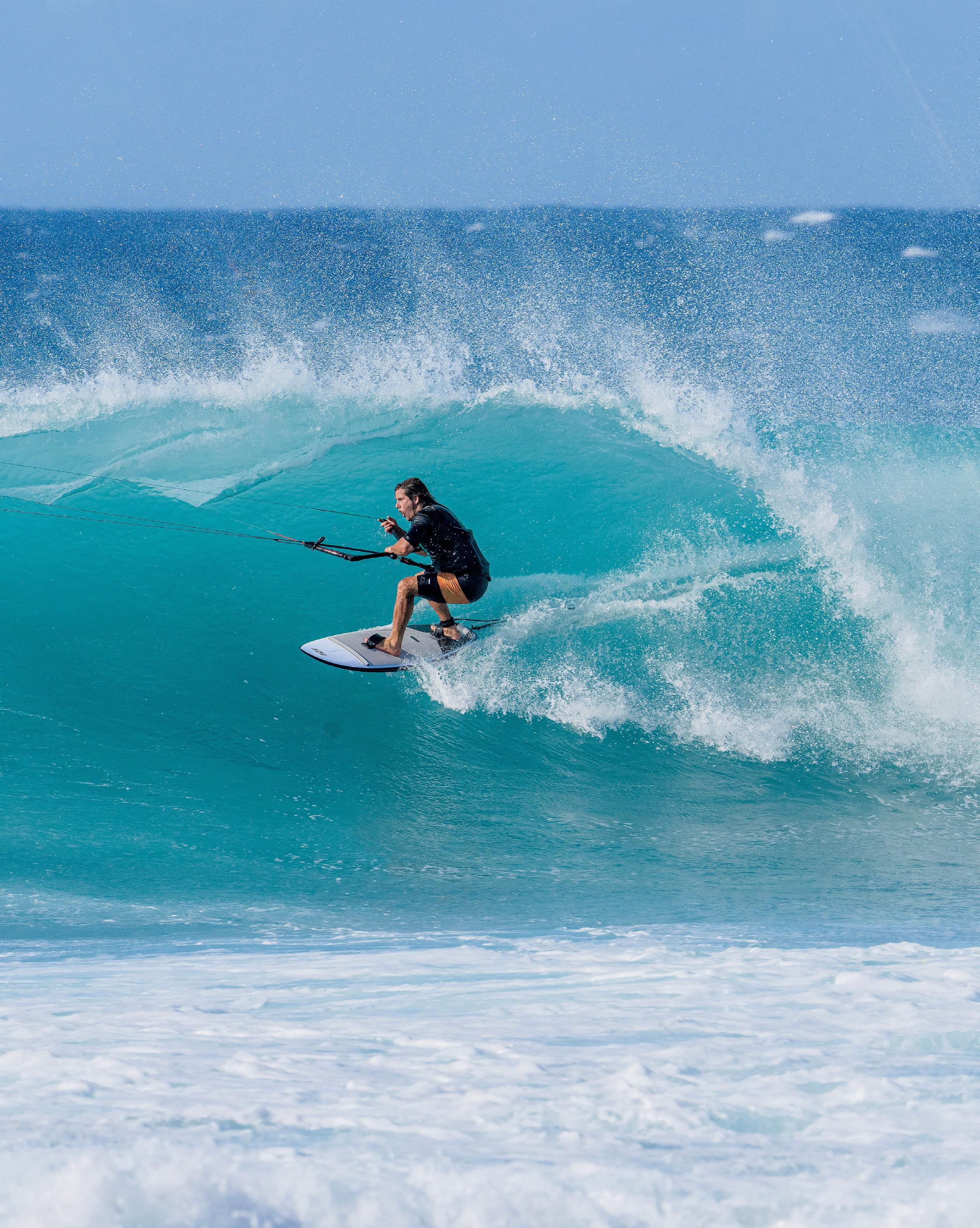
12 - KITESURFING MAGAZINE / VOL 9 / ISSUE 1
OFF THE TOP
Ho’okipa Beach Park is a world-renowned kitesurfing destination located on the north shore of Maui, Hawaii. The consistent trade winds and powerful waves make it an ideal spot for advanced riders to showcase their skills. The break at Ho’okipa is known for its steep faces and fast-moving barrels, creating the perfect playground for experienced kitesurfers to catch some air and ride the waves. Local waterman Jesse Richman effortlessly tuckes into this fun one on his strapped North Cross board. World champions do wear straps!

kitesurfingmag.com - 13
PHOTO: PATRI MCLAUGHLIN RIDER: JESSE RICHMAN LOCATION: HO’OKIPA

14 - KITESURFING MAGAZINE / VOL 9 / ISSUE 1
OFF THE TOP
Captured
the talented photographer Andre Magarao, this stunning photo showcases the impressive skills of rider Louka Pitot as he takes on the air of Taiba, Brazil. As the sun sets, the atmosphere becomes electric, with freestyle riders from all around pushing themselves to their limits and throwing down their best tricks. And with Andre’s expert use of flash, every detail of the action is brilliantly highlighted, making for a truly unforgettable session that these riders will no doubt remember for years to come.
 by
PHOTO: ANDRE MAGARAO RIDER: LOUKA PITOT LOCATION: TAIBA, BRAZIL
by
PHOTO: ANDRE MAGARAO RIDER: LOUKA PITOT LOCATION: TAIBA, BRAZIL
kitesurfingmag.com - 15
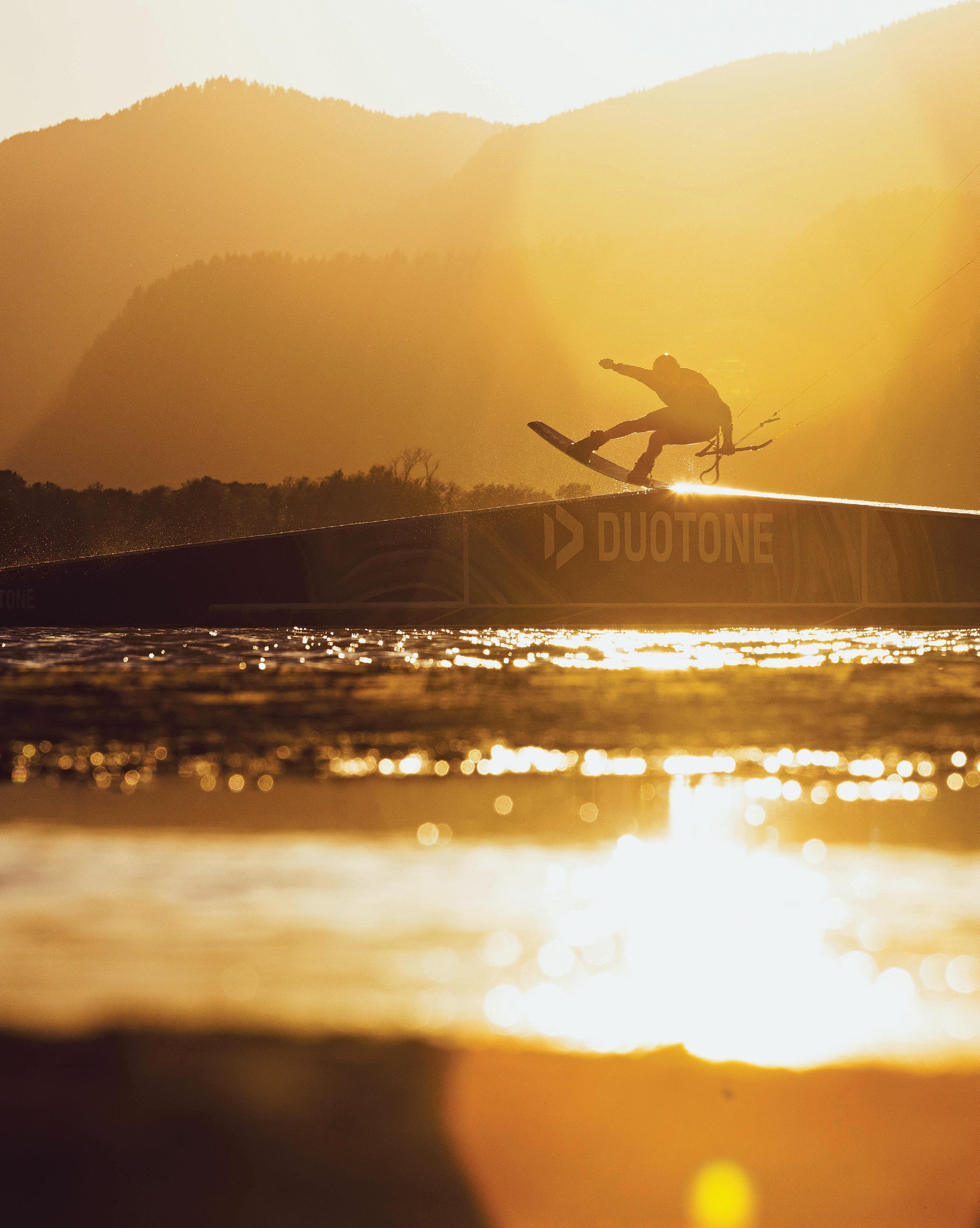
Check out the KPL team event coverage on page 26. 16 - KITESURFING MAGAZINE / VOL 9 / ISSUE 1
VOLUME 9 // ISSUE 1 // NO. 20
LOCATION: HOOD RIVER, OREGON
44 PATAGONIA: PARK IS NOT DEAD
A journey to Patagonia, Argentina to explore the thriving park style scene and how it is a testament to the resilience and creativity of the sport.
50 LIFE ON THE OUTER BANKS
Local pro rider Evan Netsch shares the secrets of life on the Outer Banks.
62 PACIFIC COAST ROAD TRIP:
BEHIND EVERY SHADOW IS A RAY OF LIGHT
Xander Raith and Noè Font drive north from California and enjoy the nomadic, tent-bound lifestyle.
72 NORTH OF NORWAY
The Manera team spends 12 epic days on a ship between the Greenland & Barents Sea.
80 HEAD TO HEAD GEAR TESTS
Test editor Shane Thompson and the Kitesurfing Magazine team check out 2023’s best new kites.
 PHOTO: NOÈ FONT
RIDER: XANDER RAITH
PHOTO: NOÈ FONT
RIDER: XANDER RAITH
Location: Antigua

Photographer: Jake Kelsick
Rider: Jake Kesick

UPFRONT 12 OFF THE TOP 20 EDITOR’S INTRO 24 MONEY SHOT DEPARTMENTS
COMPETE:
PRO
REP
36 KITE VLOGGING:
Court 40 SPOT CHECK: Antigua
Kelsick
NEXT ISSUE
26
KPL Team Battle 2022 Hood River 30
FILE: Frances Kelly 34
411: Michael Phaneuf
Tom
with Jake
98
18 - KITESURFING MAGAZINE / VOL 9 / ISSUE 1


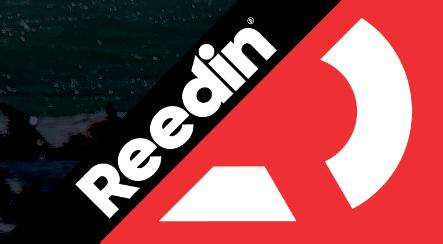



FIELD NOTES
SEASON OPENER
Are you ready for an exciting showdown? The 2023 GKA Freestyle contest format has undergone significant improvements from previous years, with the aim of attracting a more diverse group of riders to the GKA tour. I had the opportunity to attend the opening event of the season at the newly built FKB Hilton resort in Qatar. The opening event in Qatar was fun to watch. Think of it as a thrilling game of KITE where riders push each other to their limits, but instead of matching tricks in a game of KITE, riders watch each other perform and strategize their counterattack.
This season opener marked the start of a new era and provided a platform for new riders to challenge the reigning champions. In the case of the exciting women’s final in Qatar, it was a chance for 35-year-old veteran Bruna Kajiya to put a stamp on her contest riding skills and riding versatility.
During the event, I had the opportunity to have dinner with the judges and talk about the new format and the future of freestyle. Head Judge Alvaro O’nieva mentioned reaching out to riders like Jack Rieder from Vancouver, BC, about the new contest format and was hopeful he would try the new format at the second GKA world tour event of the year in Colombia.
He did. Jack Rieder turned heads in Colombia, demonstrating a lot of variety in his tricks landing a huge Slim Chance-to-Blind, and Toe side Back 5. He had some of the highest scoring heats of the event, but ultimately lost in the quarter-final matchup against current world champion Gianmaria Coccoluto and four-time world champion Carlos Mario.
The GKA tour is going to be an exciting one to follow this year, with Qatar Airlines sponsoring the entire tour and at least ten of the events being live-streamed. The production level is impressive, with live scoring, instant replays, color commentary, and play by play.
Don’t miss out on the action! Follow Kitesurfing Magazine’s Twitter feed and Facebook page today for all the latest updates on when the GKA goes live. Our social media channels are the ultimate source for everything kitesurfing, from live events to exclusive interviews with top athletes.

twitter.com/kitesurfing_mag twitter.com/john_bryja
 —John Bryja, Kitesurfing Magazine, Publisher
—John Bryja, Kitesurfing Magazine, Publisher
20 - KITESURFING MAGAZINE / VOL 9 / ISSUE 1
Vancouver, BC rider, Jack Rieder, at the GKA freestyle event in Colombia. Magarao photo
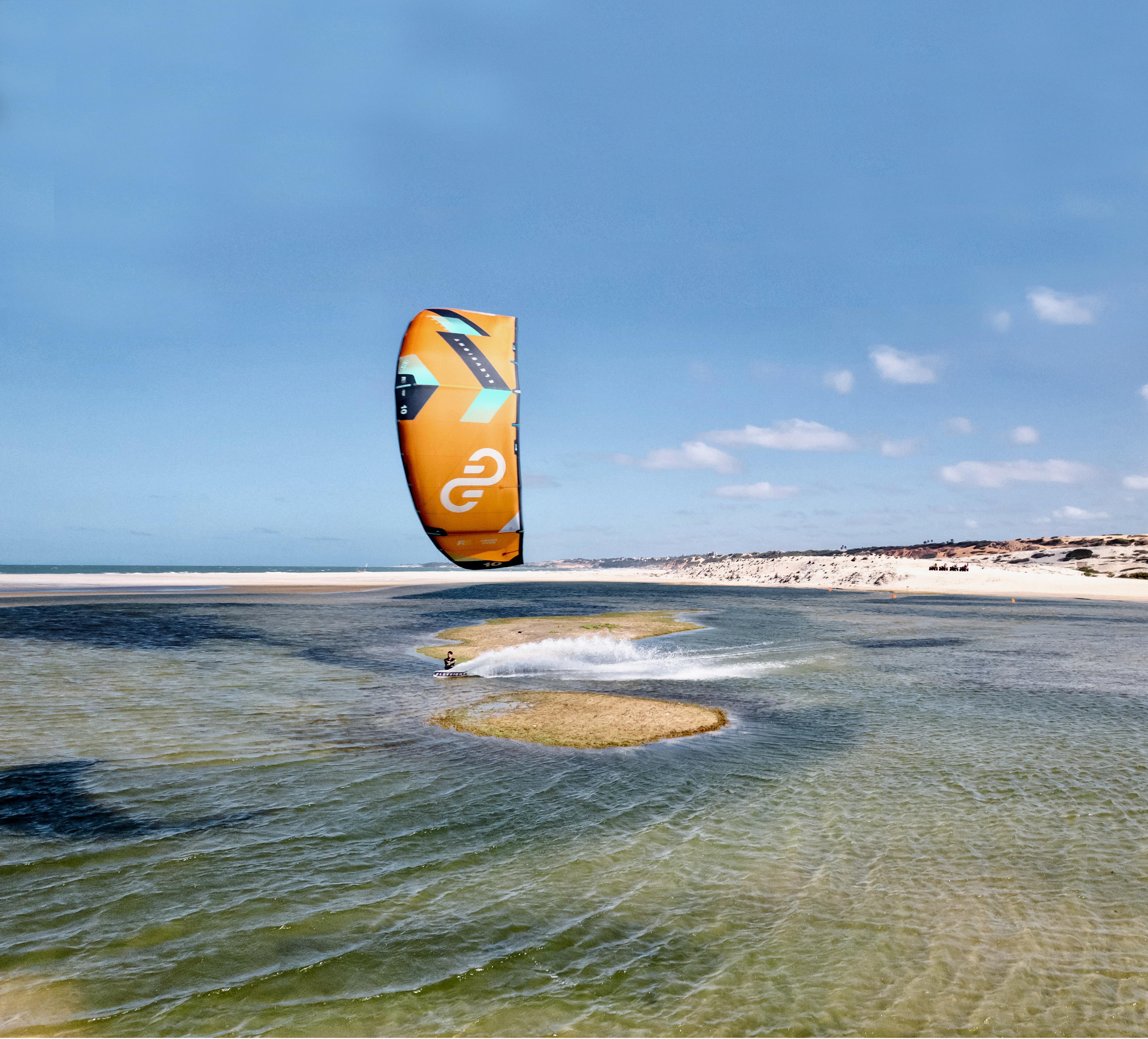



MASTHEAD
VOLUME 9 / ISSUE 1 / NUMBER 19
PUBLISHER / EDITOR-IN-CHIEF JOHN BRYJA
ART DIRECTOR DAVE AMOS
TEST EDITOR SHANE THOMPSON
COPY EDITOR COLIN FIELD
WEB DESIGN KAI HULSHOF & ERIC FEQUET
CONTRIBUTING WRITERS
TOM COURT, RAMIRO GALLART, RYAN “RYGO” GOLOVERSIC, FRANCES KELLY, JAKE KELSICK, EVAN NETSCH, MICHAEL PHANEUF, PAUL SERIN, XANDER RAITH,
CONTRIBUTING PHOTOGRAPHERS
TOBY BROMWICH, ALEX FELSTEAD, NOÈ FONT, JAKE KELSICK, MATT GEORGES, NICOLE LAIBEN, ANDRE MAGARAO, DAVE MARSHALL, PATRI MCLAUGHLIN, DAVE MODY, XANDER RAITH, SVETLANA ROMANTSOVA, SAM SCADGELL
Kitesurfing Magazine is an independent publication published two times per year. —Spring / Summer, and Fall— by Kitesurfing Magazine Inc.
101 Rossmoyne, Leith, ON, N0H 1V0
Phone: (519)370-2334
Email: info@kitesurfingmag.com
Website: kitesurfingmag.com Youtube.com/kitesurfing
SUBSCRIPTIONS
1 Year - 2 Issues $19.98
Phone: (519) 370-2334
Email: info@kitesurfingmag.com kitesurfingmag.com


Change of Address info@kitesurfingmag.com ISSN 2369-3568



Kitesurfing Magazine Inc.

Copyright Kitesurfing Magazine 2023, All rights reserved.
Reproduction of any materials published in Kitesurfing Magazine is expressly forbidden without the written consent of the publisher.

Printed in Canada
Disclaimer: The athletes and activities described andillustrated herein are performed by trained athletes and could result in serious bodily injury, including disability or death, do not attempt them without proper supervision,training and safety equipment. Kitesurfing Magazine Inc, and the publisher are not responsible for injuries sustained by readers or failure of equipment depicted or illustrated herein.
22 - KITESURFING MAGAZINE / VOL 9 / ISSUE 1
REMOTE CONTROL NAISH IN HATTERAS $8.99 THE FANTASTIC DUO Duotone’s Craig Cunningham Brochocka & Bennett How to get HIGH A new generation of wetsuits LEADER OF THE PACK WHO’S THAT VLOGGING $8.99 NAH, THATS A KITE KITES + FOILS & NEW RELEASES A HOW TO...? Steven gets HIGH KIND OF A BIG DEAL IT’s a Bird.. SO V LOGGED EVOLUTION THE EVERYTHING IS BIG ISSUE A BUNCH OF JIBBERISH WITH ERIC RIENSTRA VOLUME 7, ISSUE #16


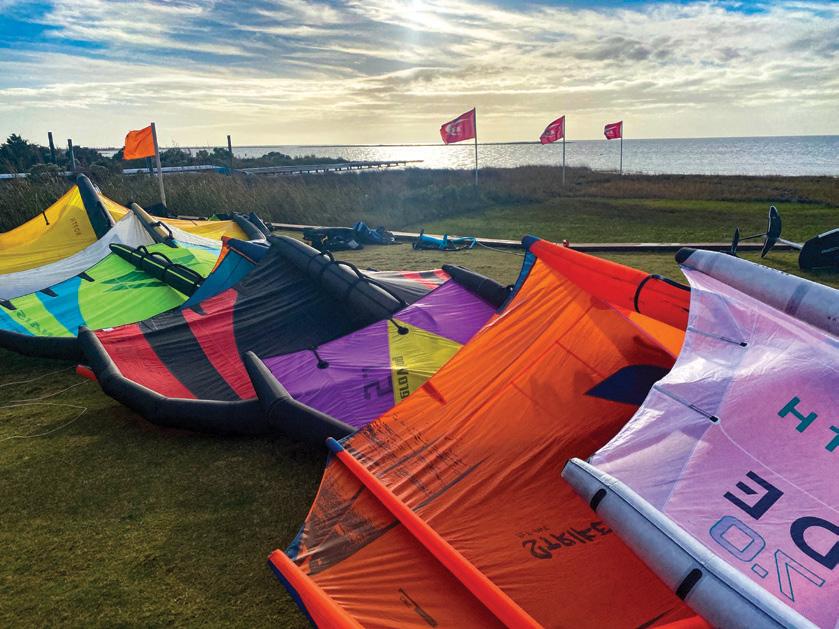


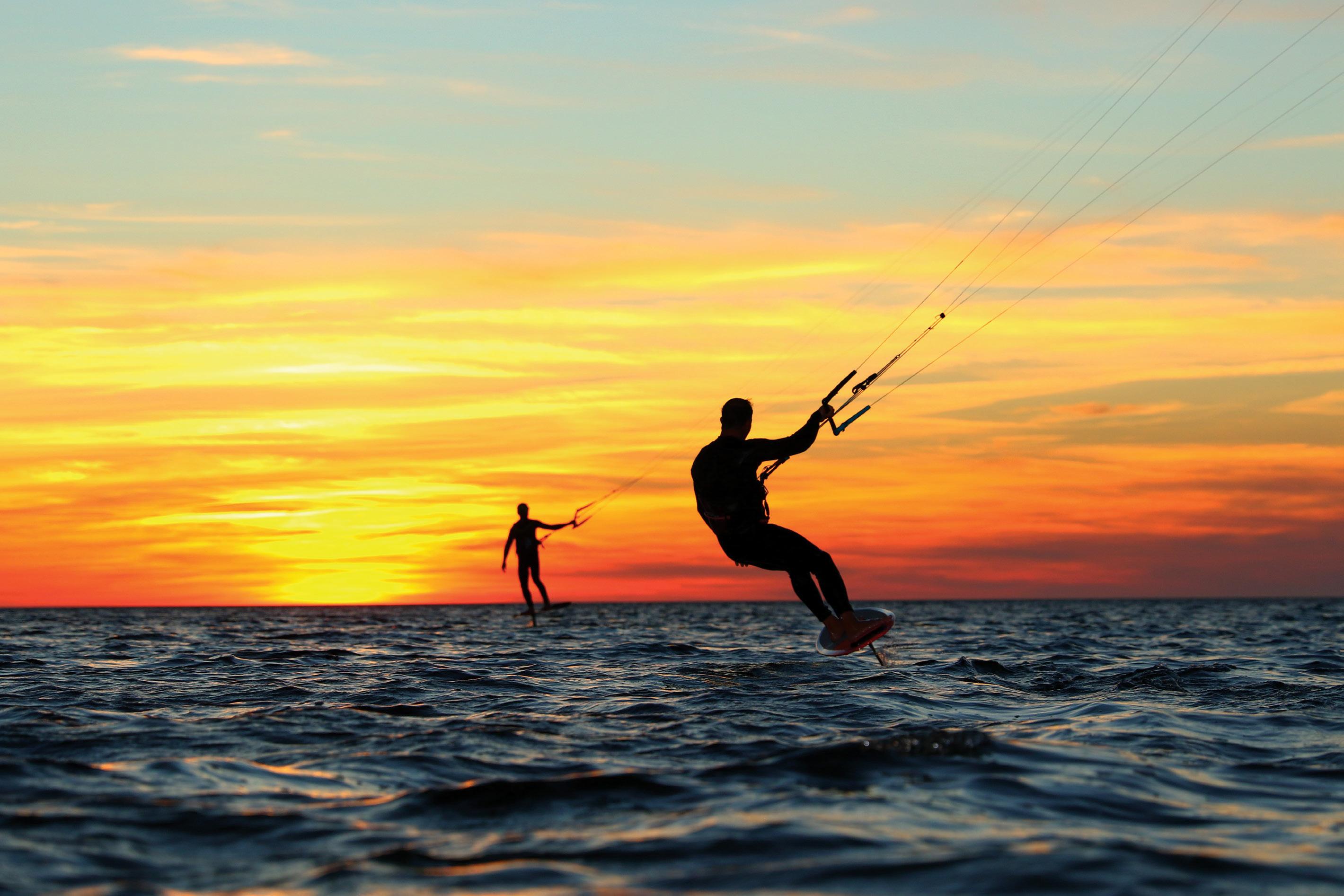



kitesurfingmag.com - 23 STOP RUNNING AGROUND ON YOUR FOIL! THE WATERMEN’S FOIL GARDEN IS THE DEEPEST, MOST ACCESSIBLE STRETCH OF WATER IN CAPE HATTERAS AND IT’S LOCATED RIGHT OUT YOUR FRONT DOOR AT WATERMEN’S RETREAT. WATERMENSRETREAT.COM • (252) 987.6060 • CAPE HATTERAS, NORTH CAROLINA ENJOY THE WATERMEN'S FOIL GARDEN
MONEY SHOT
EVAN NETSCH SESSIONS THE OUTER BANKS, NORTH CAROLIN
After spending decades of my life kiting in this exact location, it’s extra special to see a cover shot come out of my home riding spot. This location is responsible for a lot of progression for riders worldwide and has played a major part in shaping the sport today.
Rider: Evan Netsch
Location: The Outer Banks
Photographer: Nicole Laiben
The butter flat water in Hatteras is known as a destination for some of the best wake style or freestyle kiters in the world and first-time beginners alike. The consistent wind and flat water is a worldclass combination that very few places offer, and somehow I was lucky enough to end up with it as my backyard growing up through all my phases of kiting.

Without a doubt, the riding conditions in Hatteras have formed who I am as a kiter today. I spent years slowly working my way through nearly every discipline from freestyle to wake style hitting rails and kickers, big air, and gradually came full circle back to my wind-
surfing and surfing roots on a surfboard. Few places worldwide offer variety at such a high quality of flat water and waves. While the dead flat water is as good as it gets for twintip riding, it can also be a lot of fun and a great place to get in many consistent reps on a surfboard working on new tricks. In the summers at home, I now split my time equally between riding a twintip, surfboard and foil. Th beauty of Hatteras is that it lends itself to all disciplines and keeps every session unique and fun, which for me is what has kept me motivated to ride every day after over 20 years of kiting.—
Evan Netsch
24 - KITESURFING MAGAZINE / VOL 9 / ISSUE 1

COMPETE
KPL TEAM BATTLE 2022 HOOD RIVER, USA
After a global pandemic–which introduced an unforeseen hiatus for the Kite Park League Tour–one of kiteboarding’s most beloved disciplines is back. And after 13 glorious years, park riding’s pinnacle event, the Triple-S Invitational, bid farewell to the industry, opening the door for something new. In the winter of 2021, after an unfortunate leave of absence, the KPL began planning its triumphant return. In August of 2022, the KPL sent out an official invite list to the world’s best male and female park riders and on August 27th, the Kite Park League Team Battle was born.

26 - KITESURFING MAGAZINE / VOL 9 / ISSUE 1
WORDS BY XANDER RAITH
Noè Font with a Front Blunt
Unlike former events that sought to identify the best rider, both male and female, the Team Battle took a progressive leap forward introducing a new format that showcased the best riding, while simultaneously making the event more viewer-friendly. As the name implies, the Team Battle was a team-oriented contest that fostered camaraderie and group participation to determine a winning team. The Team Battle embraced the digital age and instead of going head-to-head in a series of heats, riding, filming, and editing were the fundamental principles of this event.
During the last week of August, 27 riders from around the world descended upon the small town of Hood River, Oregon for the inaugural Team Battle. Each of the 27 riders were then split into five teams, each team assigned a captain based on KPL rankings, while the remaining 22 riders tossed their names into a hat. Teams were drawn at random. Together, the five teams were each designated a colour, or team jersey, which included Team Tan, Team Yellow, Team Burgundy, Team Blue and Team Green.
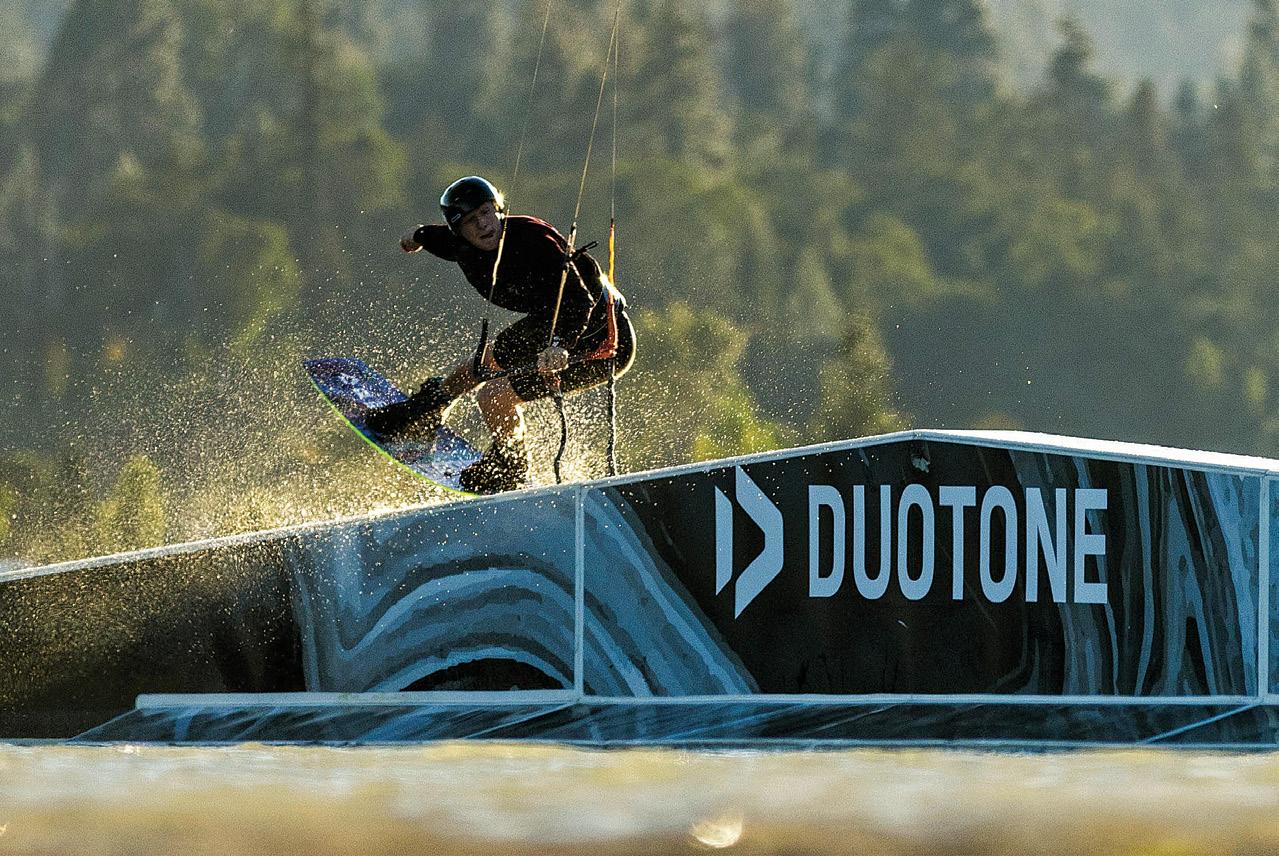


Unlike former events, the concept for the Team Battle was fundamentally built upon the establishment of a team video, where filming was the forefront objective. Each of the five teams were responsible for filming and editing their own video that showcased their best riding in and around the Hood River Slider Project. From the initiation of the riders’ meeting the morning of the 27th, the five teams were given until midnight of September 2nd to film and produce their team’s video (approximately 144 hours to ride, film, edit and showcase the best and highest level of competitive park riding). In an effort to make the films as inclusive and representative as possible, the KPL introduced strict video criteria; each rider had to include a minimum of one clip in the video, but a single rider could not exceed ten clips. Beyond those basic parameters, creativity, collaborative efforts, and team ingenuity set the foundation for the week ahead.
In typical fashion, the days following the opening ceremony were nearly absent of wind, a regrettable reality but also not an entirely devastating hindrance. Thanks to the newly introduced format, teams were given incredibly flexible schedules. Instead of everyone having to be on the water competing at certain times throughout the week, teams could film at their convenience, which helped mitigate traffic in the Slider Project park and introduced an element of strategy. Some teams tried to be on the water as much as possible, while others were more particular and sought to film when the forecast or the morning/evening light was best. Although time off the water amidst a contest of this caliber may have seemed detrimental, adequate planning and preparedness was a crucial competitive factor. In order for teams to remain competitive, each team and its allocated members needed to be ready to spring into action with cameras charged, SD cards cleared, and hard drives organized to collect and store footage when the wind beckoned.
 Australian Hood River transplant, Ewan Jaspan.
Dogtown and Z-Boys.
Australian Hood River transplant, Ewan Jaspan.
Dogtown and Z-Boys.
kitesurfingmag.com - 27
Xander Raith, Nose Press. Font photo.
When all the conditions align, park riding thrives, and beginning on day five and continuing through the event, the Slider Project was the host of this perfect storm. When the beloved western wind finally returned to Hood River, the teams were restless and as soon as the leaves began to rustle, Team Tan, Team Yellow, Team Burgundy, Team Blue and Team Green inundated the Slider Project’s park, proudly draped in their team jerseys, cascading the park in a rainbow of colour.

For the Team Battle, the Slider Project delivered in full and provided the KPL with pristine features for the event, which included both timeless classics as well as newly constructed pieces. The park included a Cabrinha box, Naish kicker, Slingshot kicker, Duotone a-frame, a pole jam and a repurposed metal Airush handrail. The collection of these features opened the door for progression and seemingly endless possibilities, allowing each team and its team riders to manifest their creativity and expertise.
The conditions promoted a level of riding never seen before in a park contest environment. Equally as impressive was the teamwork showcased by each team. In a natural yet deliberate flow, each team would siphon through their riders, sharing the role of both filmer and rider.
COMPETE: CONT.
28 - KITESURFING MAGAZINE / VOL 9 / ISSUE 1
Sam Light launching off the easy to identify Slingshot kicker.
As the final day of filming slowly waned, there was a mad dash to continue filming; nearly every rider from all five teams rode until the moon rose and the light slipped behind the mountains. Rarely does Hood River experience late evening/night time wind, but during the last few hours of the event, the Team Battle was graced with this unaccustomed pleasure. The evening light radiated orange and purple and was the most quintessential conclusion to a groundbreaking week.
While the evening session acted as the final puzzle piece that the teams were looking for, the real work was just beginning. Only a few mere hours remained in the day before the midnight submission deadline, provoking the teams to shift their focus solely towards the editing portion of the contest, inserting any last-minute shots from the evening.
When the final hours of riding on day seven came to a close, the teams were exhausted but undeniably satisfied. Although the purpose of the Team Battle was to ultimately determine a winner, the format of the event garnered collective talent and showcased the best of each rider, regardless of the outcome.
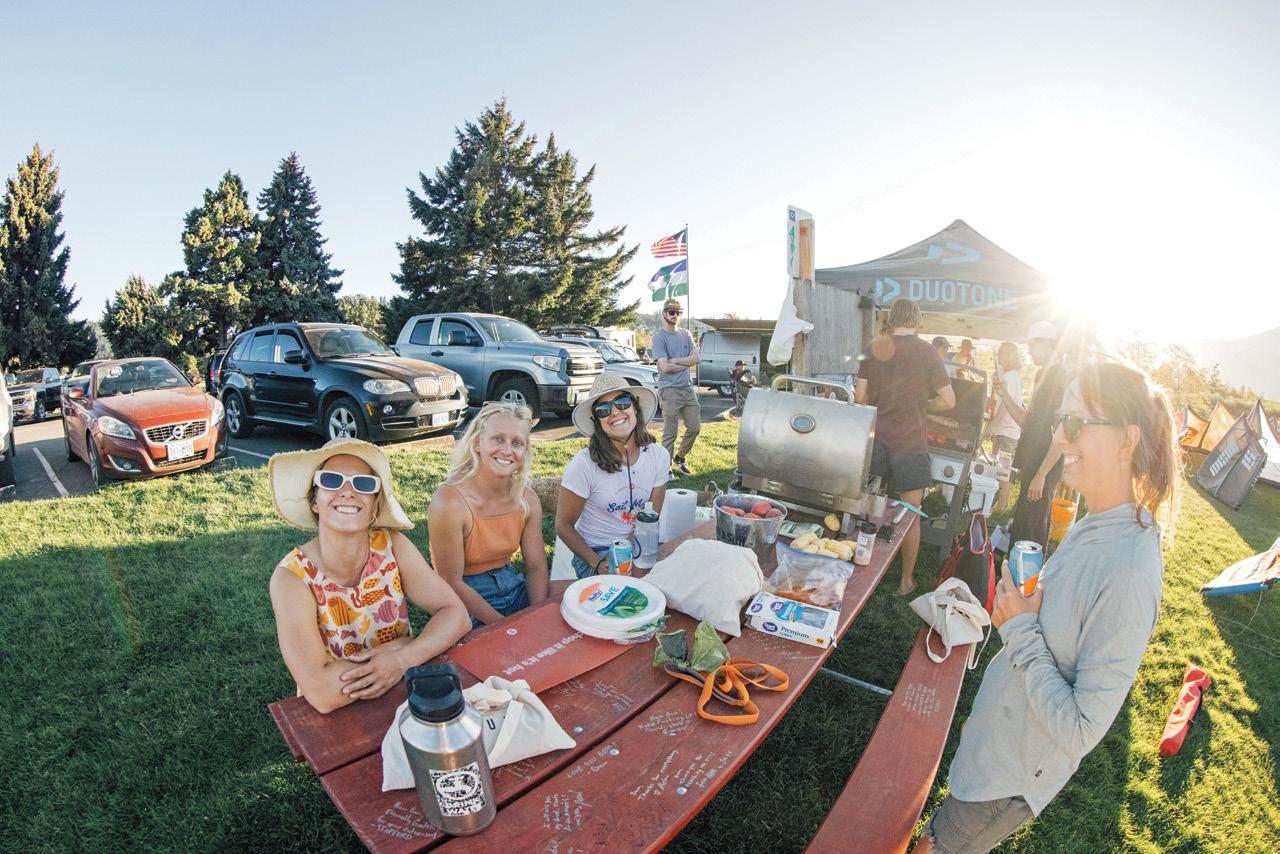

Instead of hiring a professional judging panel for the event, the Team Battle’s judging format was analyzed and determined solely by the riders. During the awards ceremony, each team video was projected for a live viewing and all riders cast a digital ballot for the video they believed deserved to claim the renowned Team Battle title. When the lights from the projector illuminated the screen, conversations ceased as jaws dropped and eyes became glued to the screen. When the videos finished, the crowd erupted and it was transparent that every rider was proud of the outcome making the week’s endeavours and the Team Battle formatting that much more meaningful. The excitement, work ethic, feeling of accomplishment and collective energy pulsing through the crowd was magic.
Along with the award to the best video, a handful of other awards were also included in the rider-based judging panel. After the twenty-minute voting period closed and the riders submitted their votes, the time had come to crown the winning team. For the Hood River tour stop, teams, industry leaders and fans proudly celebrated the collective efforts of Team Tan, the 2022 Kite Park League Team Battle champion. Without question, Team Tan logged the MTOB (Most Time on Board) during the Team Battle and seized every opportunity to work as a group while simultaneously producing the best riding and video for the contest.

The 2022 Team Battle presented by the Kite Park League was an extraordinary success. Because the entirety of the event is chronicled digitally, the team videos, team placing, individual awards, as well as the day-to-day updates are live on the Kite Park League website. This is only the beginning of a new breed of contests and park riding momentum. Welcome back!
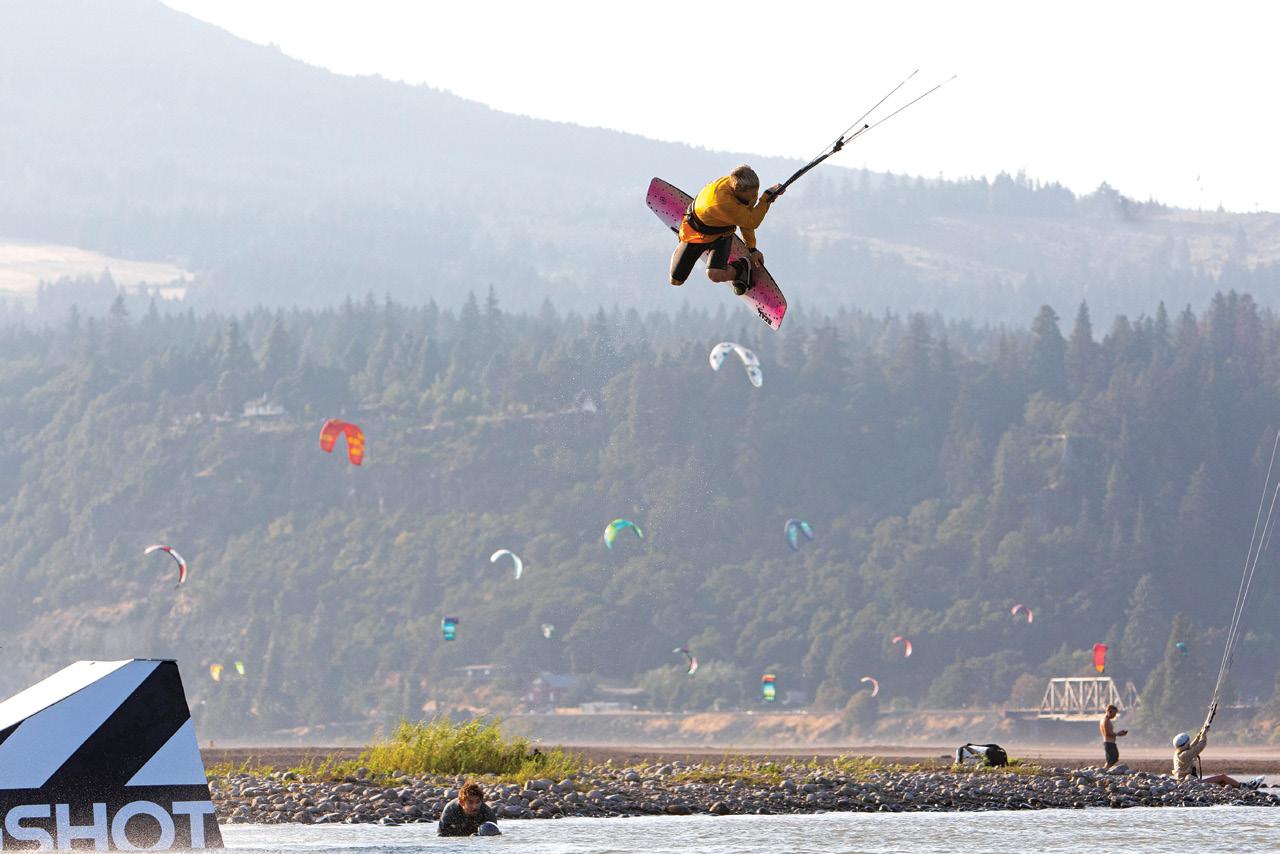
kitesurfingmag.com - 29
Brandon Scheid.
Hey ladies!

30 - KITESURFING MAGAZINE / VOL 9 / ISSUE 1
It's always exciting when a North American rider podiums on the GKA world tour. Canada's Frances Kelly finished second this past fall in Morocco. Romantsova photo
PRO-FILE
FRANCES KELLY
HOMETOWN:
Sidney, British Columbia, Canada
BOARD: Ocean Rodeo Creep and I also have a prototype surf-specific board designed by Reece Myerscough.
KITES: Ocean Rodeo HL CRAVE
YEARS ON TOUR: Since 2019
TOP FINISHES: Second place Morocco 2022, fourth overall 2019 rookie year. Two-time Canadian strapless freestyle champion.

Only a small handful of North American athletes compete on the Global Kite Association world cup tour. With most of the events on the other side of the Atlantic, the commitment needed to compete, let alone make it to the top, is huge. One athlete to make that commitment is Canada’s Frances Kelly. She recently finished second at the GKA wave event in Dakhla, Morocco. Kitesurfing Magazine caught up with Frances Kelly the day after her victory to find out what it takes.
Tell us about the journey from local Canadian girl to GKA finalist! Where did you train?
I spent January-to-March in Cabo Verde, where we put some serious hours in and scored some great waves; that’s the only wave kiting I’ve had this year until arriving in Morocco. I only had one day kiting here before the event. It took us five days to make it from Canada to Dakhla due to a mechanical problem with our first flight. We missed the next three connecting flights and almost couldn’t get a new flight to Dakhla in time for the competition! There were some tears, but I’m happy to say it all worked. We used our delays to research where we could find some waves in Casablanca and had the most fantastic experience in Dar Bouazza with our Airbnb host. I’m just so happy it all worked out, I got some waves, explored a new city and we made it in time for the competition!
I’ve spent the last three months training purely on strapless freestyle; it’s my weak point. I am super motivated to work on that and I’ve been having a lot of fun with it. Our local summer spot, Nitinaht Lake, is where you’re guaranteed wind in Canada’s summer months. Thermal winds turn on like clockwork and the campground is steps to the kite launch, surrounded by old-growth forest. Sometimes you’re lucky to find some small standing waves, but it’s mainly a wind swell, flatwater spot but very choppy. When the wind ramps up it produces some excellent kickers to launch off. It’s world-class wind!
What are your future goals now?
To win my first world tour event! I’d also love to start hosting kitesurf camps and clinics to help other girls get into the sport; that’s my other biggest goal.
kitesurfingmag.com - 31
You finished fourth overall in your rookie year in 2019 and then COVID shut the world down. What was the following year like for you?
Ah, my rookie year. I think that will go down in my books as one of the best years of my life! It was a dream come true to land on the pro circuit and travel and compete full-time all over the world. I saw conditions of a lifetime, travelled to countries I hadn’t heard of before and got to do it all with my boyfriend Luke Millard. We got engaged halfway through the tour year, making it the best year ever.
Coming off such a high in 2019, I was fired up to improve on my fourth place, but financially we had thrown everything into the previous year. COVID shutting the world down was almost a blessing in disguise. It made it clear that I wanted to be competing and I spent the year training and seeking out sponsorships. Financially it was hard, but the waves that year were pumping and I spent a lot of time
surfing. We are fortunate where we live; I can run down from my house to one of my favourite waves. COVID made it hard for aspiring athletes like myself to make a career out of their sport. It was a tough sell to potential sponsors. I got asked a lot about the certainty of events running and got a lot of potential sponsors but none came through. I knew I had to get financial assistance to make it back to the competitions and I didn’t let any of the rejections stop me from pursuing it. I used this year as an opportunity to work a lot on my mindset and kept focusing on the dream: to be a professional athlete and train with the dedication of a world champion. Ocean Rodeo called me and offered me a new contract to compete for the 2022 tour year; I was over the moon. Ocean Rodeo has been there since day one for me and I can’t thank them enough for always believing in me and helping me get to the next level.
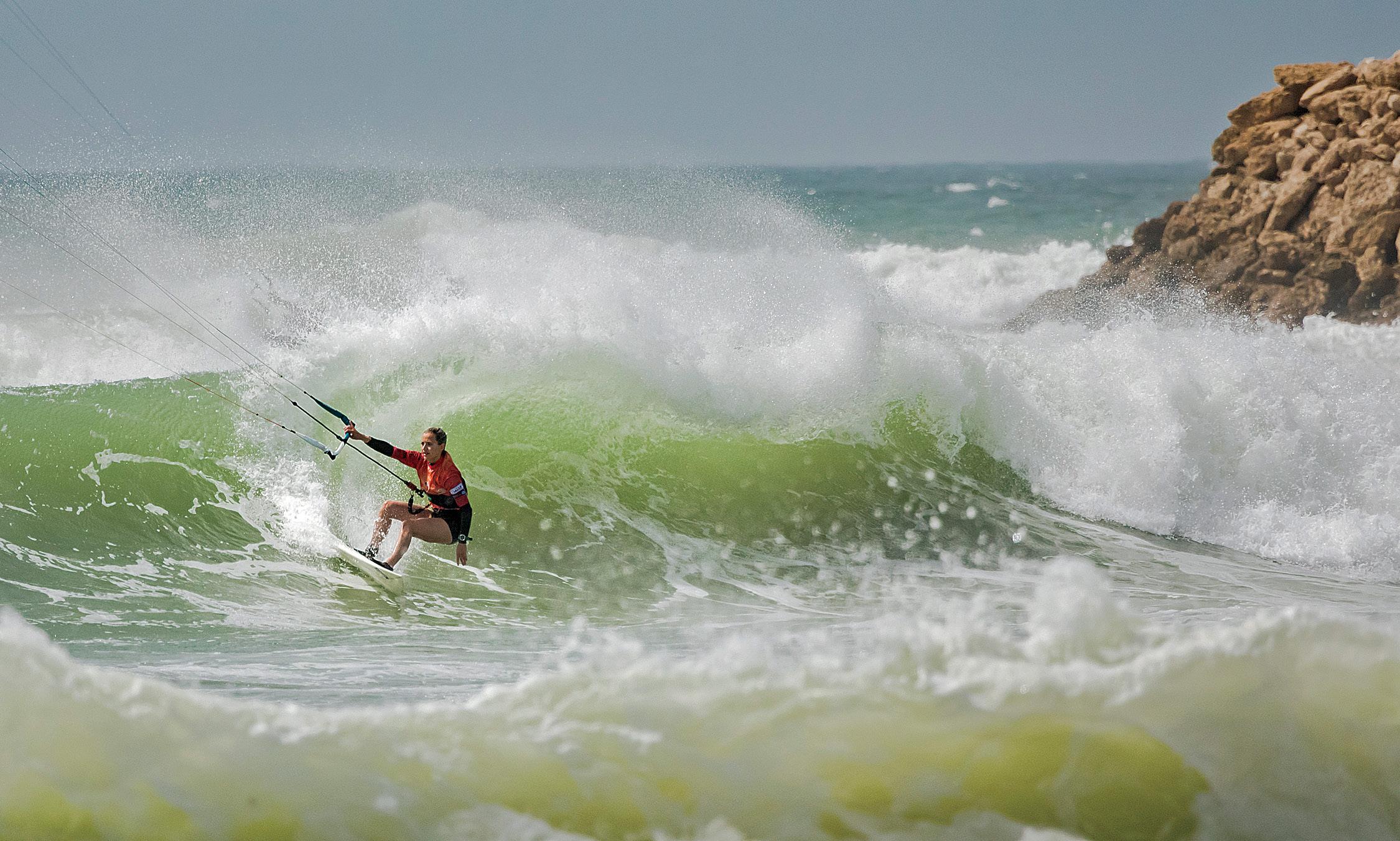
We have a few Canadian friends that have moved to Australia for a while. What’s the process like? What was your experience like living in Australia? Australia feels like my second home. Luke’s family is fantastic and he has all his childhood friends there, so it’s always a good time. The Aus life is the good life; wake up and run down to the beach for a surf and kite in the afternoons. We have a van in Aus, so when we’re not staying with family or friends, we’re cruising the East Coast chasing forecasts. We do a lot of our filming for our YouTube channel Flukes Kitesurfing, a learn-to-kite tutorial channel we started to help others get into kiting and share all that we’ve learned. We started the channel four or five years ago because, at the time, there really wasn’t anything like that on YouTube. I struggled learning to kite, so Luke had the idea to start making tutorials; we wanted to help introduce the sport to new people and help those getting into
the sport progress. We are both IKO qualified kite instructors now, I do teach in Canada, but Australia is super strict about work permits; I’m just a tourist here. So we just spend the time filming heaps of content, the long sandy beaches, sunshine and colour of the water comes across really well on camera.
Where is your favourite place to ride in Australia? Why?
One of my all-time favourite places to ride in Australia is at the Merimbula Classic; participating in this event kicked everything off for me in my kiting career! It’s a fun weekend event of kiting down in Merimbula; it’s all about participation and getting the most time on the water as possible. Events like these are so important to meet the kiting community, gain experience and really have fun kiting!
32 - KITESURFING MAGAZINE / VOL 9 / ISSUE 1 PRO-FILE: CONT.
Westpoint in Dakhla, Morocco delivers a nice set wave, Kelly takes advantage. Romantsova photo.
Where is your favourite place in the world to ride waves?

I thrive on the adrenaline/fear of kiting big powerful waves, so my favourite places to ride waves are Mauritius and Cabo Verde.
Ponta Preta in Cabo Verde, that wave is insane. Those are the most significant waves I’ve ever surfed and kitesurfed and where I’ve also had my worst wipeout. It’s a right-hander that can handle a lot of size, and the waves are super powerful. I love it and have a slight fear as well, which I kind of enjoy; I love to push my limits.
Mauritius is probably my alltime favourite place to park up for weeks on end and ride the waves. I’m kiting backside there, but the quality of the wave is so good. It’s a long ride with a great barrel section. That was my first time kiting proper reef break; super punchy and powerful. It’s a long tack out to the reef, so you can’t always tell from the beach how big it will be. I love it.
What do you do when you are not competing and travelling the world? Does the search for waves ever really stop?

I enjoy shaping surfboards; it allows you to try and create precisely what you want for certain waves. We made boards, especially for Mauritius and Cabo Verde. When the wind is offshore and you accelerate down the line, it’s nice to have a heavier board to handle the speed and any chop on the wave face. Strapless freestyle is a different game, so I prefer to have a lightweight board. I’m just a hobbyist shaper but I enjoy the process of shaping and putting the work into a board and testing it out and seeing how it performs. It’s very satisfying surfing or kiting your own boards.
What’s your most memorable moment from Morocco this year?
The most memorable moment from Morocco was waiting for scores to drop from my semi-final heat against J.C Edin for the spot in the final. Hearing my name called out was the best feeling in the world; it was my first ever final!
kitesurfingmag.com - 33
Kelly ripping in front of the Westpoint Hotel. Romantsova photo.
Oh Canadda!
REP 411
WITH MICHAEL PHANEUF
HOMETOWN: Bennington, New Hampshire
CURRENT HOME: Cape Hatteras, North Carolina
FAVOURITE BOARD AND KITE: Carved Imperator 7 139 cm, Nexus 3 9 meter
FAVOURITE CONDITIONS: Big air 28-35 mph SW. Waves 28-35 mph NE with overhead waves.
OTHER PROS YOU RIDE WITH: Eric Rienstra, Mike MacDonald, Shaun Bennett, Austin Leder, Nick Baines
LAST TRICKS LANDED: Boogie Loop Barspin with an extra rotation, and Dark-slide Backroll-to-Blind.
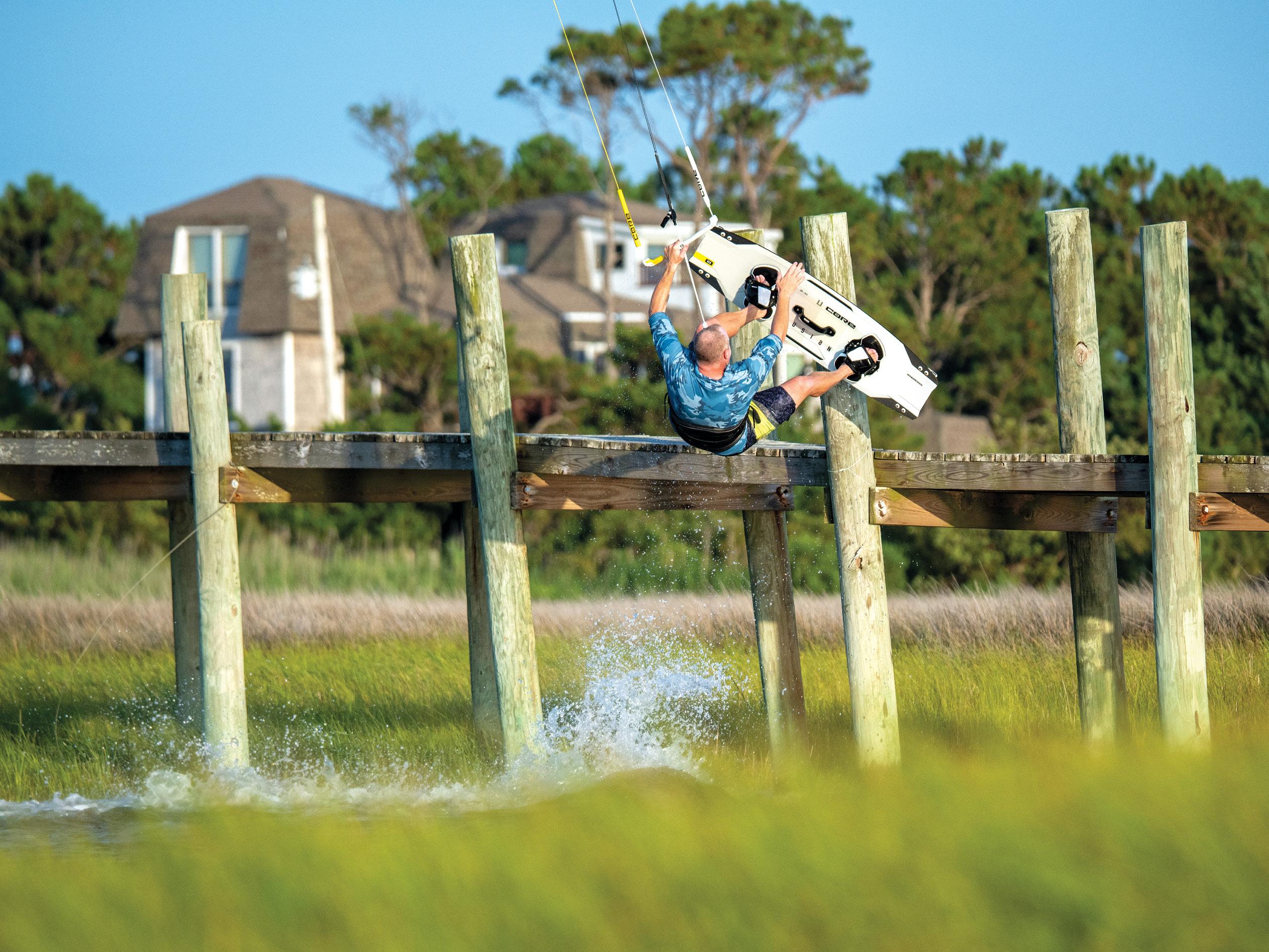
34 - KITESURFING MAGAZINE / VOL 9
ISSUE 1
/
Tells us a little about your kiting background and how you got involved with Core?
I started my kiting career as a travelling kite coach back in 2012, working in Hatteras for the summers and the Caribbean for the winters. About six months into my career, I met the owners of 321 Kiteboarding in Cocoa Beach, Brett Zachar and Romann Chavannes. They gave me a coaching job in the shoulder seasons between Hatteras and the Caribbean. Brett was also the US Importer for Core kites at the time. He appreciated my enthusiasm and riding skills and offered me the opportunity to become an ambassador for Core.
Although Core was unheard of at the time, I was ecstatic to join the team and for the chance to take my kiting career to the next level. I continued to help at Core demo events whenever I could and eventually got offered a position as a sales rep. I happily accepted the job and worked for Core for two years. Then I took two years off from the brand to manage REAL Watersports’ Lesson Center. Now I’m back with the brand and I’m proud to say I’m the US sales and marketing manager for Core Kites.
I’m excited to see the brand doing so well lately.
What impressed you most about Core when you started working/ riding for them?
I was mainly focused on handlepass tricks then, so the GTS2 was my go-to kite. It was basically a proper C-kite with bridles. It was super fun for unhooked riding and Kiteloops. But the most impressive thing was the Core team and employees. Everyone at Core is a kiter and super down-to-earth and they immediately took me under their wing. I learned so much from them in such a short time and I’m very grateful for it.
What trends in the sport excite you most?
The big air scene has been incredible to follow lately. The amount of control and awareness the new generation has while whipping through the air is impressive.
Cape Hatteras is your home base. What’s your favourite spot to ride in the OBX?
The best thing about Cape Hatteras is there’s a wide variety of spots and conditions. I let mother nature dictate my session for the day. On any given day, you can be riding butter flatwater in the REAL Slick practicing all your best tricks, or the next day you can be in the surf smacking lips in overhead waves, or maybe the wind is a little light, so you’re learning new tacks and jibes on a foil in the Watermen’s Foil Garden. This place will make you a well-rounded rider if you let it.
What piece of kitesurfing gear impressed you most for 2022?
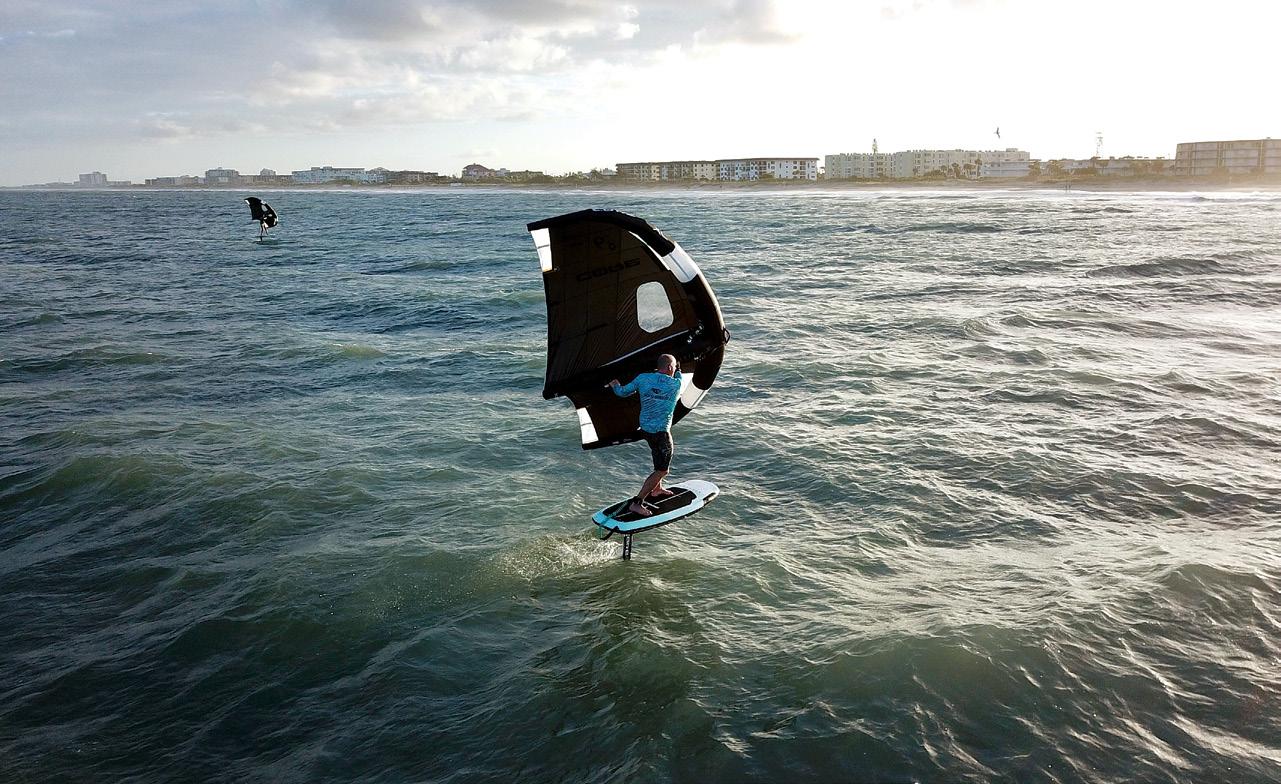
What did you like?
The Core Nexus 3 has been the most impressive to me this year. It’s a one-kite do-it-all quiver killer. I use the kite primarily for twintip riding, but it performs at a high level in all disciplines with little to no sacrifices. The kite is super stable, the power delivery is smooth and predictable, and the turning radius is tight and precise, so placing the kite exactly where you want it for certain tricks is easy. However, I’m most impressed with the improvements to the hang time and how smooth and powerful the looping is. I’ve learned more tricks on the Nexus 3 this summer than on any other kite in the past couple of years. It has taken my riding to another level.
What is in your quiver?

I’ll admit, I’m spoiled because I ride and work for Core. So I have everything in the Core lineup for just the right conditions. For the waves: Section 4 6, 8, 10 meter and Green Room 2. For foil: Xlite 2 10 meter and SLC foil. For twintip: Nexus 3 7, 9, 12 meter and Fusion 5 139 cm, plus some XRs and GTSs sprinkled in for the land-gap downwinders Hatteras offers or the gnarly Megaloop days.
What’s the best kitesurfing trip you have been on?
Hard to say. Cape Town is pretty special, but I think I will go with the island of Tobago. It’s such a chill vibe and the wind is a consistent 18-25 every day, with some days stronger. There’s a friendly kite center (Radical Kiteboarding) right on the beach in a beautifully manicured park called Pigeon Point. The mile-wide lagoon is amazing if you’re looking for uncrowded, crystal clear, flat water. Plus, when the waves on the outer reef line up, they are something to write about.
What’s on your bucket list?
For tricks, it’s a mouthful, but I want to land early-Backroll to late-Backroll Megaloops with extra rotations. I just dialled in the late Back and I’m feeling confident, so I think I’ll get the double and triple rotations soon. For kite spots, Mauritius. My Core teammates make the waves at One Eye look so amazing! I’m drooling just thinking about it.
kitesurfingmag.com - 35
Multi-sport day. Strahm photo.
VLOGGING
WITH TOM COURT
INTERVIEW BY JOHN BRYJA
You are one of kiting/winging's most popular vloggers; how did you get into Vlogging? Getting into vlogging was a slow process that contradicted how I worked in the past. I have always been into making videos and movies and was an early adopter of YouTube. On my YouTube channel, you can find videos that stretch back into the history of kiteboarding. However, it took a new perspective to start making videos with a quicker turnaround, like vlogs. Rather than spending one year on a movie, such as the Free Ride Project 1, 2, 3 and 4, or two months just shooting for a single video, I started to turn them around faster. I recognized that this enables a narrative that makes your content more personal to you. I started with a video each month, then each week, then twice a week, building the story as I went. It was a natural, slow process that, most importantly, I did because I love the sports and video production.

36 - KITESURFING MAGAZINE / VOL 9 / ISSUE 1
Felstead photo.
What have been your most popular videos or topics that you covered?
It depends. Some of my most popular vlogs have been when it all goes wrong, crashes, kite rips, storms and some of the videos I like the most have done the worst. So it’s hard to say what is the most popular aspect of creating videos like this. Topics like ‘how to dock start a hydrofoil’ and ’surf skate testing’ have been popular. ‘Sailing a kite boat’ and ‘how a kite is made’ have been some of my most popular topics. However, you can never tell what will do well or not.
Are you ever surprised by what goes viral?
I am continually surprised by what works and what doesn’t; however, it’s a dangerous game to worry too much about that. I do it mainly because I love to, I enjoy the process and it motivates me to keep going.
Who have been your biggest vlogging influences?
Over the years, Casey Niestad, Jon Olsson, Benjamin Ortega, Sam Pilgrim, however, I don’t just watch one. People’s styles change as they go, vlogs evolve and narratives develop, becoming more or less relevant to you. Vlogging is more than just watching the video; it’s following the person’s life.

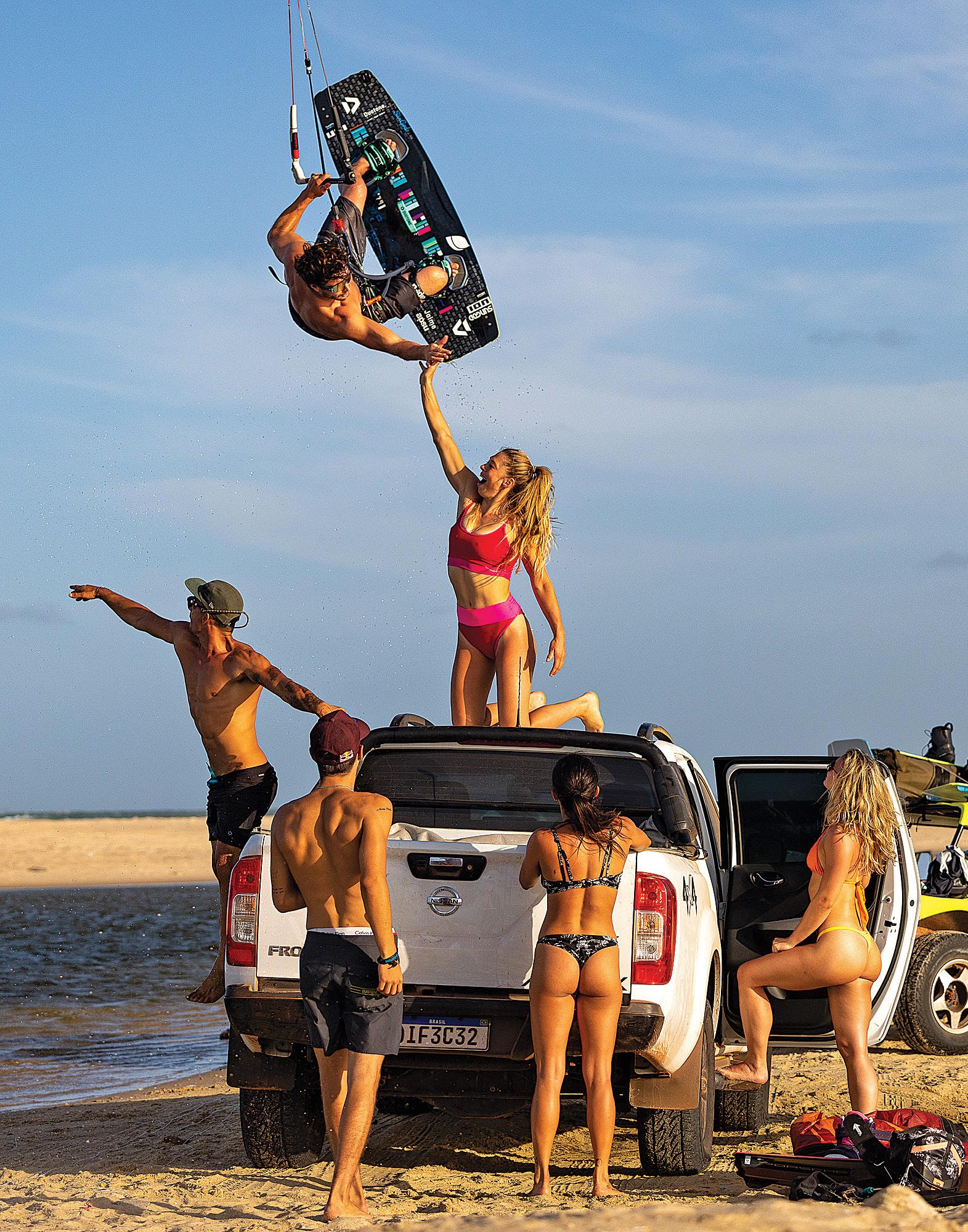
Tell us about your filming setup. How often does it change?
Since I started shooting, I have constantly been looking for the perfect setup and there are many choices. The first revolution for me was the Canon 7D and because of that camera, I bought all Canon lenses. However, now the mirrorless generation has come around, and the a7, a7sII, and aIII were my cameras of choice. Excellent quality outputs, however lousy build quality,
crap plugs and general bad usability has pushed me back to a video camera with the Sony FX6. However, by far the best vlogging tool I have is the GoPro 10 with the media mod, I frequently put out videos 100 per cent shot on GoPro, especially for action.
What is your ratio of minutes filmed to minutes in the final project?
Hard to say for sure; it used to be much more than it is now. However, I still film 20 times more video than goes out if not more.
Do you have things planned out with a storyboard in advance, is it more organic, chaos, or a bit of both?
It depends on the day. Most things can’t be planned if you are shooting the ‘day in the life’ vibe. However, if there is some vital information to get across, it pays to have a plan.
How do you manage your workflow? Get it edited immediately, or file it and work on it later?
A bit of both; if I am doing 2 videos a week, which I have let slip a little lately to have some time off, I would edit ASAP or get the timeline laid out so that when I open my computer, it’s all ready to go. Quite often, I edit multiple videos simultaneously so that I can get inspired by them all.
What was the best advice you heard that helped make your videos better?
Advice for vlogging was just to get started, not worry too much about the output, and don’t fuss over minor issues.
Over time you will become a master at it; everything takes 10,000 hours. Also, do not worry too much about any negative feedback; vlogging is a long game and you won’t make it overnight; enjoying every moment of the journey is essential.
On location in Brazil. Mody photo.
Fawley
photo.
kitesurfingmag.com - 37
What program do you use for editing? Editing tips?
I usually use FCPX when I am travelling on my laptop. However, I am fluent in Premiere, too, as I do professional editing jobs and fun video production services for events, brands and private clients.
Where is your favourite local beach for riding and filming?

I always try to vary my locations, part of my ‘free ride’ vibe is always riding different spots, different styles, boards, kites etc. Also other sports, as I get into wing foil, surf foil, kite, surf, skate and MTB sessions. They all appear on my vlog!
What have been your favourite destinations to film?
Usually, places with constant conditions so that you don’t have to worry about scoring the action. Then the story is easier to build; Brazil was epic last season, the Canary Islands for sure, Portugal and home in the UK. However, the great thing about vlogging is that it’s real; you get what you’re given, and you have to make the best of it.
Are there any big projects in the works for 2022?
Always! I would love to do another feature movie again. Watch this space! Subscribe to my channel!
MY SETUP
CAMERAS:
GoPro 10 Black, GoPro Max, a7sII, a7III, FX6
MIC:
Rhode Wireless Go, Top Mount
LENSES: 24-105 / 70-200 2.8 / 16-35 2.8
HARD DRIVES: 1TB solid states
EDITING SOFTWARE: FCPX
COMPUTER HARDWARE: MacBook Pro 16
38 - KITESURFING MAGAZINE / VOL 9 / ISSUE 1
In the eye of the storm, dramatic scenes at home on the Isle of Wight. Scadgell photo.
Imagine a harness featuring the best of both hardshells and softshells.*
A harness that would be durable as every part of it is interchangeable.
A harness 10% lighter than our lightest model.
A harness with an innovative size chart that fits any body shape.
A harness that features a groundbreaking spreaderbar.
Experience the Halo.
The best of both soft and hard shells.
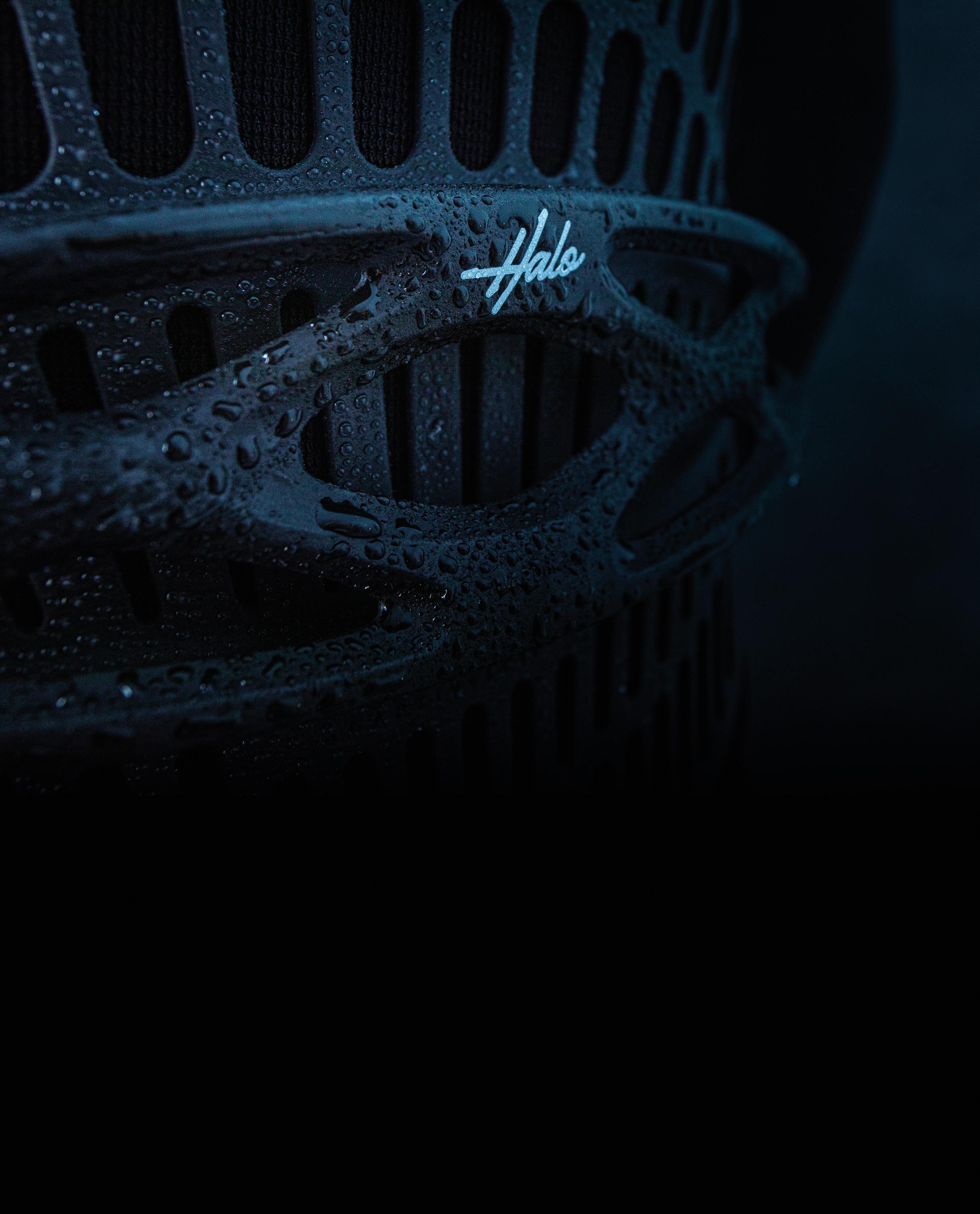
*Patent pending Distribution in North America - BAKS Distribution bayareakitesurf.com - +1 415.573.2619.
SPOT CHECK ANTIGUA
BY JAKE KELSICK
I was born and raised in Antigua and got into kitesurfing in 2003. I got to travel a lot growing up thanks to kitesurfing; I have explored all through Europe, the United States and even places like Mauritius and Russia. Antigua is still my favourite place to live, kite and explore. The island has a chill vibe, fantastic weather and is still pretty undiscovered. You can’t beat a solo session or a day out with just you and your crew. If you are an avid kite or ocean person, it’s hard to find a better place.

40 - KITESURFING MAGAZINE / VOL 9 / ISSUE 1
Jake Kelsick runs a top notch kite school in Antigua.
THE SCENE:
Antigua has a pretty unique kite scene. Locally it’s still tiny with only a handful of locals regularly getting out. But it’s also very seasonal; Antigua is one of the main hubs for all the amazing sailboats and super yachts that come through the Caribbean, so when they are around in winter (December - May), the scene comes alive. Most of the crew that work on those boats live to kite on their days off. You can expect the weekend to be action packed and the week to be pretty mellow, which makes it a great place to learn, explore and progress as it’s still rather untouched.
RIDING LOCATIONS:
There are three main spots on the island. Dutchman’s Bay Beach, Jabberwock beach and Green island. Dutchman’s and Jabberwock are easily accessible by car, whereas Green island, you will need a lift by boat to access it. Dutchman’s Bay Beach is where windsurfing first took off on the island and is now a magical kite spot with a place to stay and a few restaurants right on the beach. Jabberwock was the first official kite beach on the island and helped curate kiting into what it is today. This is the main spot that the everyday kiter will go to. Green Island is a great spot if you are on a boat and anchoring. There’s a big bay to anchor in and a pristine small beach to launch off. Just make sure you can stay upwind; there is no coming back if you miss the beach on the way back.
WHERE TO EAT:
There is a good selection of spots to eat and drink on the island and they are all segmented pretty well. In season if you want to eat, drink and enjoy a little nightlife, you’ll likely head down to English Harbor. This is the main super yacht harbour so there will be loads of people around and stuff happening at night. Top spots in the Harbor are Club Sushi, Abras, Skull Duggery, Flatties and Catherine’s Café, a high-end spot for drinks and food on the beach.
On the North side, where all the kiting happens, my go to spots are Garden Grill, Gather Steak House, Casanova, The Larder, Nomads, Papazok and Cassaroots. Garden Grill and the Steak House are located at Dutchman’s right next to our school, so we get sucked into eating there way too much, but the food is amazing!
My go-to for lunch at the Grill is the fish burger, and for dinner at the Gather Steak House; pretty much anything on the menu will leave you needing a wheelbarrow to get home. The everyday driver is shawarma from Cassanova, pretty affordable and quick.
The West side of Jolly Harbour area is a magical side of the island. It is in the lee, so very calm and protected with loads of beaches and bays and Sheer Rocks is an epic place to have a drink and watch the sunset.
CONDITIONS (GEAR TO BRING):
In-season conditions are usually 12-to-20 knots most days and very consistent. The most used kites are 10s, 12s and maybe 15s. You can get a week or two when you are on an 8, but it’s pretty rare; smooth and steady trade winds are the norm. This makes for epic twintip riding and great kite foil or wing foil missions!
LOCAL KNOWLEDGE:
The weather on the island is usually very predictable. If you wake up and it’s windy, it’s likely to be windy all day. If it’s not, it’s unlikely it will pick up, making it easy to plan a full kite day or a day out exploring other spots on the island.

MUST DO:
We offer a magical downwinder/flatwater session from Great Bird Island, which is a must do if you are on the island. It’s our favourite spot to kite. We can take a crew of up to six kiters and tap into some magical flatwater topped with an hour or so downwinder back to our HQ at Dutchman’s. It’s a unique spot because the conditions are top-tier, and even though it’s only about 20 minutes away, it feels like you are in the middle of nowhere.

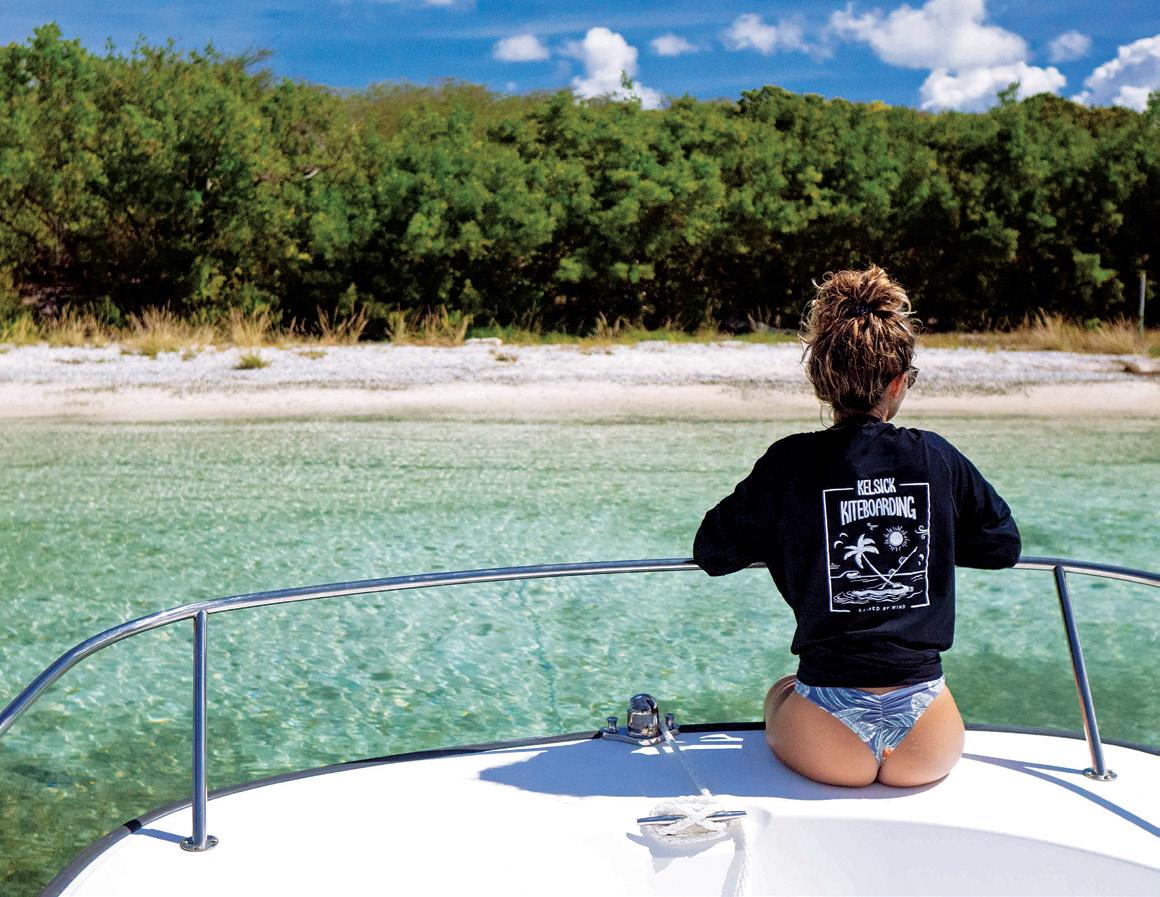
 Jake Kelsick throws a sick wall.
Jake Kelsick throws a sick wall.
kitesurfingmag.com - 41
Exploring new locations is always fun, especially with a boat.
NEED TO KNOW
Airport Code: ANU
Average wind strength: 12-to-20 Knots
Best Months: Windy Season
December-to-July. Windier months
December-to-March
Local pros: Jake Kelsick, Andre Phillip
Writer Bio: Jake Kelsick is a professional kiteboarder from Antigua. He has been kiteboarding since 2003 and has been a free rider for most of his career, creating online content about the sport to educate and inspire people to get hooked. He is also the co-founder of Kelsick Kiteboarding, one of the top water sports centres on the island, offering a wide range of services from kitesurfing lessons, wing foil lessons, kite trips, wakeboarding to wake foiling.
GETTING THERE:
Getting to Antigua is easy; there are direct flights from the UK, Miami, New York, and several other places. There is only one airport, VC Bird International (ANU) and it’s only 3 minutes from our HQ at Dutchman’s Bay. So it’s possible to land in the afternoon and end your day with an evening session!
ACCOMMODATIONS:
Dutchman’s Bay Cottages
This is our number one spot to recommend as it’s only 20 feet from our kite school HQ and is the only place to stay on the island with a kite spot right out front! The private cottages have fully functioning kitchens, so if you’re happy shopping and cooking, this will be perfect. There’s also one of Antigua’s only farm-to-table restaurants right next door. An unbeatable place to stay,
and I recommend booking early as spots go fast!
OCEAN POINT RESORT AND SPA
All-inclusive hotel about a 5-to-10 minute drive from our kite HQ at Dutchman’s Bay Beach.
HODGES BAY RESORT
A new, modern hotel just down the road from Dutchman’s Bay. If you’re looking for a fancy stay, this might be it! It isn’t all-inclusive, although there is a restaurant on site.
TRADE WIND COTTAGES
This lovely cottage was recently built. It is onlya 5-minute drive to Dutchman’s Bay. Thiscottage boasts modern finishes and comes complete with everything needed for a memorable stay in Antigua.
GENESIS KING SUITE
A modern, spacious one-bedroom apartment in a quiet semi-rural area. The suite is a 15 minute drive from Dutchman’s Bay. Nestled in a serene valley that makes for a peaceful getaway that is still not too far from the action.
OCEAN VISTA
Affordable option not too far from the beach. Tranquil and safe neighbourhood.
LOCAL SCHOOLS/SHOPS: Kelsick Kiteboarding. Kitesurf Antigua.
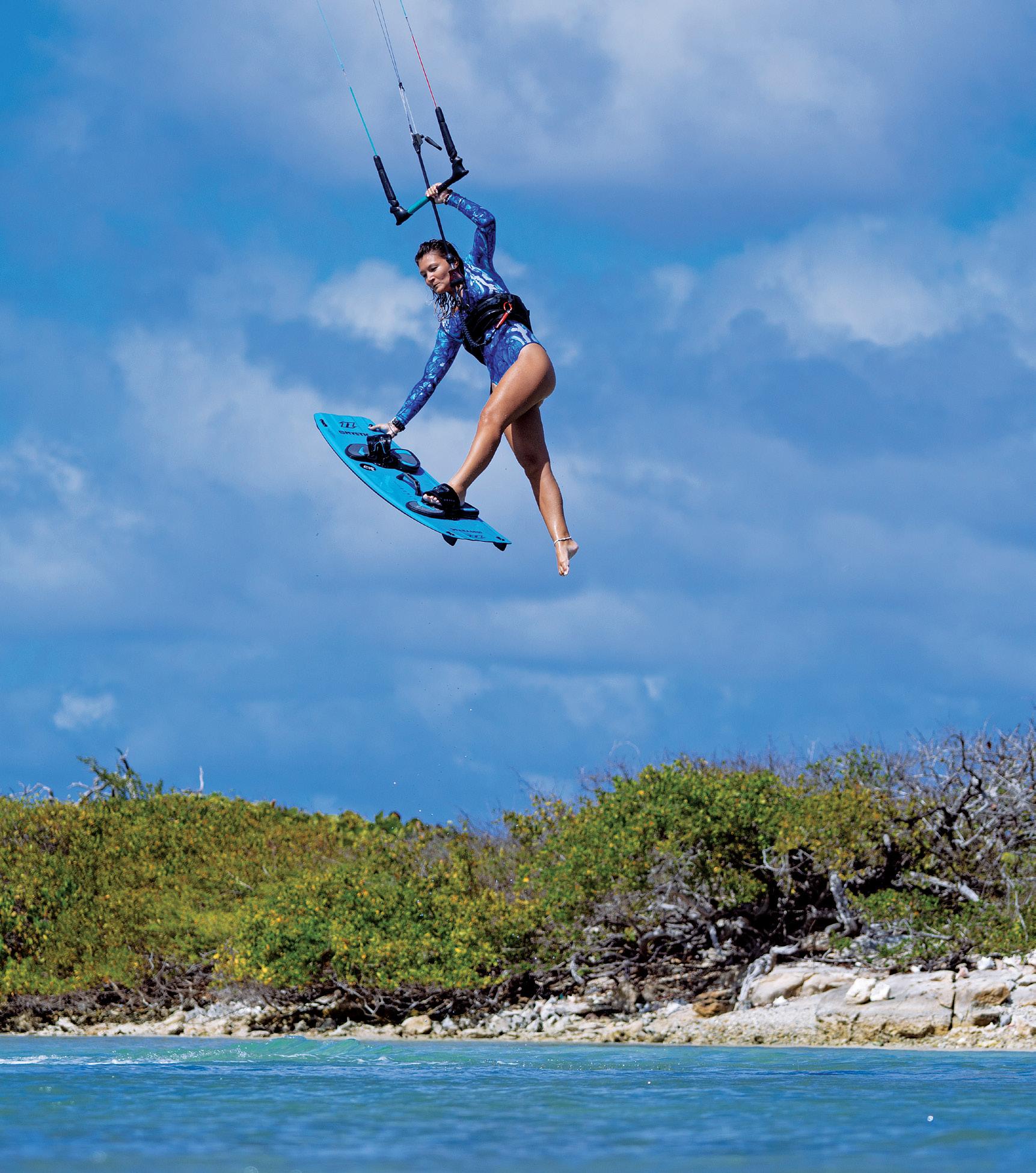
42 - KITESURFING MAGAZINE / VOL 9 / ISSUE 1
CONT.
SPOTCHECK:
No wetsuit required. Be sure to check out Jake Kelsick's kite school at kelsickkiteboarding.com.

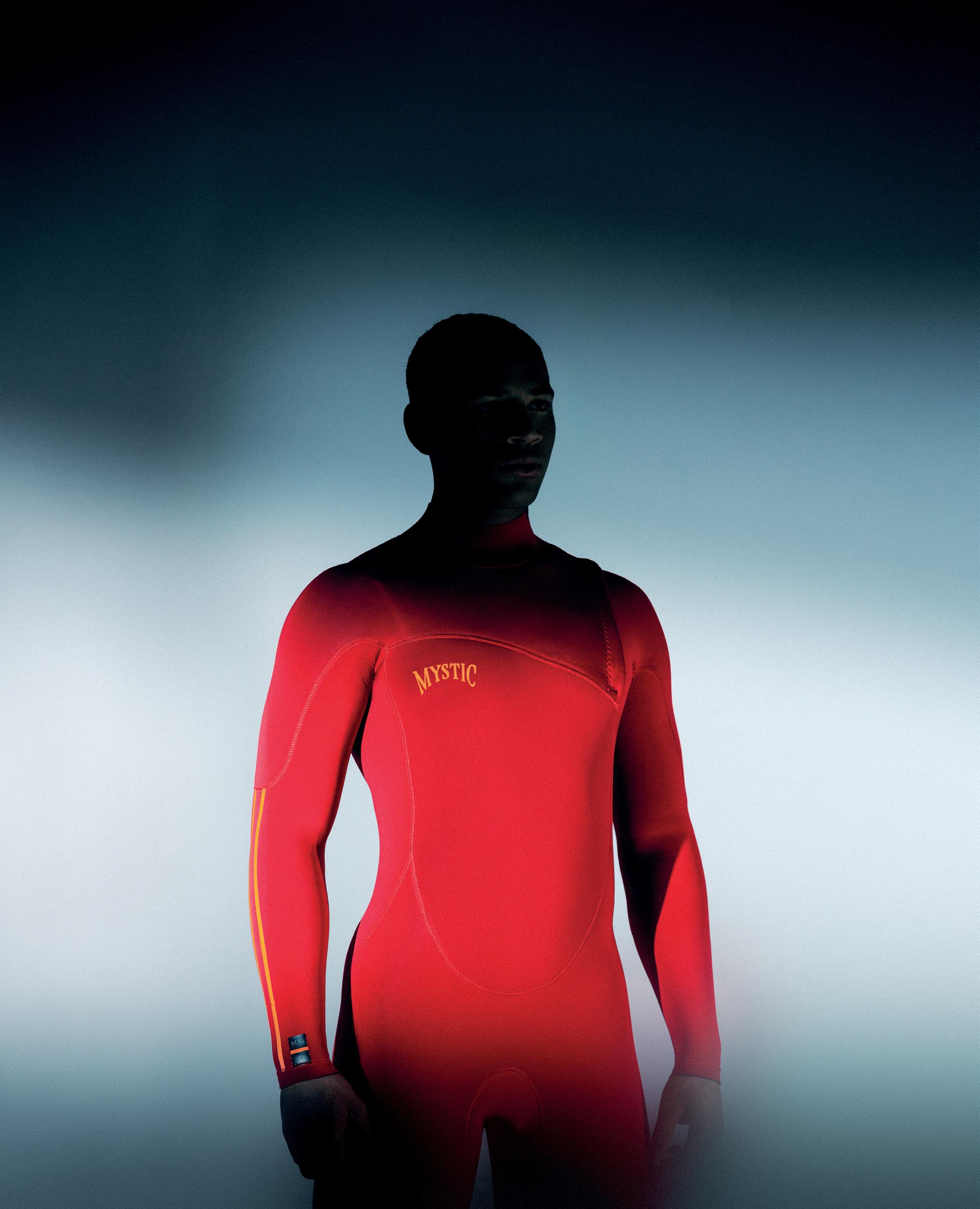
boundless waters mysticboarding.com Built for performance Cultivated in creativity The One wetsuit MX4 - YAMAMOTO 39, JAPAN’S FINEST NEOPRENE

44 - KITESURFING MAGAZINE / VOL 9 / ISSUE 1
BY RYAN “RYGO” GOLOVERSIC AND RAMIRO GALLART / PHOTOS BY ANDRE MAGARAO
HISTORY
Watching the city lights below grow larger, I felt the familiar mix of stiff legs, excitement and turbulence of going somewhere completely unknown. As our plane touched down in Buenos Aires, I started thinking about how we got here and the state of the sport of park style kiteboarding. The parallel was clear as the waters of Patagonia; we are entering a new era. Something familiar but completely new and different. We’re deviating in a new and optimistic direction.
When I first started kiteboarding, the discipline we know as park was called wake style and it came with the same clout and excitement that big air is enjoying today. The early pioneers like the Autofocus crew comprised of Andre Phillip, Jason Slezak and many others, worked hard to build their own rails and bridge the sport of wakeboarding with the kite. In the early to mid 2000s, the Triple-S dominated American kiteboarding culture. While I had helped film some early videos in 2012 with Sam Medysky, Craig Cunningham, Chris Bobryk and others, my first experience with KPL was at the 2018 Kite Mansion event in Icapuí, Brazil.

kitesurfingmag.com - 45
Watching Christophe Tack, Brandon Scheid and others set up rails in the small lagoon and fearlessly grind them, it was here I realized this would be my discipline moving forward. This was going to be my world now.
Two years later the pandemic happened and park infamously died. The Triple-S was cancelled, Hood Jam was postponed, and the Kite Mansion tour stop dissipated. The film Death of Park by Alexander Lewis-Hughes was released as a state of where park had left off and the direction it was going.
After a long hiatus Ewan Jaspan, Noè Font and others hosted the first KPL team battle in Hood River. Riders of all levels from amateurs to local heroes and the top pros, banded together to compete in a first of its kind video challenge. It was here I first got wind of the new direction and tour coming into place.
WHAT MAKES KPL UNIQUE
Shortly after picking up our luggage in Buenos Aires, I was greeted by my good friend and fellow Airush team member Ramiro Gallart. Our plan was to road trip across Argentina to Patagonia with Kristen Cooper and Matias Lee. We watched the night turn into the day and the countryside rise into the mountains. Set in the most epic off the grid location, this first stop of the new tour was thanks to the hard labor of Rami and the local Argentina crew.
KPL very much stands out in the sense that it’s the most core form of kiteboarding. It’s by the riders and for the riders. Selling kites and catering to the masses is the absolute last thing on anyone’s mind involved.
Park riding is remnant of the early days of skateboarding and snowboarding. It’s 100 per cent community driven and it’s the closest discipline in kiteboarding to other board sports; with an emphasis on style, the execution of the tricks and staying true to our roots. It’s not so much what the rider is doing as how the rider is doing it. I always think of music; you can play the most technical scale imaginable and be boring or you can take three chords and write the most iconic song in history. That is the spirit of KPL.

46 - KITESURFING MAGAZINE / VOL 9 / ISSUE 1
Argentinian Lucas Muzio inverted in Patagonia.
PLAYERS

Rami’s vision, as well as other key members of the group like Noè Font, Ewan Jaspan, Eric Rienstra and others, is to build the discipline from the ground up. The mission is to bring communities together to create permanent kite parks and riders together. One of my favourite aspects of park has been the community. Patagonia felt like a mirror to the dedicated crew in Hood River.
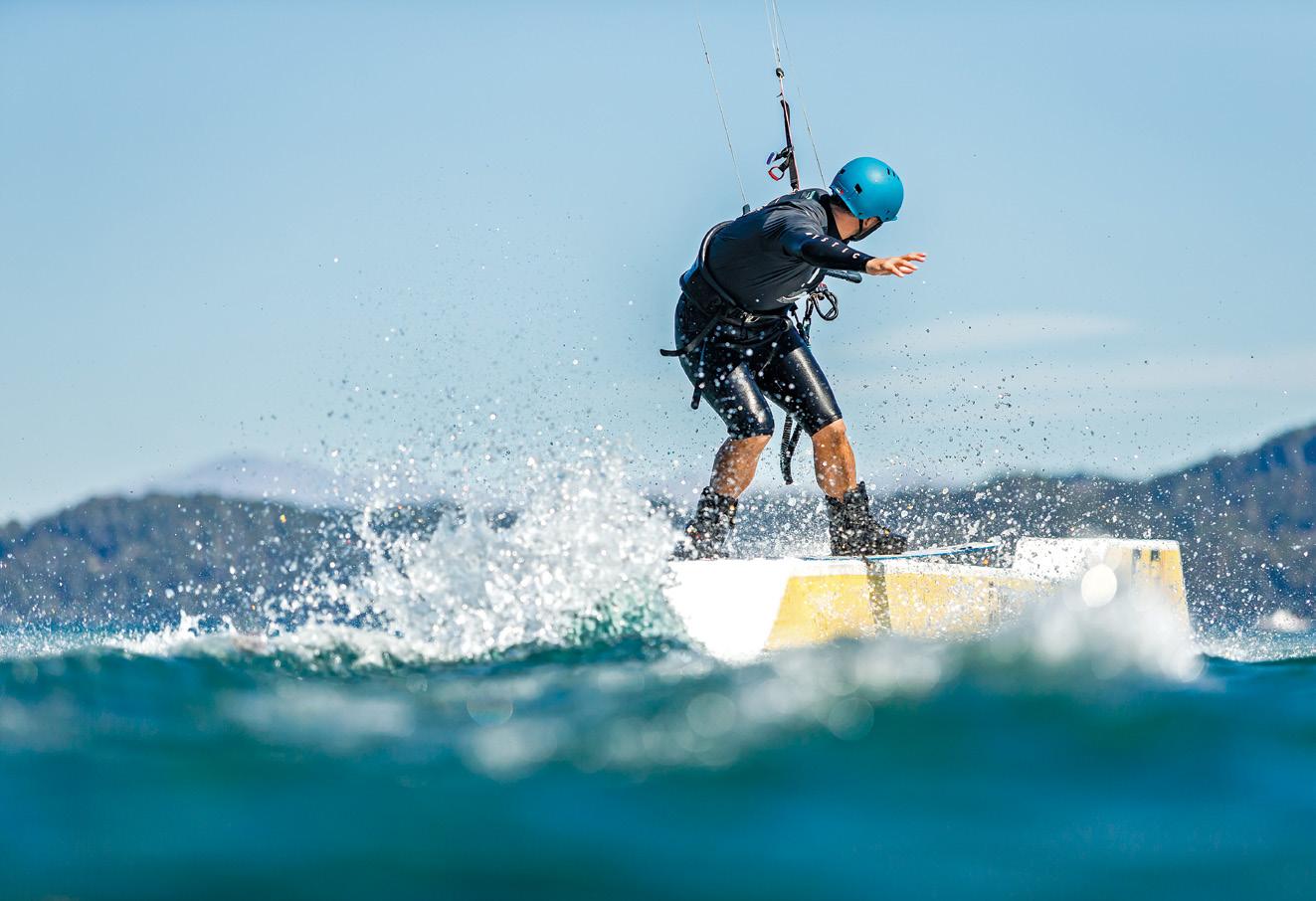
“The crew was the main thing in this comp/event,” says Rami. “Without it nothing would have ever happened. When we got the call that the permits were going forward to hold the stop in a unique island in the middle of Patagonia, I knew I needed to call the boys for help to get everything done for the event. We all drove there one week before from all over Argentina. We met up there and put in the hours of work to make everything happen. We divided in teams: in the design department we had Mora Gallart with all the social media and aesthetics of the event, Matias Lee and Noè Font with the design to print on the features. Benjamin Blachowski was the main captain, Santi Cisneros as his right hand, Mariano Cuevas as the crane operator and a crew of soldiers Justo Morando, Martin Calderoni, Rygo, and Matias Lee. Sebas Pedreira was the more bureaucratic side of the organization providing local knowledge and contacts. Mario Saopablesi the president of the Argentina Kite Association orchestrated all this.”
The most known riders in the park scene attending the event were: Noè Font from Spain; Eric Rienstra, Xanders Raith, Chad Porter, Ryan “Rygo” Goloversic, and Asher Clarke from USA and from Argentina Lucas Muzio, Mariano Cuevas and Ramiro Gallart. A total of nine riders left room for new talent to show up. Those were quite a surprise for the outsiders as no one ever expected Argentina to have such a big park style scene.
The most unique moment was when we were finally able to see the whole park out, floating in this insane clear water with wind and the sun shining. I couldn’t believe what I was experiencing. In terms of the competition, there were some great highlights. In terms of tricks, the women performed amazingly on their last slider–the Airush Incline–making it hard for the judges. You could feel them pushing each other in their heat. In the men’s division, Chad showed us he has locked in his double flips putting a few out on the right foot kicker. Noè brought the technical tricks on the rails and kickers with some perfectly execute 7s, and Xander as always showed us what press actually stands for.


We’re writing about a comp and it will always come up who did what in their heat and what the score was and so on. The truth is that this event was more about sharing and pushing the sport in a place we never thought we could be holding an event. It was just so special. Hopefully the pictures help the readers comprehend what went down but it was way beyond words.
In the end all this energy needed to flow somewhere. It was just too much to remain as a memory before going to sleep. It seemed there was no other option, especially in Argentina, than to share those memories of the day with all the crew of friends having an asado (kind of like a barbeque), drinking some wine and celebrating life and park riding.
kitesurfingmag.com - 47
Michigan's Ryan Goloversic.
California’s Eric Rienstra.
Spain's Noé Font.
RESULTS
While park is very much a board sport, you can’t just ride cable everyday and be a top player. Kite control and practice in a real kite park is what sets the top riders apart. You might be able to muscle a trick out, but KPL judging is based on style and execution. That means unlike freestyle or big air, if a rider belts out a sloppy 720, they will score lower than a stylish 540 with a laid-out grab. This location comes with its own insane beauty and challenges.
Set in shallow turquoise water between three islands on a mountain lake with smooth thermal winds, it was truly like nothing I’ve dared to imagine. However, as the wind builds, small waves and a current generate upwind of the features. This makes it difficult to get a proper line and set your kite. You could see the best riders like Rami, Xander, Noè and Eric opting for slightly less technical hits in their heat.
With the emphasis being on execution, a rider is forced to focus on what often gets left behind in other competitions and directly influences the direction of the sport.

Every day we faced different conditions, always windy but it was sometimes 15 meter and sometimes 9 meter. For the final we went through all of them. It got hard at first as the wind was shifting. It made it choppy, so riders needed to step down their game for a bit to make sure to get a score. Once the conditions got better while competing on the next sliders, they needed to bring the heat. We saw some cool moves like Rami’s back Lip with a front 450 out on the corrugated, Noè’s Stale front 7 and Lucas Muzio’s front 270 back 450 on the incline.
“With the women we saw some sick hits like Kristen Cooper going for Indy tantrums and Adela stepping up her game with front 360s on the left foot kicker,” says Rami. “They both pushed so hard that the difference between them ended up being less than half a point with Kristen taking the win followed by Adela Mendoza and then Lara Berrio.
The result for the guys' final were sixth place Mariano Cuevas with a consistent run through all the features. Fifth Chad Porter with some bangers but unfortunately some zeros too which made it hard for him to get to the top. Fourth for Lucas Muzio who is an upcoming beast transitioning his unique freestyle to the park scene. Eric Rienstra took thrid with amazing kite control that gave him some advantages over the rest on those first couple rails when the conditions were tricky. Second went to Rami Gallart coming back from his ACL injury. He gave a great performance on the last couple of rails but it wasn’t enough to compensate his average performance on the first couple ones. First went to Noè Font, also known as baby Jesus. He seems to not be affected by the quality of the wind and put out the most solid run of the event. With great tricks everywhere he dominated the scene and took the win.”
KPL is back and stronger than ever. With a new direction, a new vision and a new tour, I’m beyond grateful for this rider and community based discipline. If you have a background in board sports we encourage you to get involved and help progress this side of the sport. It’s really something special and in a way, grounding in our multi-faceted sport that is slowing become all kite and sales based. Let’s keep the boarding in kiteboarding.
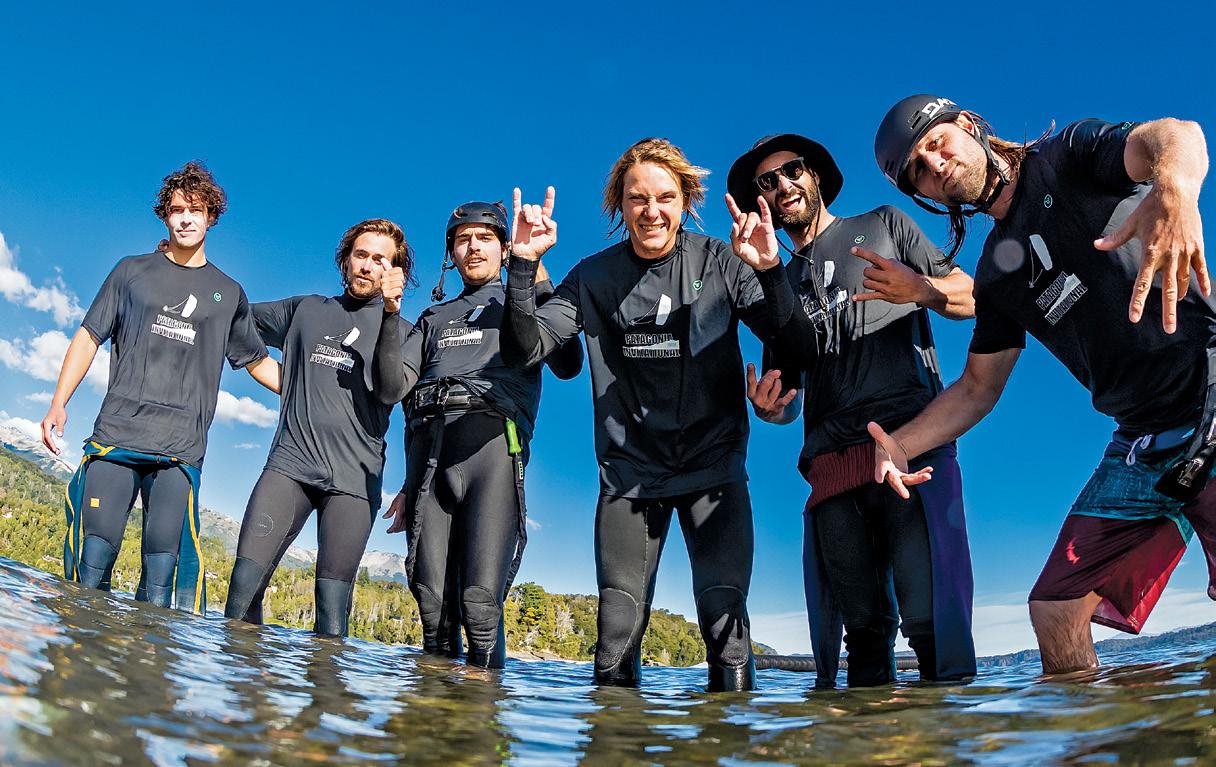
48 - KITESURFING MAGAZINE / VOL 9 / ISSUE 1
Chad Porter getting steezy.
Gang gang.
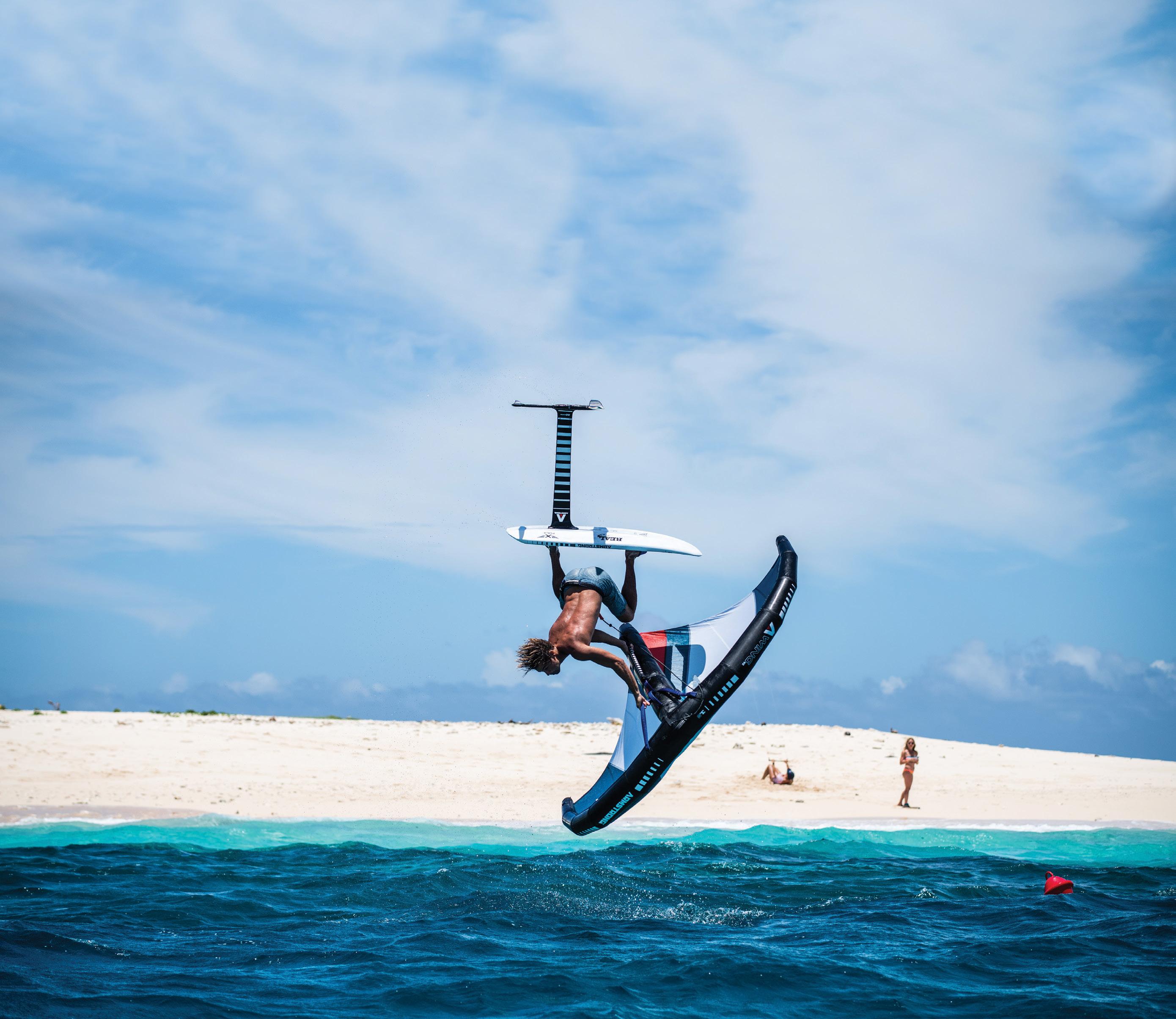




WE MAKE NEW RIDERS LESSONS | CAMPS | OFFSITE COACHING | GEAR REALWATERSPORTS.COM | (252) 987.6000 | CAPE HATTERAS, NC Every Day ZERO HERO Book your Zero to Hero Wing Camp today!

50 - KITESURFING MAGAZINE / VOL 9 / ISSUE 1
Life on the Outer Banks
 WORDS BY EVAN NETSCH PHOTOS BY NICOLE LAIBEN
WORDS BY EVAN NETSCH PHOTOS BY NICOLE LAIBEN
The Outer Banks is a pretty unique place compared to the rest of the East Coast. It’s a small community that explodes with tourism in the summer, but can be very quiet in the winter. For many people it’s too quiet and too removed from mainstream America. It’s exposed to the natural elements and my life has always revolved around these elements; the wind, the surf and the weather. Without a doubt, the conditions that the outer banks offer are what have moulded me today. During those years growing up enjoying the wind and the waves, I had no idea how a sport that seemingly had no career path would shape my life.
At this point, it’s pretty much common knowledge that Cape Hatteras is one of the most iconic riding places in the US. It has made its mark on the world stage of windsurfing, kiting and now winging. Hatteras is a destination for many, but home to few. It’s a pretty hard place to spend a full 12 months of the year, but at times the conditions just can’t be beat.

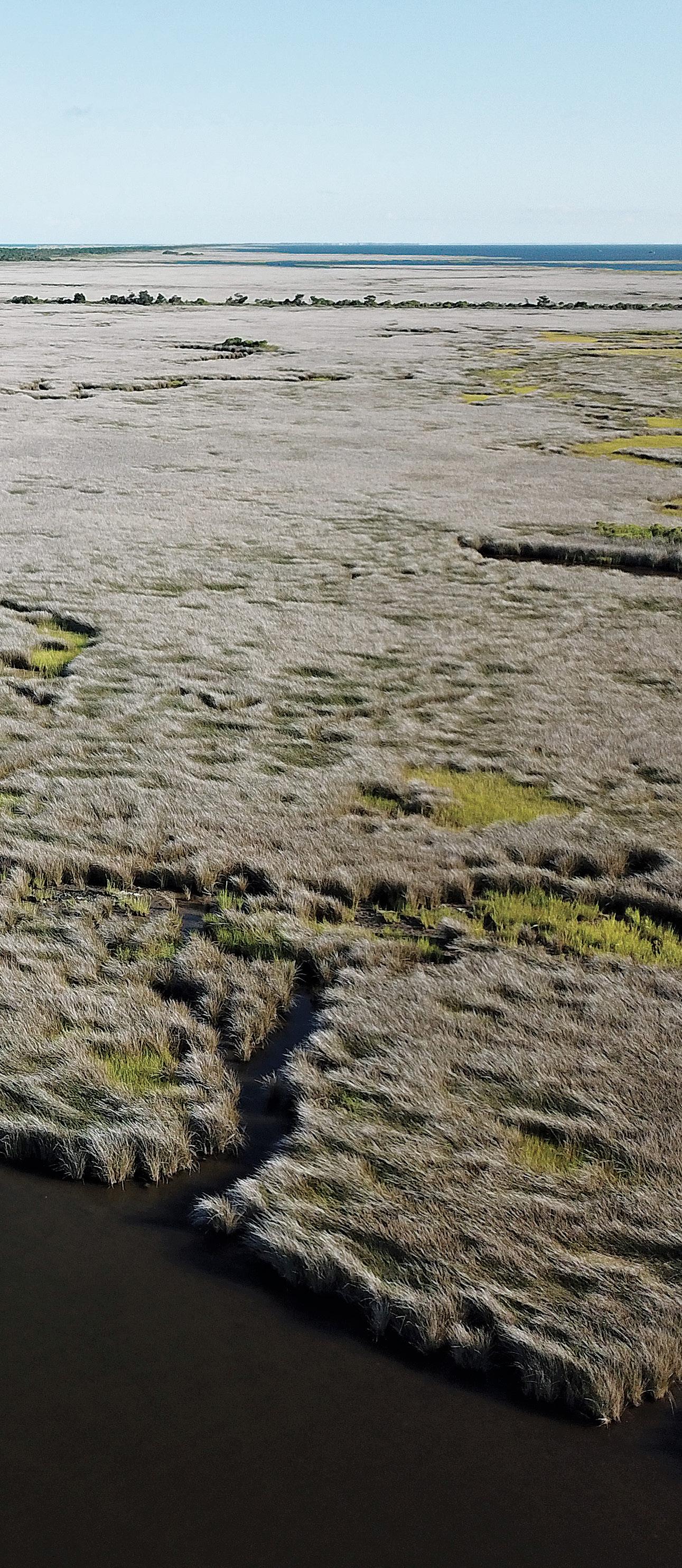
kitesurfingmag.com - 51
Cruising solo though one of the many canals outside of Avon on the “Planet of the Apes” downwinder.
GRAVEYARD OF THE ATLANTIC

Cape Hatteras reaches far out into the Atlantic; it is one of the closest points to the continental shelf, brutally exposed to the elements. The island is not much more than a thin sandbar that is shaped by wind and currents. Many people rightfully question how responsible it is to even inhabit such a place. Hurricanes have carved new inlets in the island in the last ten years alone. Keeping the roads and access to the island open is a constant battle, but not a new challenge. Navigating to and from this island has always been an endeavour. The Outer Banks hold a rich history dating back to the first English settlements in the modern United States. The first explorers battled the same weather and shifting landscape that we face today. At the easternmost tip, Diamond Shoals divides the north and south Atlantic extending off of Cape Point. With Cape Hatteras being so far from the mainland and hugged by the warm Gulf Stream, this brings warmer water but also storms, wind, waves and constantly shifting sandbars and shoals. Coined the Graveyard of the Atlantic, this region started taking down ships over 400 years ago with no end in sight; modern ships still fall victim to the constant weather changes and shallow sandbars along the coast.
GEOGRAPHY
With a shallow and protected sound on the west side of the island and a coastline exposed to the Atlantic swells and wind on the East Coast, these two options offer nearly opposite riding conditions just a minute’s walk from the other. There are many great kiting destinations around the world and frankly many may be more consistent for waves or wind, but few offer such variety. World class riding in so many different disciplines with the ability to pick and choose between what you ride on the same day. This versatility Cape Hatteras offers is truly what makes it unique and stands out as one of the best places to ride in the world.
The conditions are no secret though, especially in the spring and fall. As the northern hemisphere is just starting to heat up for the season Hatteras is one of those first places to turn on. The Gulf Stream helps keep the temperatures in check even in the coldest winter months. With Hatteras being one of the first places to warm up and last places to cool off on the East Coast in the fall, this only adds to the appeal, offering an extension to your riding season. Many people make the drive from their nearby home states, especially in the early and late seasons.
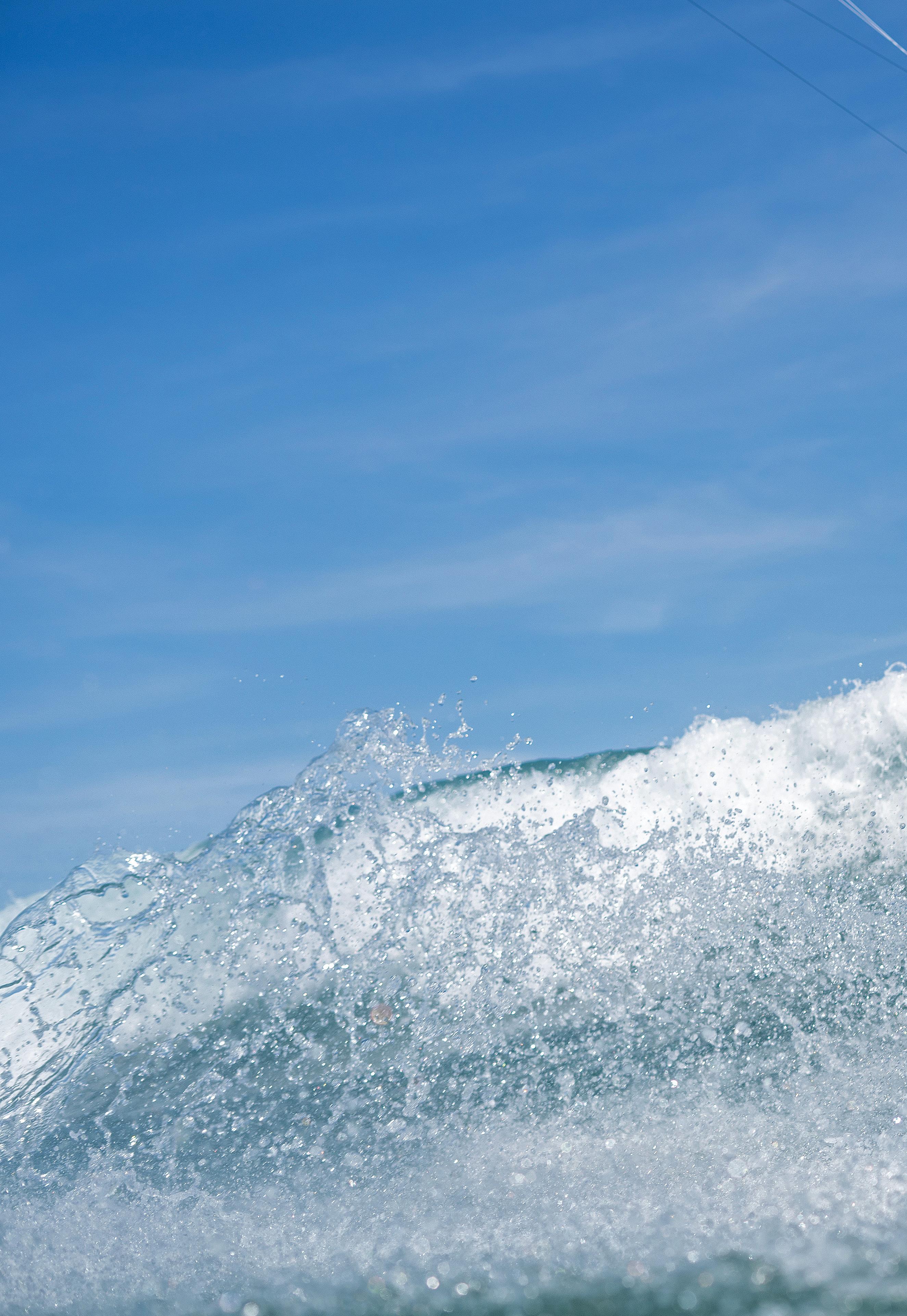
52 - KITESURFING MAGAZINE / VOL 9 / ISSUE 1
Bird’s eye view as Evan weaves in and out of ponds and channels through the marsh.
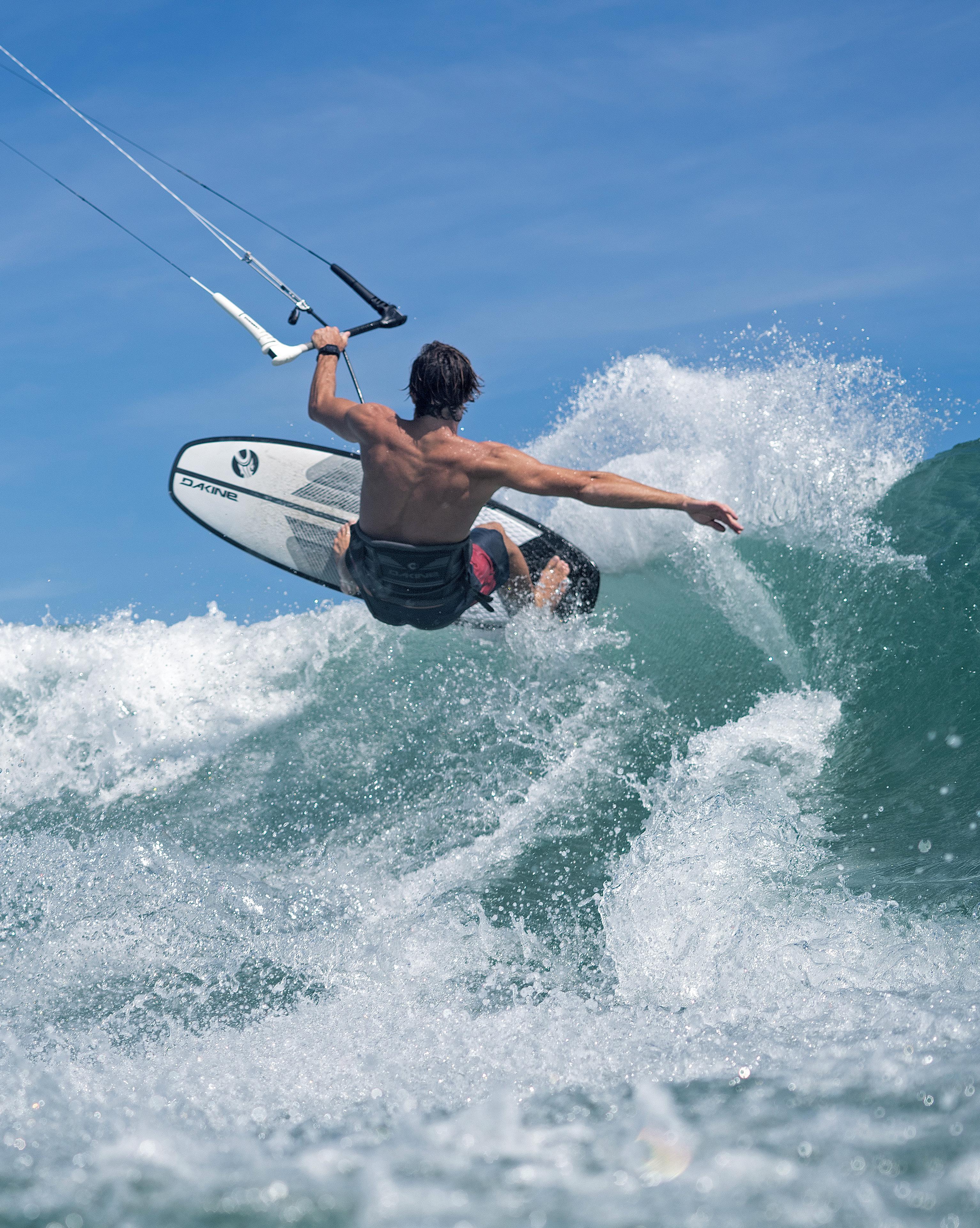
kitesurfingmag.com - 53 Fun summer waves and warm water in Frisco, NC.
Windsurfers and kiters are not the first people to be drawn to Hatteras for the wind. In 1903 the Wright Brothers, famous for inventing the airplane, came to the Outer Banks to make their dream a reality. With the assistance of the sand dunes, open areas and of course, the consistent wind conditions, they were able to achieve flight. Prior to the Wright Brothers, pirates in the 17th and 18th centuries used the island and its treacherous conditions as a hideout and lured merchant ships to wreck on the shallow shoals to pillage their valuables. Blackbeard, the most famous English pirate, called this place home and was finally caught in Pamlico South and killed on his stolen ship the Queens Anne’s Revenge. This history is part of the 2,000 shipwrecks that now litter North Carolina’s coastline and legitimize its name the Graveyard of the Atlantic.
What was a hazard in the past is an attraction today, putting Hatteras on the map for surfing and wind sports. Without a doubt, I was incredibly lucky to grow up here. Still, after 20 years of kiting, it can be hard to leave knowing that nearly every day the island offers some sort of riding condition. While I have travelled to places that might have better waves or more consistent wind, I have yet to find a place that offers such a variety, on any given day. This is what keeps me coming home every year; nearly every day can be different, and have me torn between different riding disciplines. From surfing and windsurfing as a little kid, my garage now continues to fill up with more options every year. Foils have taken things a step further down the rabbit hole. Without a doubt, this variety of condition has shaped my riding.
Around the world foils have expanded the range of fun conditions everywhere and Hatteras is no exception. The beauty in winging and foiling is that it works out to be the perfect backup plan as subpar conditions all of a sudden turn epic. We usually get pretty good consistent surf in the spring and fall but the summer can turn a bit flat. Pair what was previously a fairly unexciting 1-to-2 foot wave with the SW trade winds and you’ve some pretty ideal side-off wing days. The island is so narrow in most places that even side-offshore wind is fairly unobstructed and totally rideable.

54 - KITESURFING MAGAZINE / VOL 9 / ISSUE 1
FROM PIRATES TO MODERN SAILING
Hatteras is not only a kite destination now; summer southwest winds make for fun ocean side wing days as well.
WHEN TO VISIT
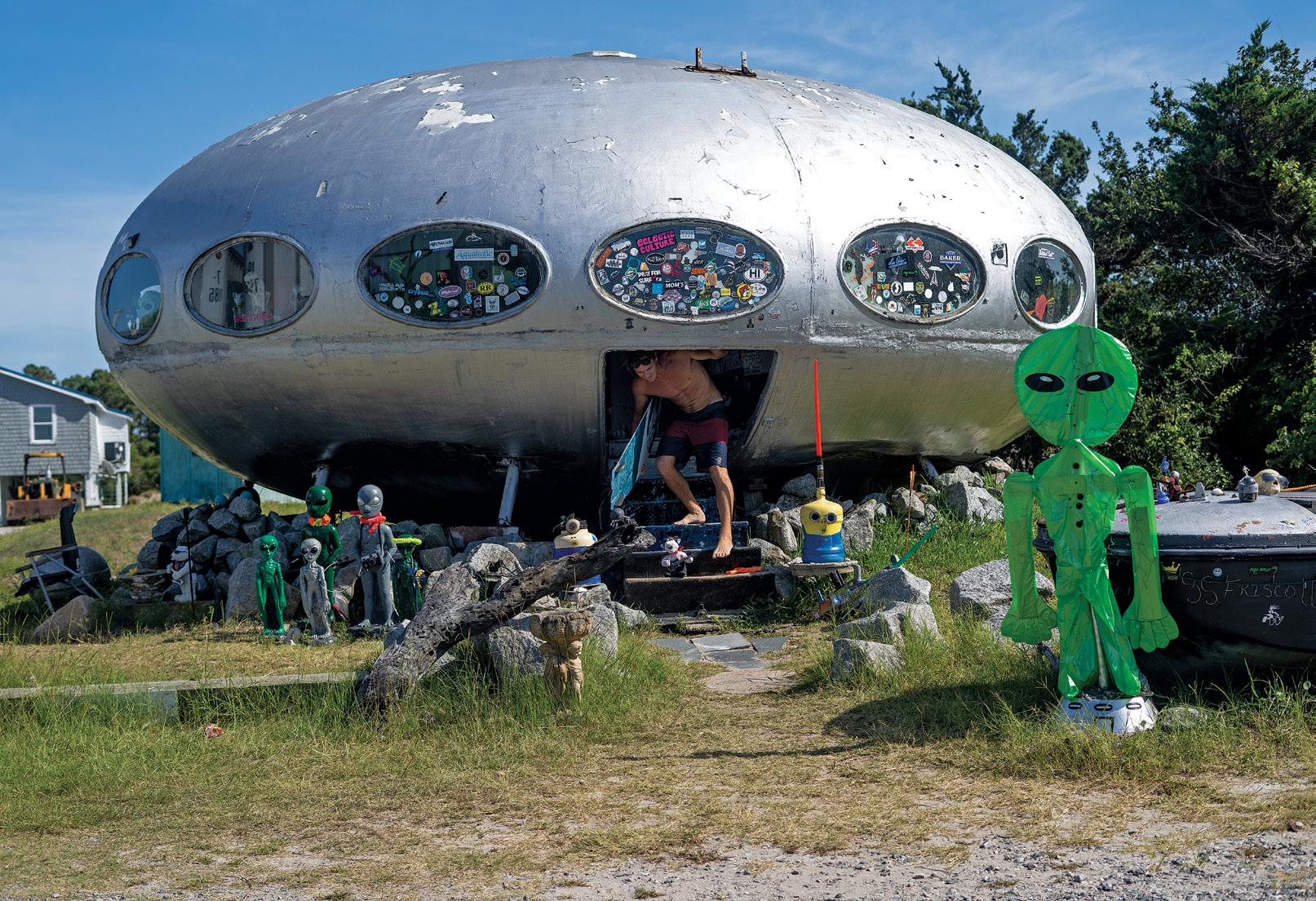
While Hatteras is famous for crazy weather patterns and quickly changing conditions, there are a few typical wind patterns. SW wind is ideally what you want for flatwater riding and is the most common wind direction, especially in the late spring and summer. This direction also works for riding waves in side-off conditions or side-on at the south end of the island. Usually starting out pretty light in the morning and by sunset, it can be in the mid-30s. In the non-summer months, we also get a lot of NE wind which generally lends itself better to oceanside riding and will quickly generate a wind swell. NE unusually comes in for a few days at a time and if we are lucky on the backside of the NE wind pattern we will get a NW wind which is generally pretty light leaving us with some fun surf as the remaining swell from the NE wind slowly fades away. South or Southeast is more of a rare wind direction but still brings its unique fun. In a straight south wind, the northern part of the Outer Banks tends to get a bit better as the island bends just a little bit and funnels the wind between Roanoke Island and Nags Head making these the better days up north. As the wind keeps shifting more SE this generally brings some rain but gives a nice opportunity for side-onshore wave riding, which is otherwise only found all the way down in Frisco in the summer time SW. I can’t complain about the NE side-onshore wave riding options either, but being a regular footer the opportunity to ride to the right and be front side is an opportunity that I try not to miss.
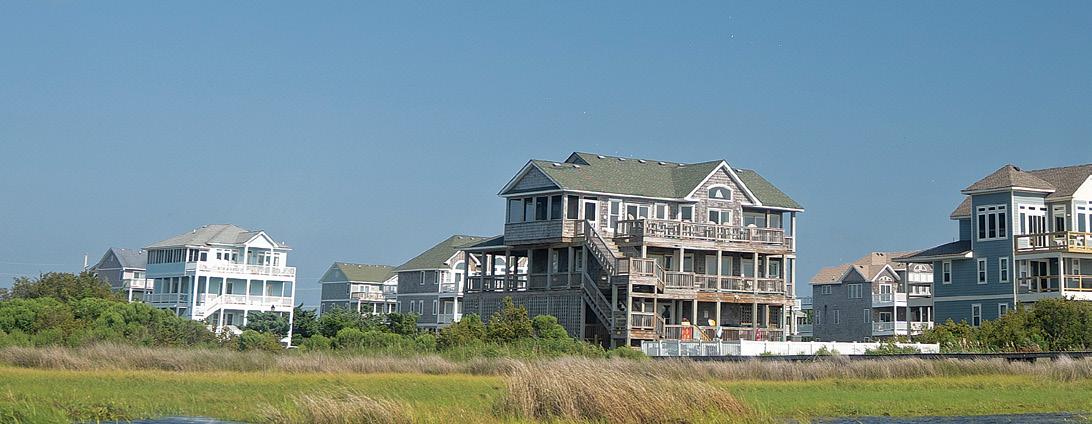
While we get the rare NE days in the summer, most of the shots you see here are on classic SW wind days. Most summer days for me start by trying to get out for a morning surf or foil if there is any swell. Back in my younger days, I was eager to get out for the 6 a.m. kite session before work, but as time has passed or I have become spoiled, I tend to save my kite energy for later in the day. At about 2 p.m. the wind will kick in. This is when the decisions have to be made. If there is a wave for kiting in the ocean this is the go-to choice. If the waves are small then I will default to a wing session, but if the wind is nuking, this is when some of the famous sound side downwinders such as the Planet of the Apes really light up.
On the windiest SW days, the wind will push a few extra inches of water against the shoreline. The sound is tidal, but can be far less impacted by the tide than the wind. The side-on wind will literally blow the water to one side of the sound and pile it up on the shoreline. With just an extra 6-to-8 inches of water sometimes whole new areas will expose themselves to ride through. Exploring by kite, jumping over points of land and marsh is something that I still have just as much fun doing today as I did at 12 years old.

kitesurfingmag.com - 55
With extra strong or west winds the water level rises, opening up even more new riding spots as sections of marsh flood.
There are endless options for jumping small and large land gaps. Many houses have private water access, but heading downwind through town is the best way to make sure you don’t miss any of the good spots!

56 - KITESURFING MAGAZINE / VOL 9 / ISSUE 1
REALITY CHECK
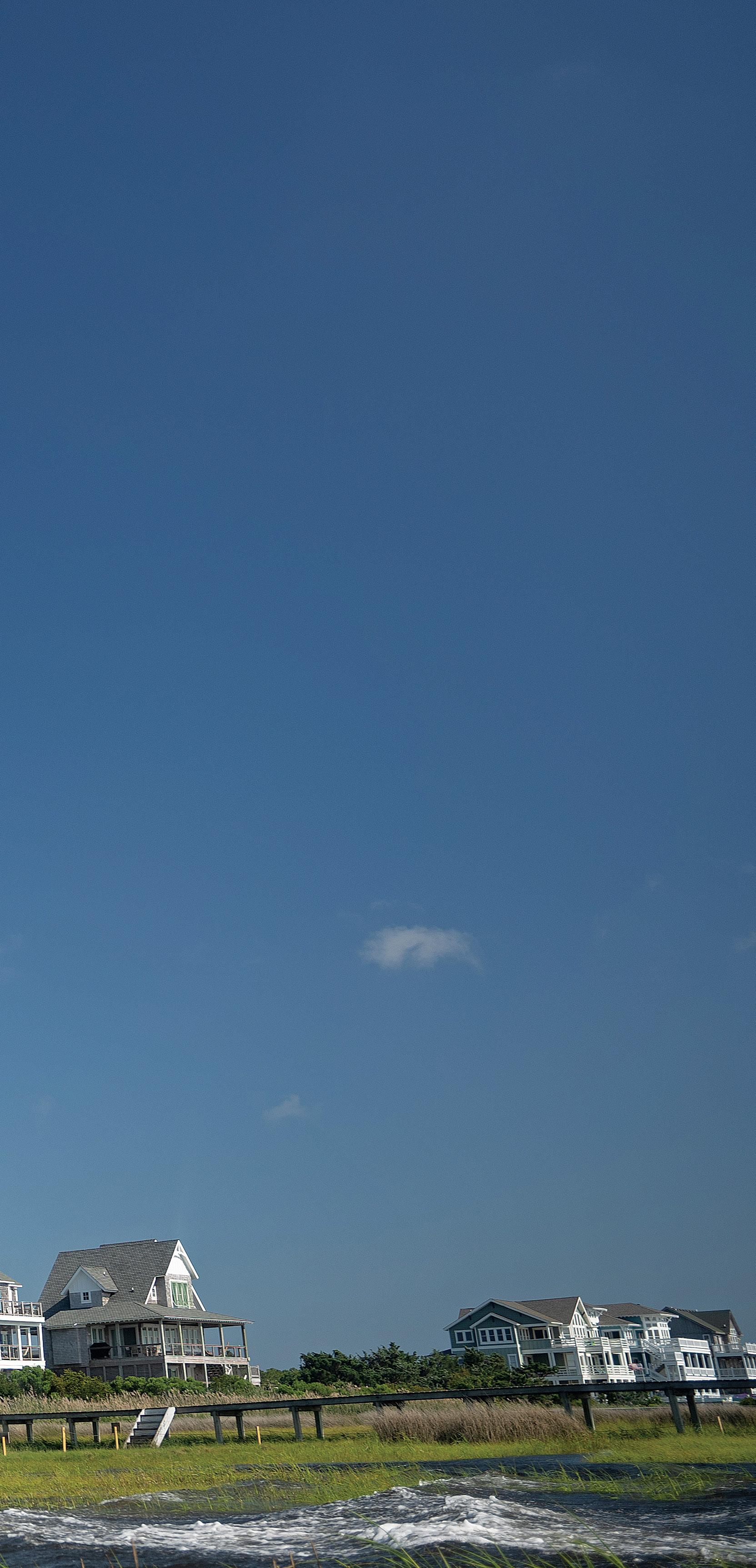
Now if this all sounds too good to be true, it kind of is. I’m all about honesty and Hatteras comes with its downsides as well. Besides being pretty far out of the way to get to (which can help keep the crowds down) the main drawback for myself is the lack of a proper point break, with the exception of a rare sandbar that might come and go within a season or a week. There is not any solid landmass to hold a permanent break, so for nearly every swell it is always a bit of a hunt. This lack of a solid landmass also makes the island fragile and susceptible to storms. This spring alone two houses washed into the ocean as the sand got eroded out from under them during a week of strong NE wind. Hopefully you like beach breaks, because if you are looking for that perfect peeling point break wave, you are going to be disappointed. While we are not South Africa status sharky, the water still has a lot of life in it, and we can just leave it at that. You also might want to keep an eye out while kiting for fishermen or that one guy who somehow has an especially long cast from the shore. The fisherman don’t appreciate kiters getting wrapped in their lines and no one wants to find the hook at the end of a line either. Besides that, the place really can be a dreamland, well, except for hurricane season.
As you drive onto Hatteras Island you will come over the Oregon Inlet bridge on the famous HWY 12 and the sand swept road looks like it could just disappear and that is because it can. It does, usually a few times a year. There are often bulldozers permanently parked on the side to clear the sand off, especially in the fall as the constant NE winds batter the shoreline shifting the sand around. The occasional storm may take enough beach and sand to bring a house or two down. This erosion isn’t abnormal for a barrier island, it is naturally meant to erode on the ocean side and replenish itself on the sound side, slowly migrating from east to west. But with homes, roads, and property lines that people do not want to see disappear, it is a constant battle that is slowly being lost.
For me what makes Hatteras so special is all of this. If it were too perfect it would become boring. The constantly changing/challenging conditions keep each day and session unique. That mystery of what tomorrow will bring keeps me around. I’m not saying I wouldn’t want that perfect wave or conditions, but knowing something different or possibly better is just around the bend in the forecast… some might call it FOMO, but it is really just the daily search that keeps the excitement alive.
kitesurfingmag.com - 57
5 BEST LAUNCH SPOTS
1. Planet of the Apes: Famous launch point between Salvo and Avon for sound side downwinders. Epic flatwater. Best in SW wind.

2. The Lighthouse: The only quasi-point break on Hatteras. Fun left-hand wave in N-NE wind.
3. Isabel’s: This parking area is for sound side access or oceanside in Frisco. The sound side access faces north, making it one of the few places to find onshore wind in the sound in NE wind. Or the oceanside access for side-onshore ocean riding in SW wind. This is also a common place to ride side-off in the ocean during N-NE wind as the island is narrow and the wind remains fairly clean still in side-off conditions.
4. Ferry Docks: Launch point for oceanside downwinders in SW winds. (Watch out for fisherman here!)
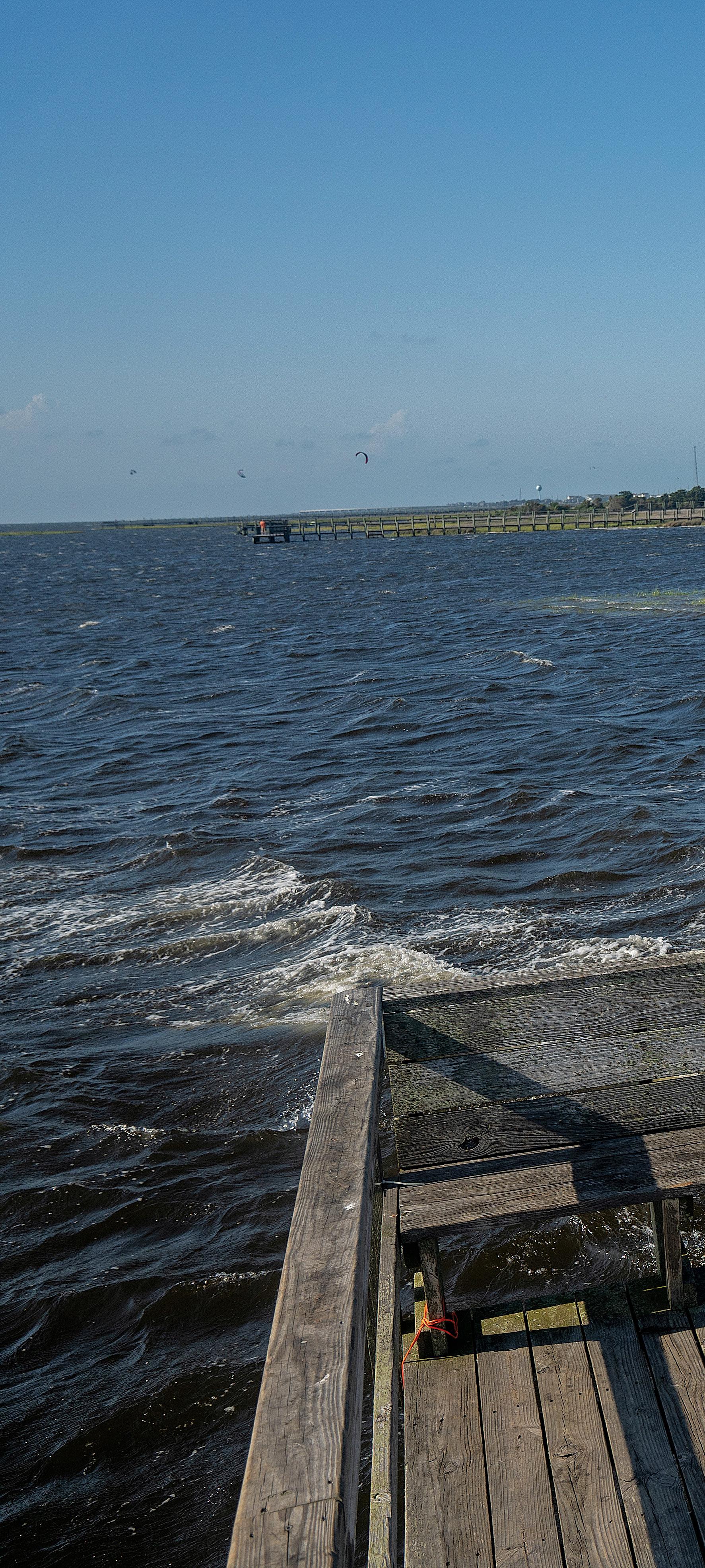
5. Kite Point/Canadian or Wing Hole: Kite point is about a quarter of a mile south of Canadian Hole. This is a common flatwater riding spot for NE wind. Kites stay at Kite Point and windsurfers and now wingers stay to the north at Canadian Hole, which has been recently dubbed Wing Hole as it is one of the deeper sound side areas that works well for winging.
6. Almost anywhere: It’s just too hard to sum up Hatteras in five locations, that’s the beauty of Hatteras Island. There are so many options for any wind direction. All of the ocean side ramps are where you can drive onto the beach, along with tons of private and public sound side access. Pretty much anywhere besides Pea Island, which is the area south of Rodanthe to Oregon Inlet where kiting has been banned by the US Fish and Wildlife Service.
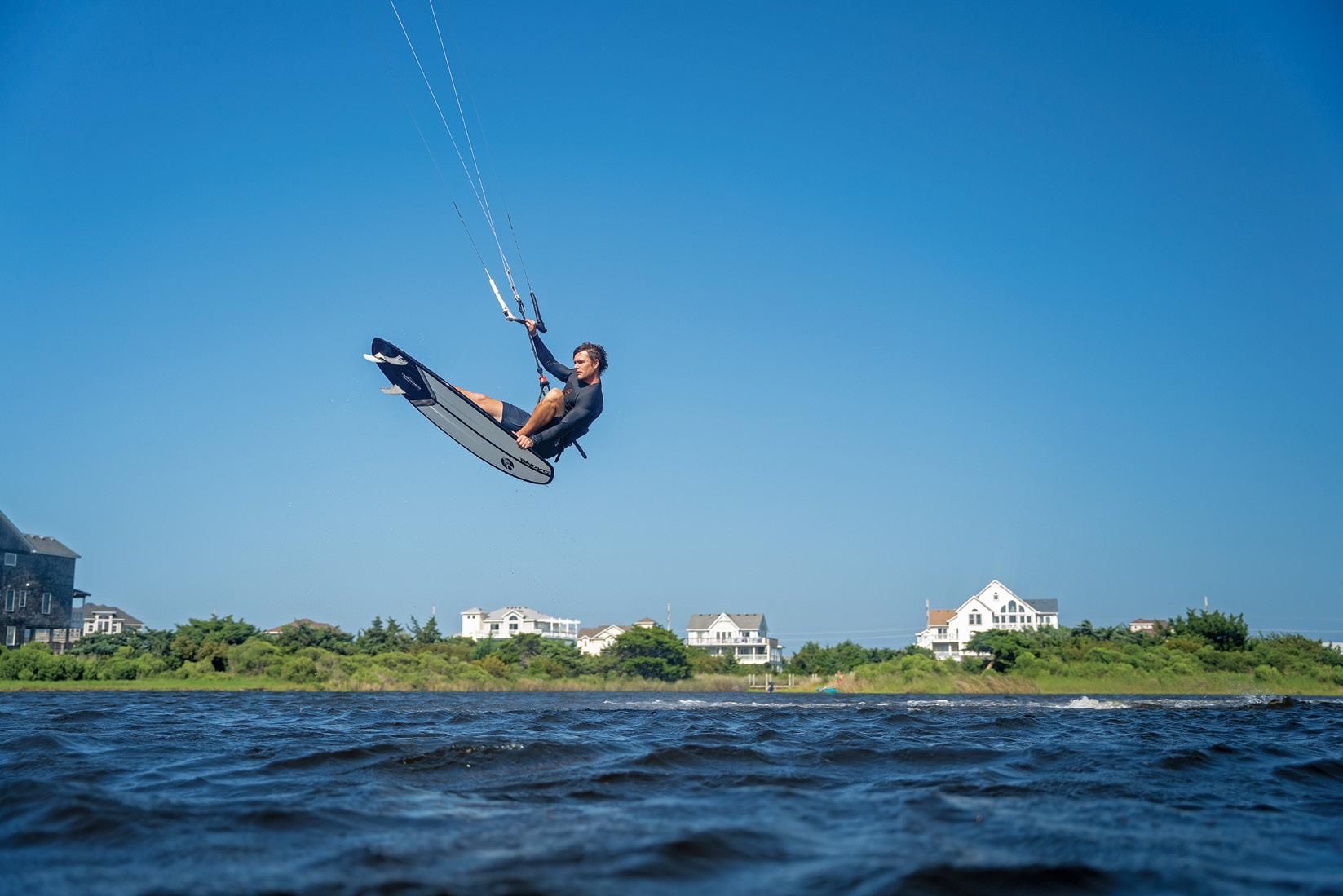
58 - KITESURFING MAGAZINE / VOL 9 / ISSUE 1
Strapped or strapless the flatwater sessions are still world class.

kitesurfingmag.com - 59
Same location, different angel as the shot above, just south of the Slick. You can jump over, next to, or directly onto the dock, the option is all yours.




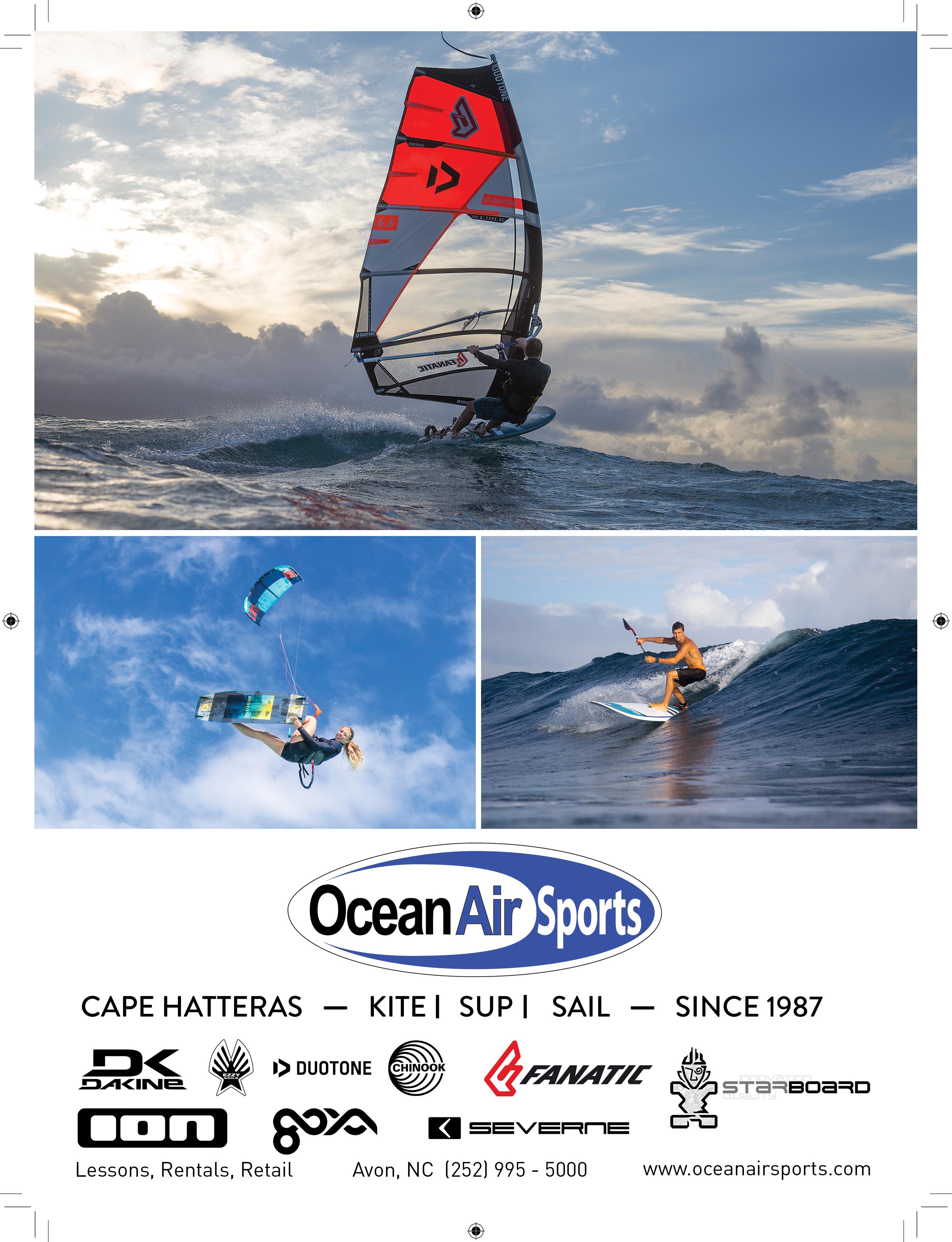



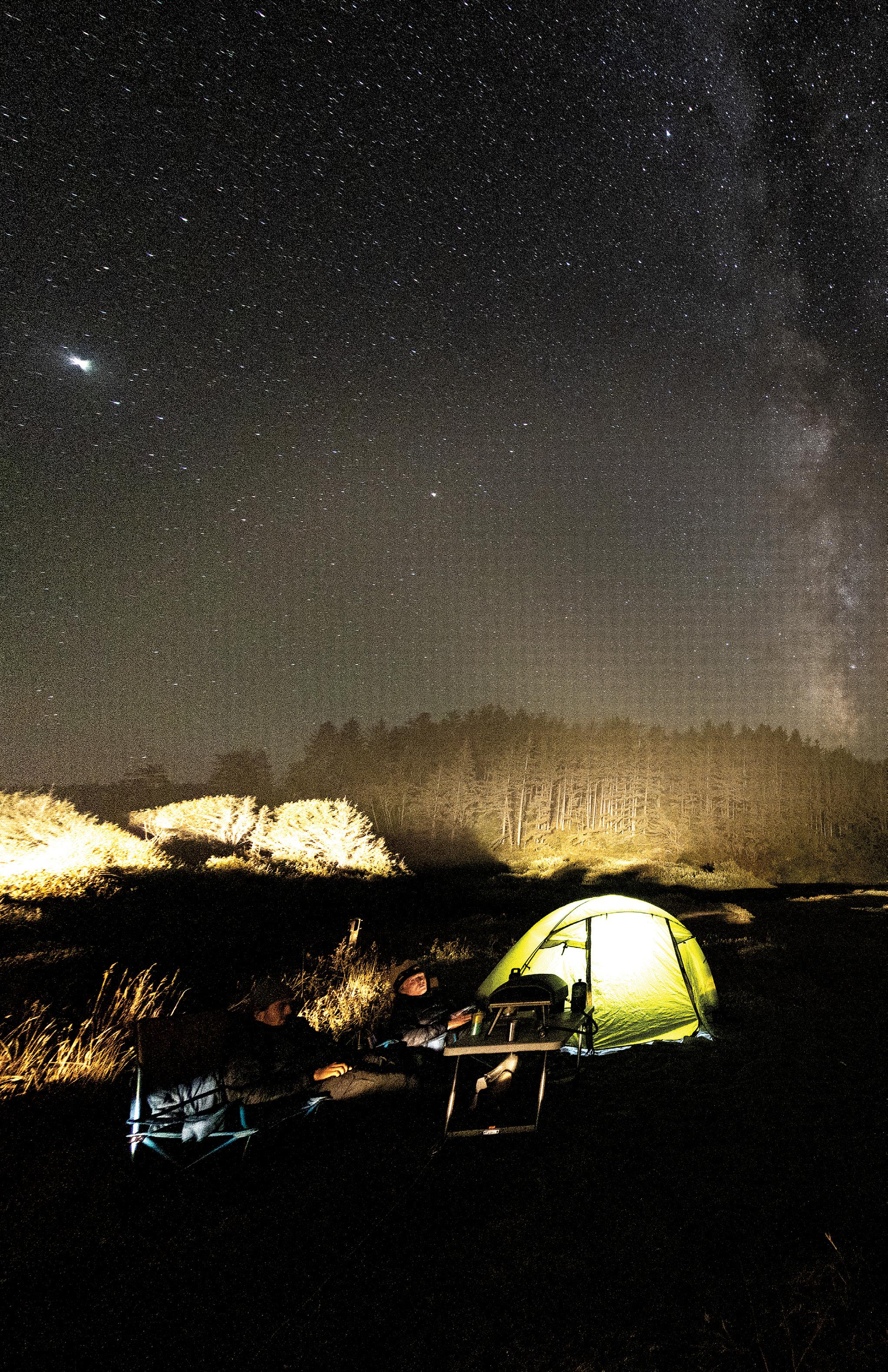

62 - KITESURFING MAGAZINE / VOL 9 / ISSUE 1
When envisioning the Pacific coastline of the United States, California dominates the notoriety of the country’s expansive western coast. California occupies 840 miles of coastline, while Oregon and Washington collectively share over 500 miles of the remaining oceanic real estate. Although these two states may seem shadowed by the populated glare of California, the silhouette that encapsulates Oregon and Washington deserves equal admiration; especially when considered as a kiteboarding road trip destination.


kitesurfingmag.com - 63
WORDS BY XANDER RAITH
A few months back when the opportunity arose to venture west and claim our stake on the Pacific coastline, Noè Font and I loaded our gear into a 2004 Ford Ranger and hit the highway starting in San Francisco, California with no predetermined finish line. Instead of limiting our trip to a predetermined itinerary, we planned to drive north until we felt satisfied or could no longer maintai the nomadic, tent-bound lifestyle. Along with Noè and myself, Toby Bromwich tagged along as the third camper, who conveniently doubled as our favourite photographer.
After setting off and heading north, up the nauseatingly windy Route 101, it quickly became apparent we would likely be the only two desolate individuals to kiteboard many of the beaches and water outcroppings that awaited us. As we distanced ourselves from the city of San Francisco, we also distanced ourselves from the familiarity of consistent wind forecasts and local knowledge. Instead of reaping the comfort that comes from arriving at a recognized kiteboarding spot that bustles with other riders, Noè and I had to use our best judgment and assessment to deduce a spot’s potential. However, one benefit we believed would play to our advantage is the
long-standing stigma grieved upon by most California surfers of smaller swell and onshore winds. Which in our case would more than suffice for kiteboarding, whether it be riding surfboards or blasting off kickers on our twintips. Unfavorably, the stigma did not live up to its reputation; our entire journey along the California portion of the Pacific coastline consisted of stagnant flags and a placid ocean. Although California did not deliver the conditions we hoped for, the scenery made up for any disappointment.

64 - KITESURFING MAGAZINE / VOL 9 / ISSUE 1
"No matter what angle, what lens, or contrasting foreground subject that stands before them, the unfathomable girth and height of California’s redwood trees cannot be justified through a photograph."
Noè Font, Mute Grab Slim in Gold Beach, Oregon. Toby Bromwich photo.
Our passage through and amongst the redwoods will forever be seared into my memory as these colossal towers embody the enormous expanse of California’s state. No matter what angle, what lens, or contrasting foreground subject that stands before them, the unfathomable girth and height of California’s redwood trees cannot be justified through a photograph. Because each tree is surrounded by and adjacent to entire forests of behemoth trees, a photograph makes them look fairly normal, when in reality, these rooted giants are staggering and put our diminutive, short lifespan into transparent perspective.
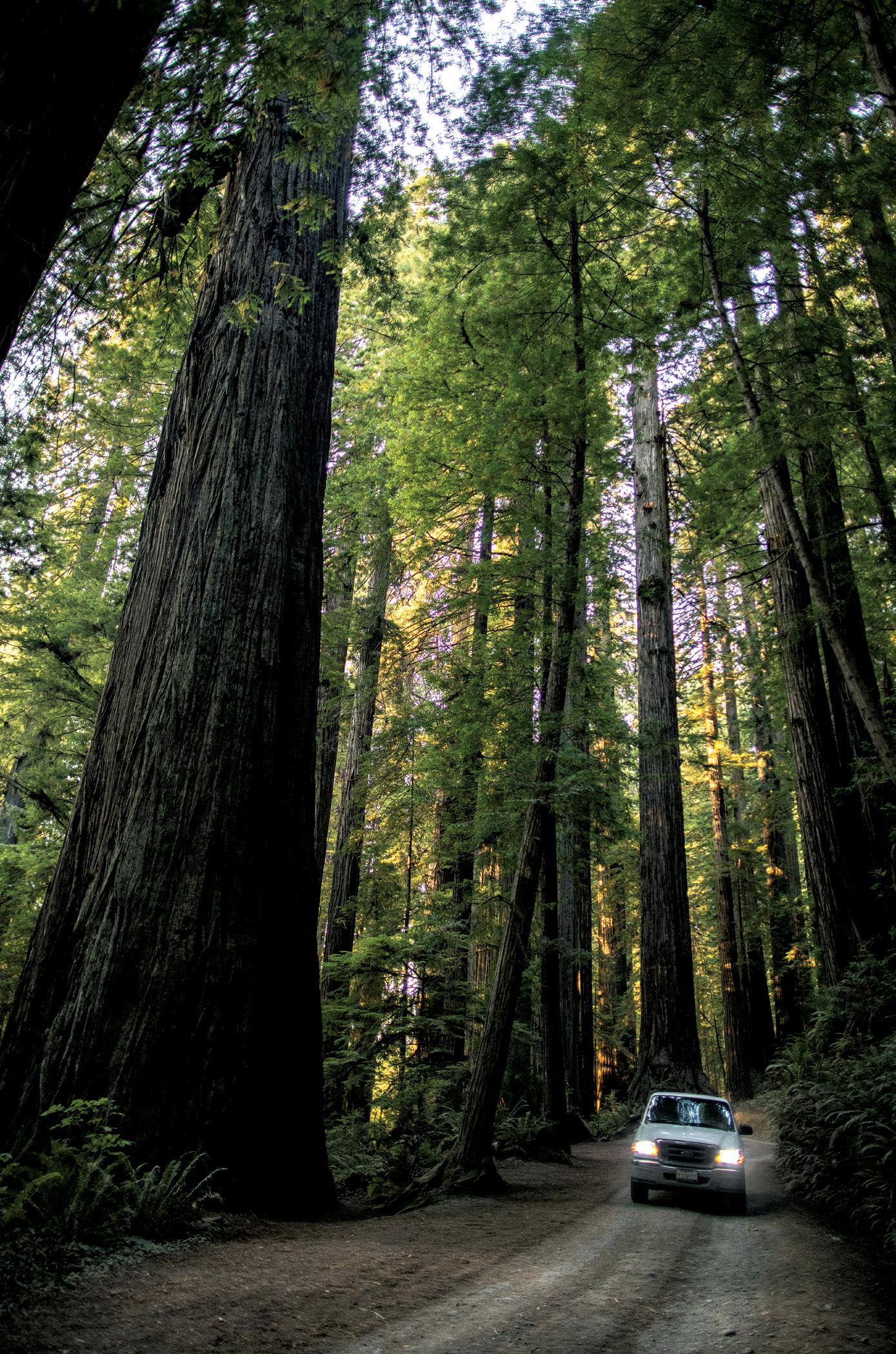
After crossing into Oregon, the air temperature plummeted and the coastal scenery slowly transformed from parched forests and grasslands into thick, mature forests that thrive directly against Oregon’s rugged, rock-strewn coastline. The variation in scenery and weather also introduced a variation in the wind forecast, which slowly increased with every mile we trekked onwards. While the drop in temperature was a pleasant improvement during the heat of the day, regrettably, it also completely altered our camping situation, testing our tolerance for sleeping in a tent. After our first kite session in Oregon, wearing our 6.5mm ION wetsuits (which otherwise, I only use when snow begins falling on beaches), we pitched our tent a few hundred yards from where we emerged from the water and cooked pizza while watching the sun sink into the ocean. As picturesque and enticing as this scene and the initial experience was, as the day vanished, so did our last night of comfortable sleep. Prior to our departure, Noè and I would have claimed we were prepared and more than capable of camping. Oregon defeated our inexperienced assertions. The nights that ensued tested our tolerance to camping, as well as our overall well-being. After a long day in the cold Pacific waters of Oregon, sleeping in a tent that collected so much condensation from our breathe combined with heavy fog, and our close proximity to the wet reach of the ocean, we would wake up in the middle of the night in drenched sleeping bags. We were cold, wet and sleep deprived for the next week.



kitesurfingmag.com - 65
Ford Ranger looking diminutive amongst the redwoods.
Noè Font paragliding into the sunset in Cape Blanco, Oregon.Toby Bromwich photo.
Chillin'.
Although camping was not as glamorous as the photos may appear, sleeping on the beach allowed us to have a constant and accurate pulse of the current conditions. Even though Noè and I packed the truck to the very brim with every piece of kiteboarding equipment one could imagine, the one kite that was used the most was Duotone’s light wind D/LAB Juice with Aluula technology. Never on any kite trip have I ever been so thankful or impressed by a single kite. On most kite trips, we will siphon through an entire quiver of kites, but on this road trip, the mind-blowing capabilities of the 13-meter Juice dominated every session due to the aggravatingly consistent soft breath of coastal wind.
Despite the light breeze, we rode in a plethora of different conditions and locations, varying from dodging monoliths while riding punishing waves to sliding on fallen trees in shoreline tidal pools. The diversity between each location was enormous and the differentiation helps illustrate the potential of the more remote regions of the Pacific coastline.


66 - KITESURFING MAGAZINE / VOL 9 / ISSUE 1
Noè Font stretching his legs in Cape Blanco, Oregon. Toby Bromwich photo.


 What we thought was a wave crashing into a rock was actually the blow-spout of a humpback whale just beyond where we were kiting. Port Orford, Oregon. Xander Raith photo.
What we thought was a wave crashing into a rock was actually the blow-spout of a humpback whale just beyond where we were kiting. Port Orford, Oregon. Xander Raith photo.

68 - KITESURFING MAGAZINE / VOL 9 / ISSUE 1
When the trip drew to an end, both Noè and I contemplated whether we would be interested or even willing to do it again. Without hesitation we each agreed that we would. Although we might consider altering our sleeping situation, the coastline of California, and especially Oregon, introduced a sense of both isolation and exploration. While the entire Pacific coastline has been journeyed by many coastal dwellers and curious passersby, its vastness introduces a pioneering spirit. Besides our jaunts to markets to replenish food supplies for the most part, we were very alone and able to experience nearly every night’s sleep, kiting session, photograph, and coastal experience in solitude.
For most who travel up or down the famed Highway 101, the view from the car window is enough to satisfy their coastal curiosities. However, few travellers likely experience the prospects this stretch of ocean has to offer.


California may forever remain the pillar of social stardom and intrigue of the Pacific coast, but just a few hours north and across the border into Oregon, crowds dissipate, forests flourish, and kiteboarding becomes an endless pursuit. Thank you, Highway 101. We shall meet again.
Sincerely, Xander, Noè and Toby.
Noè Font poking a Stalefish during one of our light wind sessions. Gold Beach, Oregon.
kitesurfingmag.com - 69
Toby Bromwich photo.



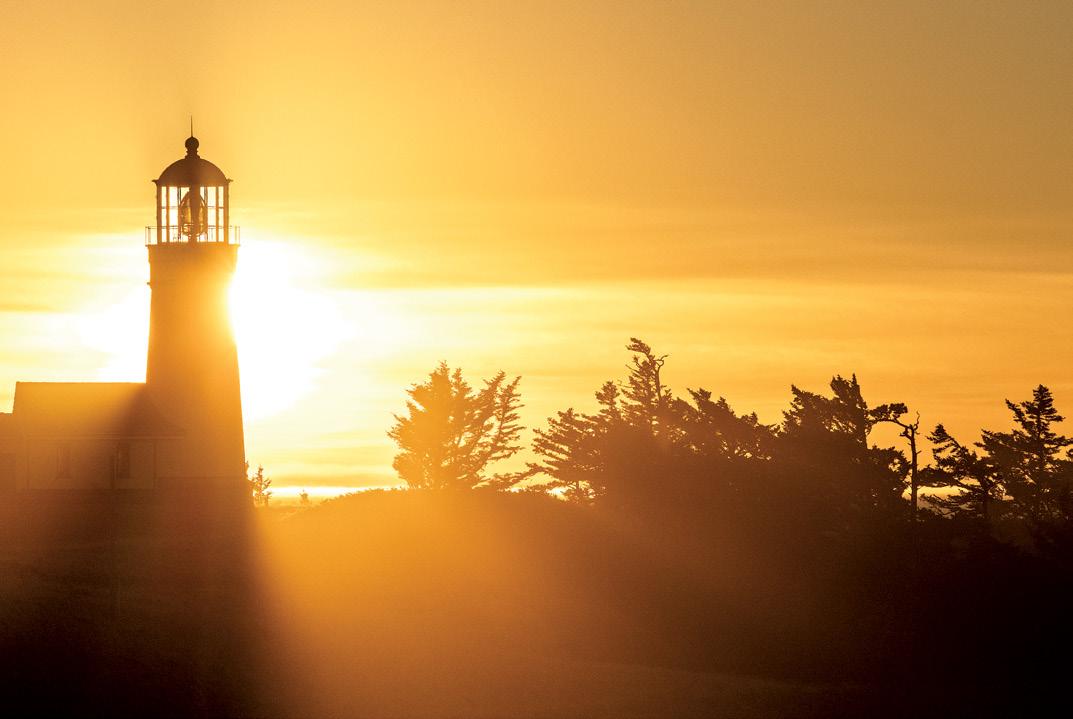
70 - KITESURFING MAGAZINE / VOL 9 / ISSUE 1
Xander Raith Frontside Indy in front of Oregon’s remote coastline. Curry County, Oregon. Toby Bromwich photo.
Curry County, Oregon. Toby Bromwich photo.
Xander Raith in Cape Blanco, Oregon. Toby Bromwich photo.


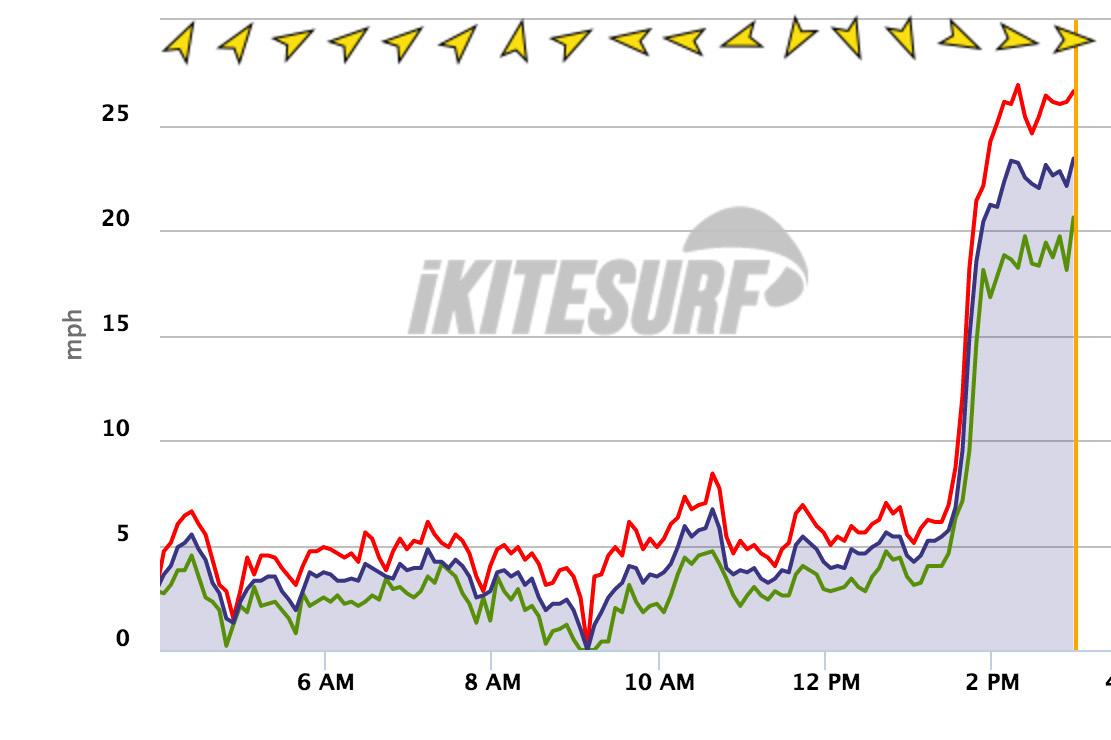

Keep your eyes on the prize. Keep your eyes on iKitesurf! Exclusive Content The best Weather Stations and Forecasts available anywhere! iKitesurf!
Rider-Eric Rienstra, Photo-Mike Phaneuf
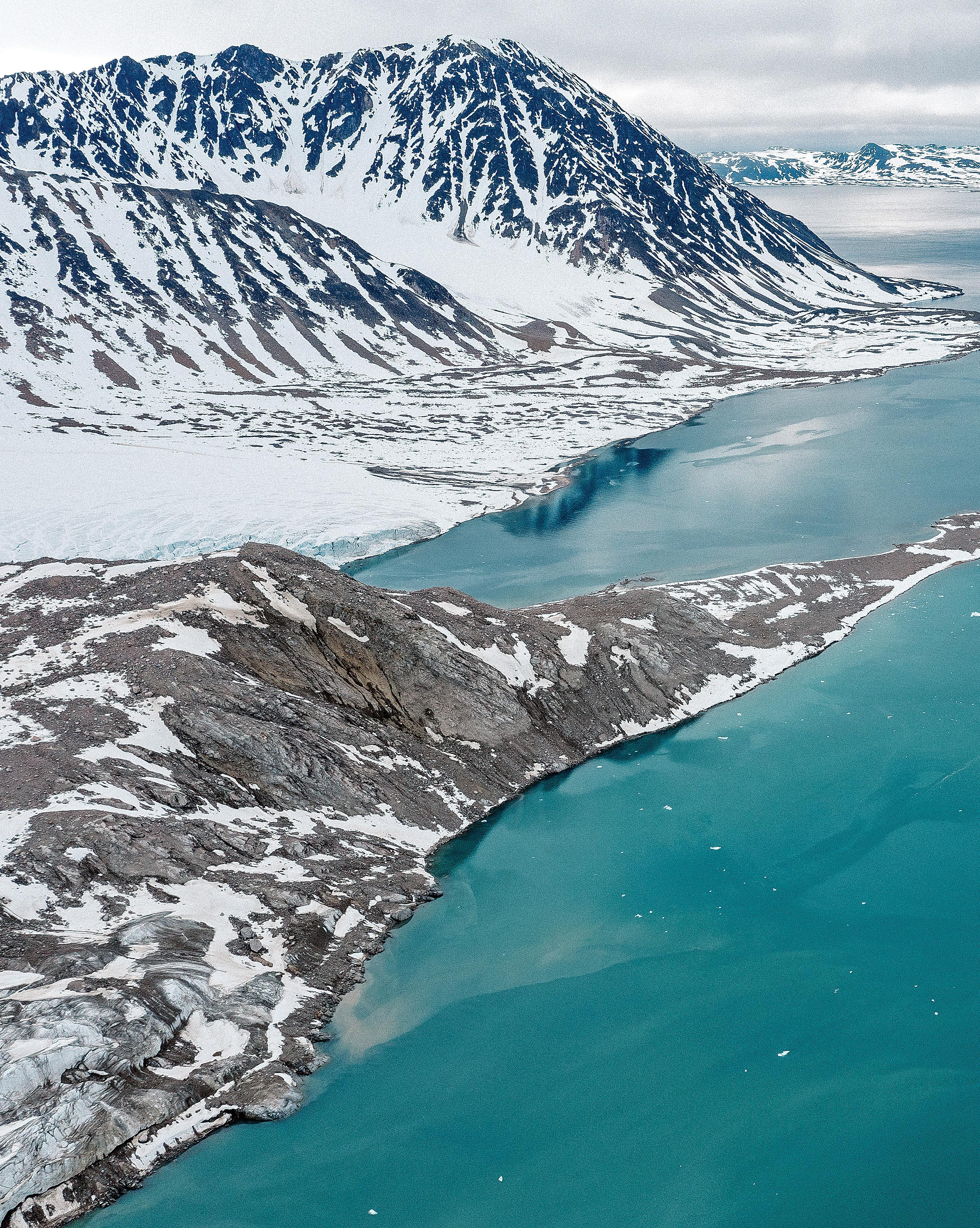
Norway 72 - KITESURFING MAGAZINE / VOL 9 / ISSUE 1
North
Words by Paul Serin photos by Matt Georges
North of Norway

The D-day is approaching, and my excitement is through the roof. This trip was two years in the making, and it is finally happening. I'm increasingly worried of forgetting something, so I'm making lists of all the gear I need. I've previously gone on trips in cold places, but I’ve never done anything like this. To tell you the truth, I still have a hard time comprehending where we are going.

A documentary is running on my computer while I continue packing. Base layers, ski socks, ski gloves? Do I really need ski gloves? Rather than ask, I take them. Just in case, as they say. That’s something I said with just about every accessory I added to my bag, on top of my winter jacket and ski pants.
Where exactly are we going? To Svalbard, an archipelago located north of Norway. The islands range from 74° to 81° north latitude. Keep in mind that the Arctic Circle is very close at 66°30’ N. The people I talk to don't really realize where it is, and I don't think I do either. I don't go into details when they ask, "So, Paul, where is your next trip?" I just reply, "On an island north of Norway," and let them imagine what they want.
kitesurfingmag.com - 73
Like every trip I've been on since I started kiting, there are many boardbags involved. With Manera photoshoots, there are always a lot of them, and the airlines must truly hate us. But you don’t want to leave it up to chance on a trip like this. You have to be ready for anything. I don’t know what scares me the most: the cold, or the idea of spending 12 days on a boat between the Greenland Sea and the Barents Sea.
The trip starts with a stop in Oslo, the Norwegian capital. We wait for the whole team to arrive before leaving for Longyearbyen, the “biggest” town on Svalbard with around 2,500 inhabitants. Our pit stop here feels a bit like a decompression chamber before the real cold, and the real adventure.
As for the riders, Mallory “Mallo” de la Villemarqué and Matt Maxwell are coming for strapless kite and wave, and Fernando “Mizo” Novaes for surf foil and wing. In the media team, Olivier Sautet is our videographer and Matt Georges our photographer. Anthony Lietart is there as well to film everything happening backstage during the trip. And of course, Julien Salles, Manera’s boss and without whom none of this would have been possible, oversees the trip. And finally, there is me, Paul Serin, mainly for twintip and freestyle, and some wing foil.
Our arrival in Longyearbyen does not go unnoticed. The other passengers on the plane think we are scientists because of all our big bags. When we explain that we are here to kite surf, their eyes widen, showing both astonishment and compassion. Yes, we will kitesurf in one of the most extreme and northern places in the world. Just writing these words gives me goosebumps.

For the next two weeks, our floating house is called Kamak. She is a 25-meter-long boat coming from Paimpol in Brittany. She normally hosts ski trips between Svalbard, Greenland, and Norway, but this time, the action will take place on the water and not in the mountains.
With the crew, there are 11 of us in total. Stress is starting to build up. Are we going to get along well in such a small space for 12 days?
Gaby, the captain, manages his boat perfectly. We also understand quite quickly that he is a little bit obsessive when it comes to tidying up. I personally don't have a problem with that, but with 20 boardbags, cameras and all their chargers, it can get out of hand pretty quickly. He is assisted by Jean, a young Breton sailor used to the cold and expeditions of this kind. Last but not least, Minh is the cook. Despite his shyness, he will be the decisive asset of this trip and responsible for the good mood of the group.
The boat is almost ready to go. I help Minh with the last shopping trip to the supermarket. We are about to leave for 12 days at sea in total autonomy, far from everything and without mobile network. Just us and the grandness of nature.
Finally, we cast off and the real adventure begins. We are heading straight north. We all gather next to the captain's screen to try to figure out exactly where we are going. Our first stop will be just outside the Longyearbyen Fjord, where we will have our first session.
I step out onto the deck and look around. The air is frigid on the only part of my face that isn't

74 - KITESURFING MAGAZINE / VOL 9 / ISSUE 1
For the next two weeks, our floating house is called Kamak.
She is a 25-meter-long boat coming from Paimpol in Brittany. She normally hosts ski trips between Svalbard, Greenland, and Norway, but this time, the action will take place on the water and not in the mountains.
Strapless expert Matt Maxwell.
The Manera team getting their sea legs.
covered, but my eyes are amazed at the scenery. The sun is out on this first day. I have a hard time wrapping my head around the fact that it never sets at this time of the year. After three or four hours of sailing, we finally arrive to the first spot. The wind blows gently, the area looks clear, all lights are green.
Another important detail to mention is that on Svalbard, there are about 2,500 inhabitants for 3,000 polar bears, so the chances are high for us to see one. Of course, our goal is for that to happen while on the boat, and not on land while inflating our kites. The groups of skiers who usually come here are always accompanied by an armed guide to protect them in case of an attack. Our only defense tools are a flare gun and binoculars. Before
we land on any beach, we have to scan the horizon to make sure there are no big, white fur balls around.
The first session starts slowly. I put on my 6.4 hooded wetsuit and my 5mm booties without forgetting my pair of gloves. It is impossible to start with a kite from a sailboat because of the shrouds and the limited space. However, Mizo can easily take off with his wing, so he will be the first one in the water.

I get into the dinghy with Mallo, and Jean takes us to the beach. The landing area is slightly below a small hill, so we can't see if anything is up there waiting for us. As soon as we set foot on the ground, Mallo and I instantly look at each other, the same idea obviously having crossed our minds. We sprint up the hill to see what's
above us, brandishing our kite bars and screaming, driven by a surge of fear.
No white-haired animal is waiting for us up there. On the other hand, reindeer antlers and the immensity of nature are. Once the adrenaline rush is over, we get into the water. It is cold and the wind is light, but the sun feels so good.
I take my time to ride and enjoy the landscape. I feel like an ant in a world of humans. The mountains are high and steep, and the plains stretch as far as the eye can see. I also imagine the potential animals that could be underwater in such a remote corner of the world. But as soon as these thoughts cross my mind, I immediately turn around to get closer to the boat.
The first session in a trip is always quite special. It sets the tone
and prepares us for the rest of the journey. Getting out of the water, I dread the moment where I’d need to take off my wetsuit. Fortunately, my body is still relatively warm so the transition from wetsuit to poncho is not so bad.
Ten hours of navigation are now ahead of us to reach the north of Svalbard and exactly the 79th parallel north. The headwinds force us to turn the engine on to keep moving forward. But one of the advantages at this time of the year is that there will be no night sailing, as it is daytime 24 hours a day.
The first dinner is joyful. It’s a treat to eat Minh’s dishes, which he also makes in great quantity. With this group of hungry guys, it is something crucial to keep in mind. I however can only swallow a bit of soup before the boat starts
kitesurfingmag.com - 75
Brazil's Fernando “Mizo” Novaes on the hand kite.
swaying again. I decide to leave at once to lie down in my bunk.
A few hours later, the noise of the anchor chain briefly wakes me up. It is only midnight, but the boat is not moving anymore. It’s calm again. I later find out that we still have a long way to go, and that we would not ride that day. The goal is to reach the northernmost point of Svalbard and then sail around this region depending on the wind.

The cellular network has left us for good. Strangely enough, we all suddenly feel closer to one another. No more phones vibrating on
the table during meals, nor "Wait, I'll check on Google if it's true." We are back to the essential: us, the boat, the trip.
We try to fill this day as best as we can with meals, card games and a long nap. I force myself to go out from time to time to appreciate the landscape, but the temperature is bone-chilling, and my eyes immediately start watering. The air reminds me of a day of skiing in the Alps, so cold and dry that my throat freezes with every breath.
We make headway little by little, but our current GPS point always
feels so far away from our destination. We end up sailing for 15 hours instead of 10. A wave of relief washes over us when the captain announces that we have finally arrived. On the map, we can see the beginning of the sea ice which is only a few kilometers away. The GPS indicates the long-awaited 79 North. It hasn’t really hit me yet; I just know that we are very, very far up north.
The hours don’t really have any value anymore. I put my watch away in my bag. Only meals punctuate our days. It's been a week
since we left our homes. But apart from a short session on the water, not much has happened. Even though we all know that it's part of the game on Manera trips, it's still hard to look to the future especially in such a cold and hostile place where the wind forecast changes every two hours.
We are now anchored in a fjord that should get some wind by the end of the afternoon. Matt and Olivier check if there is a beach from where we could easily take off from. The one they thought was ideal is in fact the napping spot of
76 - KITESURFING MAGAZINE / VOL 9 / ISSUE 1
The video documenting this expedition has accumulated more than 140,000 views, primarily due to the inclusion of ominous and icy footage like this.
a polar bear. Obviously, we decide to change spots and go for one a bit further away, and without any land connection with the previous one.
Seeing their sparkling eyes, it’s obvious that observing a polar bear seems to be a unique experience. I'm so looking forward to it. Meanwhile, Olivier has spotted a perfect freestyle spot, sort of a deep puddle inland where the wind seems to come in well. It's my time to shine.

It's been almost six months since I've done any unhooked freestyle, and I’m getting a bit nervous. I gear up inside the boat. Outside the sky is grey. I think it's 11:00 but it's really 17:00. Freestyling in this cold is quite the ordeal, but Olivier is counting on me. This year Maxime [Chabloz] is not here, so I'm the only one who can do some tricks for the video.

When I finally arrive on the beach, I discover a pool of fresh water surrounded by ice, perfectly in line with the wind. A dream. The only problem is that the temperature will not exceed 3°C. It’s important to note that it is also impossible to put on neoprene boots and then fit into the freestyle boots. I must be barefoot.
I head to the water, and to my surprise there are a bunch of walruses sleeping on the other side of this small lake. I don't feel like I'm disturbing them, so everything is fine. The cold pierces through the neoprene, and my feet and fingers are quickly numb. All my tricks are still there, and I land everything I planned to as if I were riding in Brazil in 25°C. Sure, it's nothing crazy and a lot of simple handle passes, but it's hard for me to do much more.
Olivier looks happy, especially with the alignment of my jumps with a huge glacier in the background. It’s unlike anything we’ve seen before. I keep going for as long as I can. My feet have turned into two bricks and have
We try to fill this day as best as we can with meals, card games and a long nap. I force myself to go out from time to time.
Locals only.
been hurting for at least 20 minutes. I can almost feel the frostbite coming. However, and more importantly, I now remember how much I love freestyle and how much I miss it.

I signal to Olivier that I can't do anything more. He's not surprised, but tells me anyway, “That was totally stylish, man.” Jean arrives with the dinghy, and we pack everything up. On the way back, Gaby warns us on the radio that the bear from earlier today is walking around nearby. We get as close as possible while keeping our distance so as not to disturb it. I am frozen from the session, but I don’t even think about it. We are in front of a polar bear.
This animal is so mythical. I think back to all the books I read as a child but also to all the images and documentaries I’ve seen on it, and on its natural environment that is disappearing because of us and our actions. And then there is the present moment when we, humans, are face-to-face with it.
I have mixed feelings. On one hand, I feel guilty for seeing this bear, for being here. I feel like I'm looking at a living work of art that nature has created without permission. On the other hand, I see this living being staring at us and looking anything but unhappy. We must do everything to ensure that these bears do not disappear. Our generation and future generations must protect this more than anything else. Our children must be able to talk about polar bears in the present tense, and not in the past.
That night, I hear the wind blowing incessantly through the halyards. I'm looking forward to doing

big air here, and Matt and Mallo even more. We return to the same spot as the day before, and we split into two groups. At the beginning, my role is to be on polar bear watch and to ensure they don’t approach us or come too close. Tricks are landed one after the other as we are all enveloped by the cold and the dullness of this seemingly never-ending overcast weather. That said, I am under the impression that we are getting used to that.

No bears on the horizon. After more than an hour, I start to pump up my kite. The wind is not as strong as I thought, but it will do. The walruses are still there, unconcerned. They sometimes show their big teeth when we pass by. It is quite surprising, but I think they are just curious and a little startled to see humans gliding on the water. It must be said that they are, with the polar bears, the only wild animals that we have seen since our departure. This place is so extreme that even animals don’t want to live here.

It's my turn to go in the water, but the wind is a bit too light to really jump high. With Mallo, we spot a drifting iceberg on the other side of the channel. Just like our little adventure on the beach during the first session, we look at each other and immediately rush to see it. The drones get ready and follow us, but it is farther than we thought. If something goes wrong, it would be really complicated to come and get us. Everything will be fine; I tell myself several times. When we finally get there, we discover a piece of ice of a midnight blue color, and of a much bigger size than anticipated. We are both a little impressed, but
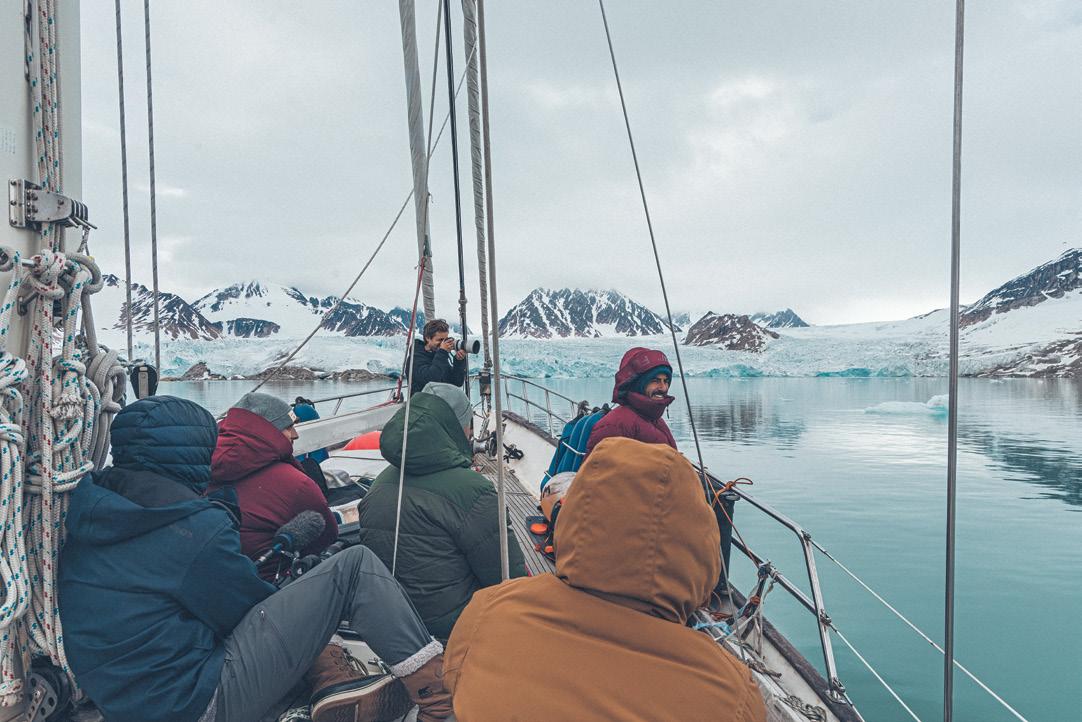
78 - KITESURFING MAGAZINE / VOL 9 / ISSUE 1
Color co-ordination at its finest.
Anyone want to go for a swim?
we still try a few tricks around it. Until a piece comes off, and the whole iceberg starts to rise. My heart races as I can already picture both of us stuck under it in frozen waters. A few minutes later, it has visibly and thankfully stabilized. We do a few more small jumps, but eventually decide to head back before it gets bad or the wind drops.
By the time we return, the wind has picked up a few knots, and we continue riding for a little while longer. No one is watching out for bears anymore. Everybody is absorbed by the riders and how to get the best possible angle. Back on the boat, Gaby is not happy. According to him, we took too many risks. Julien is of the same opinion. In hindsight, it’s true that the situation could have turned out badly. Every-
thing however ended well, and that's the main thing.
I've always loved to travel, to see the world, and to gain new perspectives. We are all modern-day globetrotters here. With our boardbags, we roam the world in search of new sensations, different conditions, or maybe even other things. No one really knows.

As Nicolas Bouvier says so well in his book The Way of the World: “After all, one travels in order for things to happen and change; otherwise, you might as well stay at home. Traveling outgrows its motives. It soon proves sufficient in itself. You think you are making a trip, but soon it is making you - or unmaking you.”
That's exactly what we just experienced. It started with a trip and ended up being so much
more. A human adventure, or a trip with friends in the Arctic Circle, call it what you want. In the end, it doesn't really matter. The important thing is to come back.

Gaby, Jean, and Minh will leave for another expedition while we will resume our normal lives. Our houses will be the same as we left them, but we will all return different.
Thank you Manera and Julien for this interlude in our lives. It was magical.
kitesurfingmag.com - 79
Article writer Paul Serin with some twin-tip action.
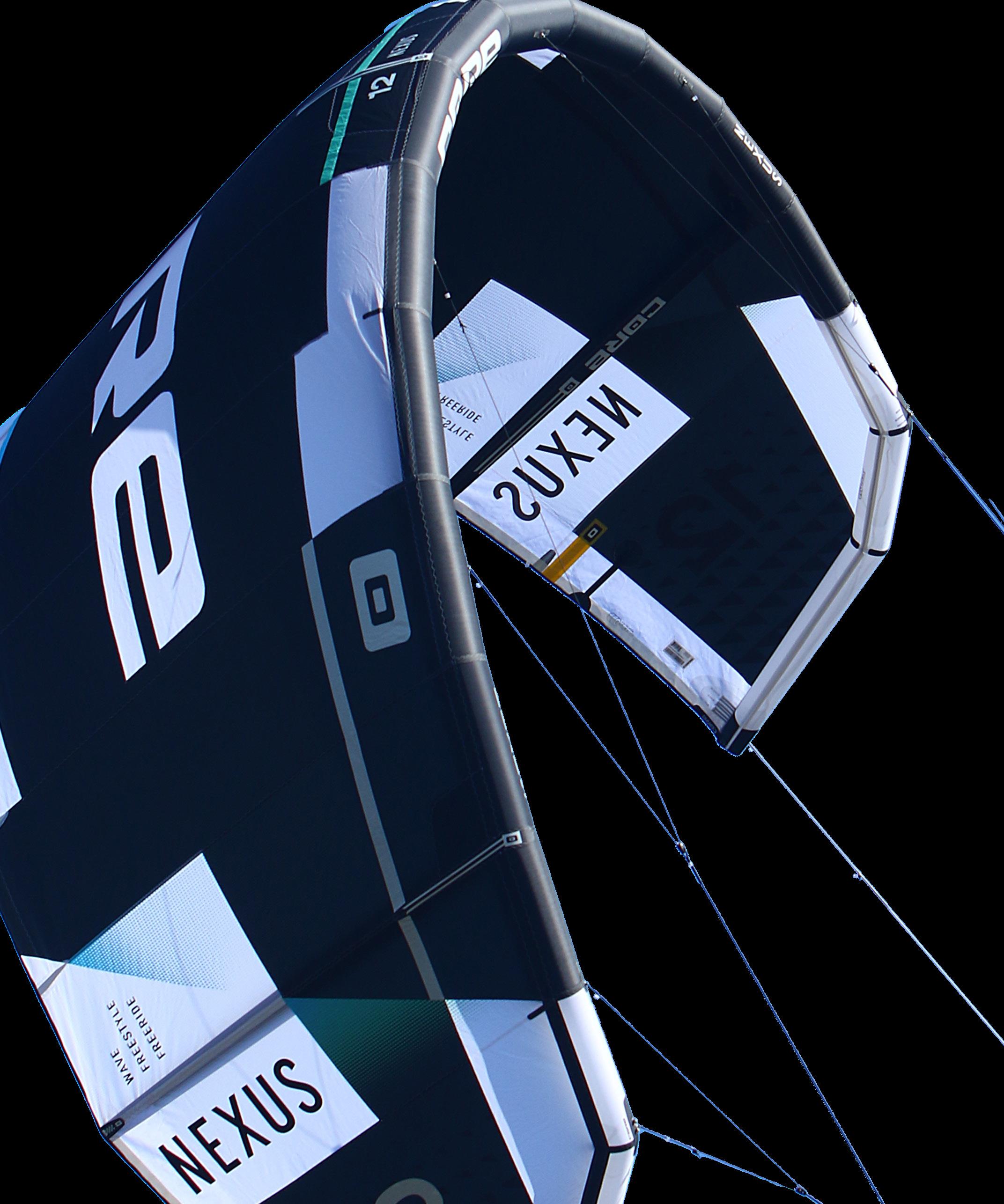
80 - KITESURFING MAGAZINE / VOL 9 / ISSUE 1
Kite Performance Evolution
Lighter, Smoother, Faster, Stronger, Better!

The evolution of kite performance continues with improvements in overall wind range, power efficiency and handling in many of the 2023 models. Kite designers and their development teams are constantly experimenting with ways to improve performance and over the past few years there has been a major trend to adopting new materials making kites lighter, stronger and more rigid. Lighter kites improve certain flying metrics. The lighter kite is more efficient and generates more power with less wind pressure. Lighter designs can also generate more lift and hang time and can relaunch from the water easier. They hang in the air better and can be directed with more precision in underpowered conditions or when the kite experiences less line tension. This slack line float is essential when riding waves or foiling as the kite needs to be able to drift under low line tension as the rider links turns or runs towards the kite
Big Thanks to Watermen’s Retreat
during transitions. A lot of brands are adopting upgraded versions of the traditional woven Dacron to achieve better weight and performance and a few brands are adopting the use of entirely new ultralight and also more expensive framing materials with some high impact results. These new materials offer greater degrees of strength and rigidity which makes their frames more stiff and subsequently more reactive to steering input. Some of the developments in seam technology have forced functionality in other areas to allow for more flex and twist because kite frames and canopies are becoming so rigid that some of that twist flex is needed. Kite designers are also finding ways to improve their kites using existing materials by employing smarter engineering with tweaks to seams, panel layouts and bridle configurations. Whether material upgrades or tweaking shapes, profiles, wingtips and seam alignments, all of these new
models are more dialled than ever for 2023. There are also a lot of new control systems with nice upgrades to the quick release trim loops and trimming systems as well. Most brands have developed the seatbelt style, single-handed reassembly and many have the auto line untwisting features and easily removable trim loops for different ridings styles. For anyone that is still using an older generation control system, it’s a great time to upgrade and many kite bars are compatible with any brand. Overall this is a great year to test out some new models and expand your flying skills and riding experience. In this round of the Kitesurfing Magazine test session there were three categories of kites tested. The freeride all around category is the largest of the grouping followed by a trio of big air kites and capped off with a pair of high-performance wave kite models.
While in Cape Hatteras, NC, the Kitesurfing Magazine test team stays at Watermen’s Retreat. The sound front accommodations and an expansive backyard, complete with air compressors, offers an ideal location for testing a diverse range of gear. The massive Real slick, just a few hundred yards upwind provides perfect butter-flat conditions, the foil garden has enough water depth for riding foils even during low tide, and just across the street, miles of ocean down winders await for some of the US east coast’s best surf sessions. The Watermen’s Bar and Grill located on-site helps maximize time on the water, and sunset celebrations on the deck are a great way to wrap up a full day of riding.
kitesurfingmag.com - 81
Freeride All Around : Naish Pivot S27, Reedin SuperModel HTF, Cabrinha Moto X, Core Nexus 3
These models fall into the industry’s largest kite category and they have the flying qualities for a range of kite disciplines from freestyle to wave riding, to freeride foil and big air. Starting with the legendary Naish Pivot S27, this kite has been a leader in this category for many years with its solid handling, wind range and explosive lift. The handling on the Pivot S27 is renowned for its smooth power delivery, balanced drift and predictable pull through its reliable pivot turn. The Pivot S27 is a kite that works for waves and foiling but also offers incredible lift and hang time and doubles as a big air kite for the advanced rider that can push the limits. The great low end combines with even more upper end wind range this year allowing for a compact quiver. This version of the Pivot has more subtle changes than the others in the group with some additional bridle attachment points on the leading edge and some canopy seam alterations that give the kite more control in the upper wind range. The other three kite models in this category have more formidable alterations from previous versions and offer some nice advancements in handling and performance for 2023. The Reedin SuperModel HTF, has evolved with some innovative changes that improve the performance in
turning speed and smooth power delivery through the turn. New for this year the SuperModel HTF incorporates their new high tension frame which uses some lighter weight Dacron in sections towards the leading edge. These sections work along with more narrowed out struts to enable the kite to twist better which enhances the smooth pull through the turn and quickens the SuperModel HTF's reactive steering. The smooth pull and control through the turns is really next level and the lift and the jumping ability of this kite is phenomenal as well, making the SuperModel V4 a real standout this year. As one of three all new models launched in 2023, the Moto X showcases Cabrinha’s new materials and upgraded shapes with impressive results. Compared to the last version, this new Moto X follows the similar three strut hybrid platform but it feels quite a bit different with a lighter, crisper feel in the air, faster turn initiation and better lift for jumping. The Moto X was one of the easiest kites of this group to boost some big air with, with nice light feel to it and lots of easy to access lift and hangtime. The new pulley free bridles give the Moto X direct feedback and this kite has nice light touch steering compared to older versions. Overall the upgrades to the canopy and
Big Air Freeride: North Orbit 4, Ocean Rodeo Flite A-Series, F-0ne Trigger
The big air freeride kite category continues to expand in 2023 with some new models and new materials and technology driving them. The dedicated big air kite typically features higher aspect ratio in their canopy shape that’s supported by five struts. The extra support through the flatter arced and narrower canopy, keeps thing solid under more load which really lets these big air kites excel in overpowered conditions. Ultimately these five strut kites maintain structure through heavier loads and higher levels of driving power. The North Orbit has been leading the big air kite resurgence and in its fourth iteration it gets the right upgrades and tweaks to keep it on the leaderboard in this category. The North Orbit 4 uses a new version of Dacron material in their leading edge and struts and they are also employing a new lighter inflatable bladder to shed some weight. The reason the North Orbit 4 is popular is it has a great blend of direct feel and quick response along with that explosive boost and great glide. It may not be the easiest kite of the group for the less skilled, but its ability to react, loop, turn and perform at critical times, give the rider confidence to control the kite in overpowered conditions and land safely from epic heights. It’s also great for anyone that finds they are riding in windy and gustier conditions where having that extra handling in the upper wind range is ideal. The Ocean Rodeo Flite A-Series has expanded
with more sizes this season and the range includes a new five strut design in the smaller sizes. These new smaller sizes with the full support of five struts, adds to the big air capability of this popular model. Equipped with Ocean Rodeo’s Aluula Gold material in the frames the Flite A-Series 10 meter is insanely light. The light structure enhances the float and relaunch capability and gives it an edge in the lighter winds over its rivals. In fact this is one big air kite that can also adapt to foiling or surf riding, because the ultra-light frame adds to its float and drift capabilities. The five strut 10 meter is lighter than many three strut kites which gives the Flite a nice combination of three strut handling capability with the structure and range of big air, five strut design. The F-One Trigger is another user-friendly big air kite that has that added touch of control and reactivity that can be lost in the flatter, higher aspect kite designs.
F-One is known for high quality builds, but so far they have opted away from the expensive and exotically light material. The new designs for 2023 are still finding innovative ways to increase performance with their sail engineering philosophy. F-One’s latest innovation found in their newest designs are the staggered seams in the trailing edge. Although it may seem minor, this innovation keeps the Trigger canopy more tensioned and precise when the kite is loaded with power. Having more control in extreme situations is key for any big
Freeride Wave: Eleveight WS, Duotone Neo D/LAB
The freeride wave category is one that can be overlooked but these two modern wave kites are also quite versatile and have performance beyond the waves for any skill set. The wave kite has qualities that endear it to riding waves but many of them are also great for freeride foil riding. With easy water relaunch and low pull through turns, they are also user friendly and can double as beginner kites. The Eleveight WS has some great performance advancements from last year’s version to make it even better in the waves and more versatile for riding your foil. With tweaks to the sweep and wingtip shapes and elimination of pulleys in the bridles, the WS feels direct and has more smooth pull through the turns in this version. Eleveight has also made some increased performance by shedding weight with lighter
PU bladders in the leading edge and struts. The WS is very well balanced, with great drift capability and can disappear on the wave but reemerge to smooth pivot and power up to get you out of the impact zone and back for another hit. The light touch steering will be appreciated in the waves and on a foil, as the kite pivots quickly and easily and has low power and smooth pull through the turn. Overall, great improvements to the Eleveight WS give it top marks for surf or foil board riders that want that quick pivoting, high performance, wave-oriented kite. The Neo D/LAB is one that shows the most breakthrough levels of performance of any kite in this test. It represents the ultimate in new age materials, with Aluula Gold material in the frame and the Hybrid Flex Struts. With the Aluula frame shedding
framing materials that Cabrinha is using in this version and the new refined shape make this kite feel lighter and more responsive. If the smaller sizes keep pace with the improvements of the 12 meter then this kite will be a top performer in the all around category and should be dynamite for wave riding or cruising on a foil board in the smaller sizes. The new Nexus 3 also shows some major material upgrades and tweaks to its design that make it one of the most versatile kites of the group and it may give it an edge in the waves and for foiling over the others. Although it jumps well and easily, it might not have the extra bit of hangtime of the Pivot or SuperModel HTF but this kite has really quick pivotal steering and feels crisp, light and reactive to rider input. The Nexus 3 is designed with Core’s latest new material mix in the frame and canopy making it lighter and stronger but also elevates the handling and feel to the next level. Crisp, quick turning and overall lighter touch steering and faster, pivotal turns of this new Nexus 3 ups its game. Overall some great upgrades to each of these kite models and they are all capable weapons that can advance the riding experience and open the doors to new skills and expand your kite riding disciplines.
air kite and builds rider confidence that the kite can react when the rider calls on it. The Trigger has light touch feel and quick turn initiation, but with its double pulleyed bridle system it offers even greater levels of depower. It doesn’t need as much loaded up speed and power to get some height to the jump as the Orbit 4. The Trigger feels very similar to the renowned F-One Bandit kite model, but with more range in the upper end and some better hang time and glide through the jump. The extra struts give it more structure to handle itself in the higher winds and the shape and profile give it the extra hang time and lift. The Trigger rewards even imprecise direction and poor timing with decent lift and hang time so it’s one big air kite that doesn’t need the perfect entry and timing to boost some decent jumps. Great overall kite for any rider looking to get into big air that wants a more user friendly kite that’s easy to get upwind and has that extra level of control in the upper end of the wind range. Overall, all three of these kites offer amazing big air capability and are exciting new models that offer greater control in the upper end of the wind range. Anyone looking for more control in overpowered conditions or for the best hang time and better access to controlled landings should try one of these new models.
up to 30 per cent of the kite’s weight, the Neo D/Lab offers incredible low end range and hangs and drifts in the air like none before it. Duotone designers took their time to incorporate the Aluula technology into their popular Neo Wave design and the results are impressive. The light weight frame allows the kite to hang and drift for unbelievable amounts of time and really enhances the wave riding experience by disappearing and then reappearing but in the right spot and with the right amount of control. It also reacts to rider input with superior response and can be directed even with the bar completely sheeted out in the depower position. The Neo D/LAB sets new standards of high end performance in kite design with the precision handling, range and float-ability of this kite.
82 - KITESURFING MAGAZINE / VOL 9 / ISSUE 1
Naish Pivot S27
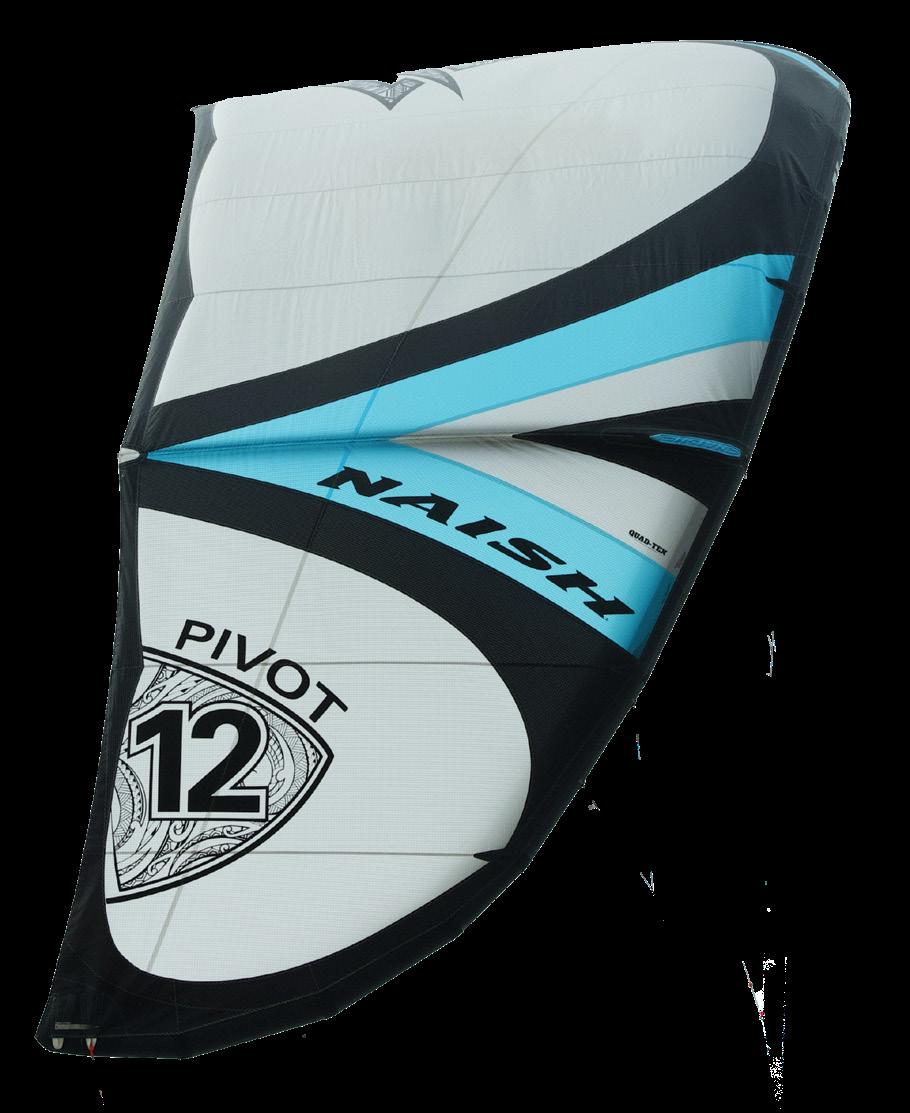
Sizes Tested(m): 7, 9, 12
Sizes Available(m): 6, 7, 8, 9, 10, 11, 12, 14
Control Bar: Torque 2 Control System
SYNOPSIS
High end performance that spans all disciplines and skill levels, the Pivot is one kite that can take a rider from their first steps of riding to the highest levels of big air competition.
LIKES
The Pivot kite has long reached the status of a true legend for its standout ability to perform at a high level for any kite riding discipline or skill level. The Pivot’s winning formula is found in the excellent combination of smooth power delivery and intuitive handling as well as the formidable lift and hang time it provides. This classic three strut hybrid design is perfect for pulling into some waves, riding on a foil board or just blasting around on a twintip. The big air capability of the Pivot is well known with its frequent podium finishes in the King of the Air and Big Air Kite League. For this year the Pivot S27’s bridle has been tweaked to include an additional attachment point on the leading edge which helps to lock in the central power point of the kite and improves the handling in the upper end of the wind range. With even more control over the formidable power of the Pivot in the upper wind range this year’s Pivot will perform with even more hang time as more power can be gained along with the proper control and kite manoeuvrability. This is most notable in the larger sizes of the Pivot. The Pivot has always had great levels of low-end power and smooth delivery across the window. With the enhanced upper end wind range, the Pivot S27 meets the demands of the modern kiter that dabbles in multiple kite disciplines as well as the avid newbie that wants to advance skills without constantly changing kite models or sizes.
DRAWBACKS
The Pivot flies with slightly more pressure off the front lines, so if you want a kite that is more set it and forget it and sits back in the window, the Naish Boxer is the way to go.

USERS
For the kiter that wants one model of kite with high levels of performance for any condition from twintip and freestyle, to foil, waves or big air.

CONTROL BAR: ZERO BAR 50 CM
The new Zero Bar is an alternative style control system for more advanced riders that want extra light weight and easy one handed steering. The Zero features an ultra light weight construction and minimalist design. The bar is ultra narrow, features a snap shackle trim loop connection and clam cleat adjustable trim line. With no foam floaters or padded grip, typically found on bars the Zero Bar is incredibly stiff and light. Ideal for more advanced riders on a foil or while riding waves where the lines become slack more often and you want a bar that is more nimble and light in your hands. Naish also has their traditional bar the Fusion 2.
kitesurfingmag.com - 83
Ocean Rodeo Flite A-Series
Sizes Tested(m): 10
Sizes Available(m): 12, 14.5, 17
Control Bar: Stick Shift 3.0
SYNOPSIS
The Flite A-Series showcases how Aluula turbo charges kite performance, enhances the easy boosting character and adds that ultra light weight feel in the air with more responsive handling.
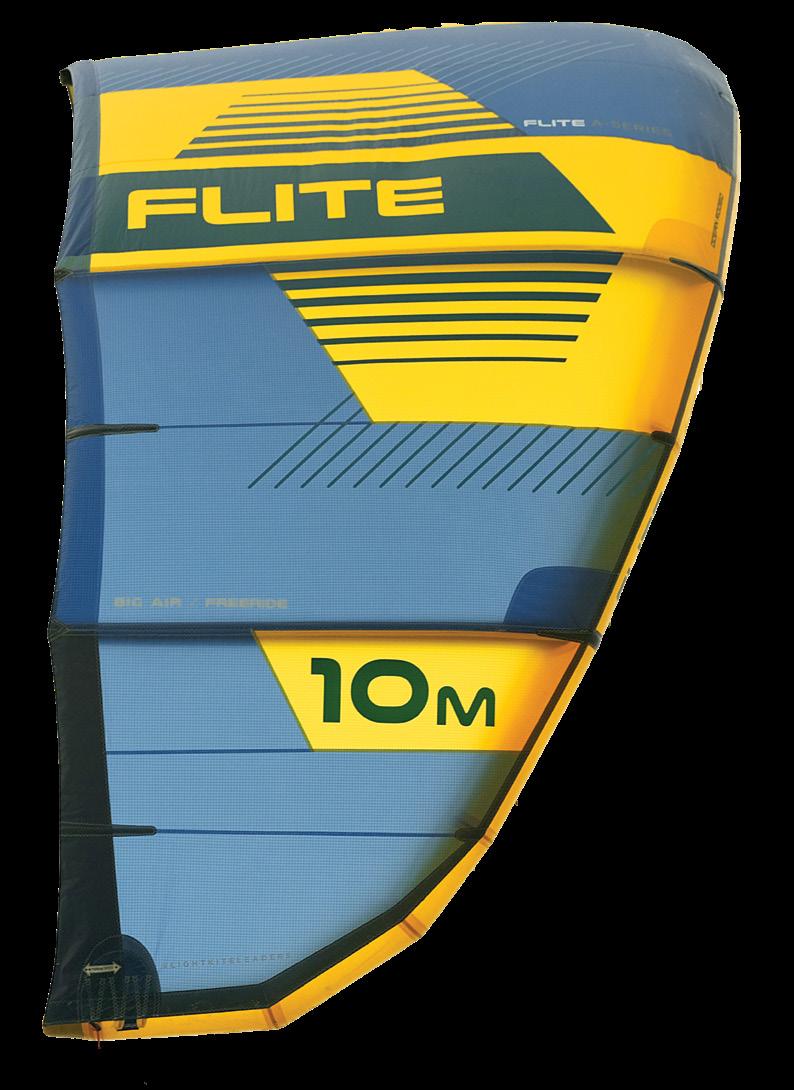

LIKES
The Ocean Rodeo Flite A-Series expands this season with the addition of an enhanced, easy access, big air kite. The new five strut Flite A-Series is constructed with Ocean Rodeo’s revolutionary ALUULA airframe technology with the aim to provide any level rider access to big air jumping and extra hang time and glide. For most five strut kite designs the added struts mean additional weight, but with the Aluula airframe technology, the Flite 10 meter weighs less than many three strut kites, constructed with the traditional Dacron. The Flite is also easier to handle with better low end power delivery and easier, sheet in and go performance, than the more, high aspect, competition big air kite in the OR lineup, called the Rise. The Flite A-Series has performance that makes jumping easy and accessible to the lesser skilled jumpers. Its light weight frame increases its easy to access lift and adds to the additional hang time and responsive control. The flat middle section of the Flite canopy ensures it can soar for that extra distance and reward less skills with more drift and hangtime. The Aluula enhanced frame also increases the speed of turn initiation as the Flite can quickly pivot and loop and reacts quicker to ensure a soft landing after soaring hang time. Having a lighter weight kite increases performance in all areas, including water relaunch, light wind stability as well as balanced drift and turn initiation. Test team riders were impressed with the smooth and quick pivotal steering of the Flite and the increased reaction time to steering input that the Aluula frame offers. The 10 meter is a great size with the right power band to get you out on a foil in lighter winds with good power and range for when the wind picks up. Riders looking for a kite with great overall range and versatility, with the easy boosting and extra hang time, should consider the Flite A-Series model.
DRAWBACKS
Once you have your jumping and massive hang time completely dialled you might wish you had an A-Series Rise for its lighting fast kiteloops.
USERS
Any skill level that wants a high performance freeride kite that is light and reactive with access to extra boost and glide with all the benefits of the new age, ultra light weight frame.

CONTROL BAR: OCEAN RODEO PILOT 2.0
OR’s new Pilot 2.0 is amazingly comfortable in the hands and hits all the marks for high end safety and functionality. This was one of the most comfortable bars in the hands with soft narrow grip. As with many things, once you try it, you likely won’t want to go back and the narrow bar grip is one of those things. The Pilot bar feels not only more comfortable but also more connected to the feedback from the kite. The Gen 9 Punch out QR release is quite short and compact giving the rider more access to instant depower from the throw which is particularly important for the riders with shorter arm reach. The trim loop itself is offered in three modes that can be changed out quickly with a single hex fin key to remove the bolt and affix the compact freeride, freestyle or rope slider loop.
84 - KITESURFING MAGAZINE / VOL 9 / ISSUE 1
F-One Trigger
Sizes Tested(m): 9, 12
Sizes Available(m): 6, 7, 8, 9, 10, 11, 12
Control Bar: LINX Bar
SYNOPSIS
The Trigger is a five strut, big air kite that has that classic direct and nimble F-One feel, but with even more amazing lift for soaring jumps and hang time.
LIKES
The Trigger is the newest model in the F-One kite line that offers top level performance for boosting big air with lots of hang time. It features a five strut frame with flatter arc, high aspect canopy that delivers the explosive lift extra hang time that is sought after in a big air kite. F-One’s development and test team, led by the company founder, Raphael Salles, is passionate about rigorously testing and tuning their kites to ensure they meet all the parameters of performance outlined for each product. Their philosophy is to use the highest levels of “sail engineering” to maximize performance without necessarily using ultra expensive materials that can double the cost of the kite. Both the new Bandit XIV and the Trigger show how kite performance can be substantially improved using improved design with high quality and proven, traditional materials. The Trigger is designed for going big and holding its form through mega gusts and mega loops but it’s not a difficult or clunky kite to fly and it feels light and crisp in the air. Sometime the flatter arced five strut kites with lots of pulleys can feel lagging in turn initiation and have a more sloppy, less reactive feel through the bar. The sweeping turns and higher aspect kites can take a bit more timing to get the right loft and trajectory to jump bigger, but the Trigger rewards even sloppy boosts with decent hang time and has a more easy jumping character than some of the more wind hungry five strut designs. It also has very quick and reliable turn speeds with a fast loop that won’t easily stall. The Trigger has great upwind drive and it offers some decent low end power compared to some of the competitors in this category. Like many of these new five strut dynamos the Trigger continues to increase in performance with more wind and power in the upper end. For riders looking for the most hang time and explosive lift per square meter the extra structure and stability in the upper wind range, the Trigger is your ticket to the stratosphere.
DRAWBACKS
Less direct feel and slower turn initiation than some standout three strut kites like the Bandit XVI.
USERS
Kiters that want to practice their big air manoeuvres with a familiar F-One feel and function, but with more hang time and upper end wind range provided in this five-strut design.



CONTROL SYSTEM: LINX BAR
The LINX Bar is a streamlined and refined control bar system well matched for smooth driving control. The bar has a very comfortable EVA grip with ergonomic shaping and easy colour coding. The main center line employs a rectangular PU sheath which provides low friction sheeting and won’t pinch fingers that are close to the stainless insert. The Quick Release cup is also easy to assemble and engage. This is a simple and effective system with nice streamlined bar floats that house the adjustable bar length ends and leader lines. With smooth sheeting depower ability, and easy clam cleat trim above the bar, the LINX Bar control system checks all the boxes for high standards of safety and functionality.
kitesurfingmag.com - 85
Eleveight WS V6
Sizes Tested(m): 9, 11
Sizes Available(m): 5, 6, 7, 8, 9, 11
Control System: CS Vary Bar
SYNOPSIS
Quick and reactive response with smooth pull and light touch steering the WS is built for riding in the waves but with easy handling it’s great for learning new skills in any discipline and across skill levels.
LIKES
The WS model kite is a solid performer in the wave and progression freeride realm and elevates its game in 2023 with some major tweaks to the bridles and wingtip shape. Version number six of the WS has all the right handling prowess that the modern wave or foil rider should look for. The WS is a well-balanced kite that feels light and crisp in the air and responds to rider input with quick and reactive pivotal turns. Built with high quality construction techniques and top of the line materials, Eleveight worked in some weight savings for this year’s kite lineup with lighter PU bladders as well as reduction in Dacron in the trailing edge. The WS shows improved balance with better low end power delivery than previous versions. New for this year the WS also has a pulley free bridle system that also offers more direct feel through the bar. The more squared off wingtip shape redesign has also aided in the WS’s revised feel and smoother and more consistent pull through the pivotal turns. Built using some top construction techniques and materials, the WS is built to withstand the additional punishment and abuse of crashing waves or learning new foiling skills that mean more wipeouts and more kite relaunching. When riding waves or learning new kite skills, it’s always essential to have a kite that can relaunch quickly. The WS also has nice depower that comes on in short order and floats well when the lines slacken. The controlled power is well suited to getting the rider into the wave pocket and killing the power for some wave rides and hard off the lip tail smacks. When the pull and power is needed, the WS comes alive and distributes quick and reactive turn initiation with nice low but consistent pull throughout the entire pivot. The WS also steers nicely with one hand for toe side riding which makes it a great kite on the wave but also perfect for lighter wind, freeride and foil pursuits. The 11 and 9 meter we tried are also great for learning with, with quick relaunch and lots of easy depower.

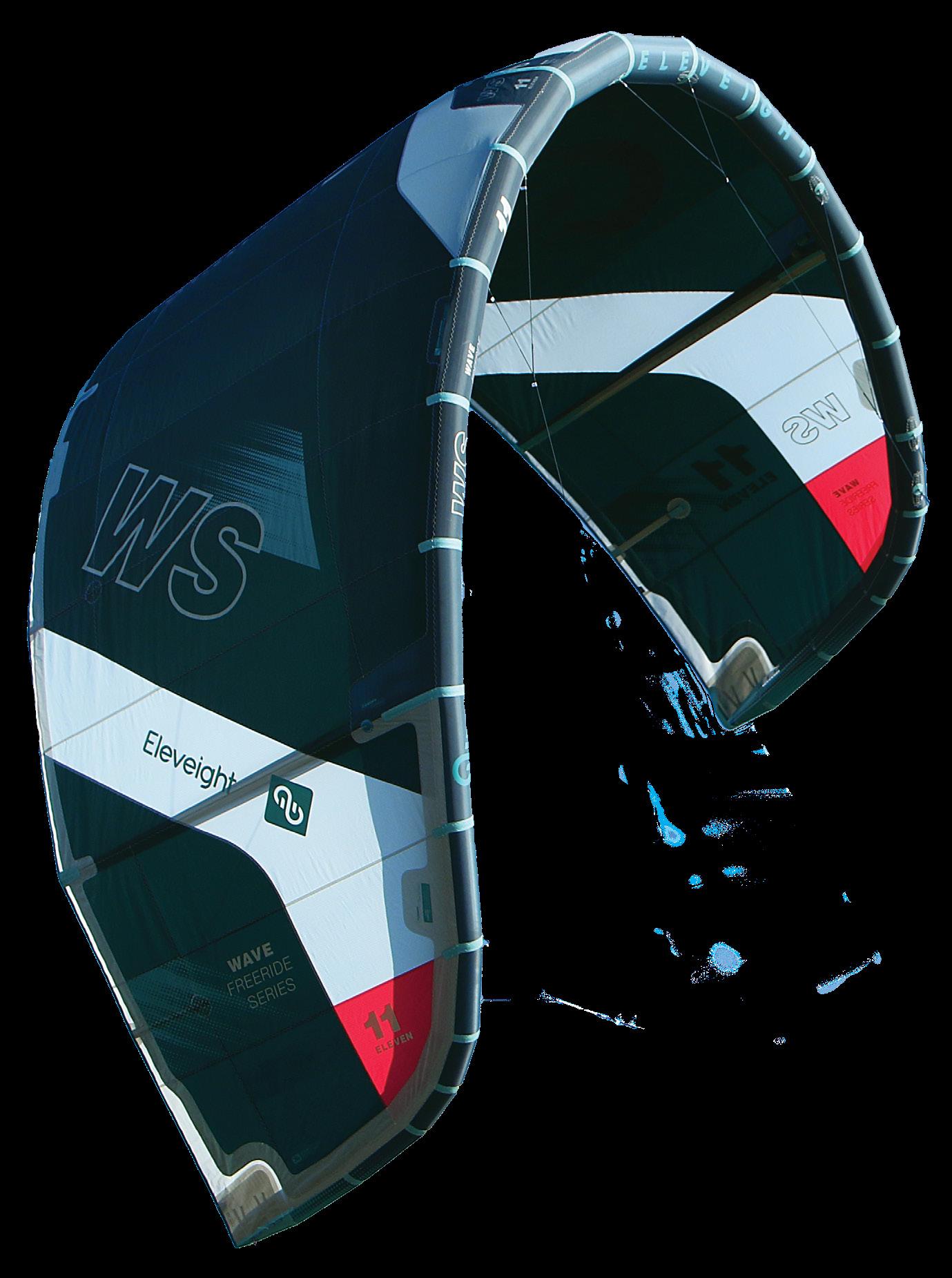
DRAWBACKS
Some feel that a wave designed kite can deter some users that don’t ride in waves, but this is a versatile kite that excels at many disciplines.
USERS
Wave riders and any level that wants an easy handling, easy relaunching kite for learning new board riding skills.
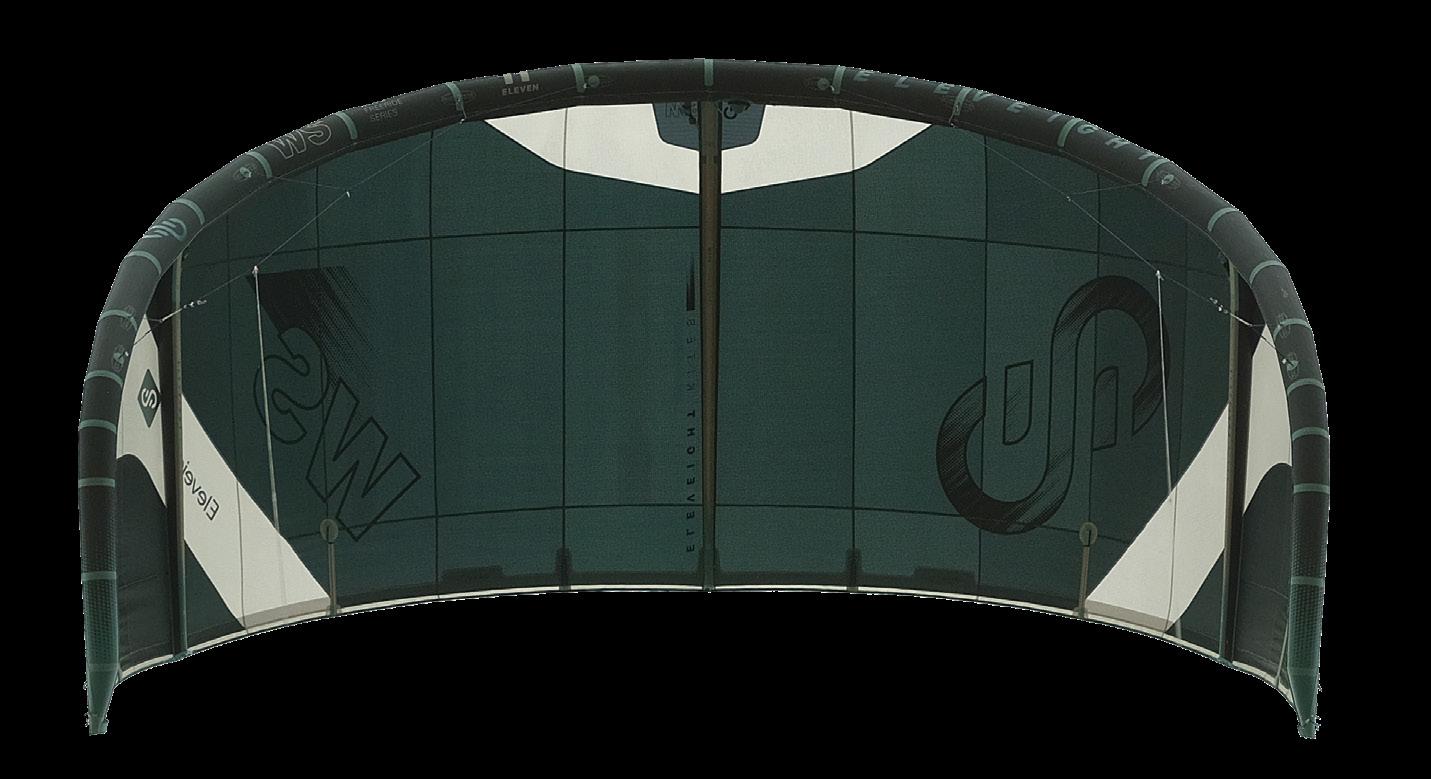
CONTROL SYSTEM: CS VARY PLUS
The CS Vary Plus bar checks all the boxes to keep in good pace with the industry’s top control systems. Since its arrival in the industry, Eleveight hasn’t missed a step in keeping up with the latest demands in kite and control system performance. Their CS Vary Plus bar is equipped with a single click-in style, quick release trim loop and features a smooth working, easy to adjust trim line. With streamlined EVA bar floats and a new PU covered center line the CS Vary Plus is a solid bar that works well with all of Eleveight’s quality kite models. Unlike a lot of other bars, that use very thick and hollowed out center line depower, the coated PU line spectra provides smooth sheeting action with less weight and chunkiness, for easy wrap-up after a quality session.
86 - KITESURFING MAGAZINE / VOL 9 / ISSUE 1
North Orbit 4
Sizes Tested(m): 8, 9, 10
Sizes Available(m): 4, 5, 6, 7, 8, 9, 10, 11, 12, 14
Control Bar: Navigator Control System
SYNOPSIS
The Orbit is a megaloop magician that sets itself apart for its ability to boost big but maintain the control, feel and handling needed in extreme situations.
LIKES
The North Orbit was one of the key designs that inspired the new revolution in the big air kite category and the fourth version of it gets some tuning and material upgrades to keep it on the leaderboard. The Orbit 4 has some new tweaks to its profile and bridles, along with lighter weight, PU bladders in the larger sizes and new lighter Dacron fabric in the frame keeping things crisp in the air. The weight savings and fine tuning make this year’s Orbit 4 more efficient through the lulls and even more reactive to rider input. The Orbit 4 also seems more stable while not powered up, which adds some overall user friendliness. As a higher aspect, five strut design, the Orbit loves to be driven with lots of power and conviction and it rewards the riders that know how to keep the pedal down and delivers amazing control in the upper end of the wind range. In overpowered conditions the Orbit excels and provides explosive lift, but with the power and lift you also need the right levels of control and handing that really gives you the confidence to boost big jumps and throw in some loops and manoeuvres. With the fully supported struts through the canopy, the Orbit truly excels in overpowered conditions. Test riders commented on how easily and quickly the Orbit fires upwind, which is important because this kite is fun to boost with and offers that extra hang time with its flatter and higher aspect profile. When underpowered however, like any kite it has some disadvantages to lighter, three strut kites. Compared to the traditional five strut hybrid or bow kite designs, the Orbit has a more direct feel with good feedback from the lines and quick turn initiation. Also new for this year are two additional steering feedback settings on the wingtips for a total of four settings. These allow the rider to tune the Orbit to the preferred feedback and bar pressure. Overall, an absolute dynamite kite as it really lends extra confidence and reliability in the upper wind range to any rider that wants to push their limits of big air jumping or just feel extra comfortable while super powered up.
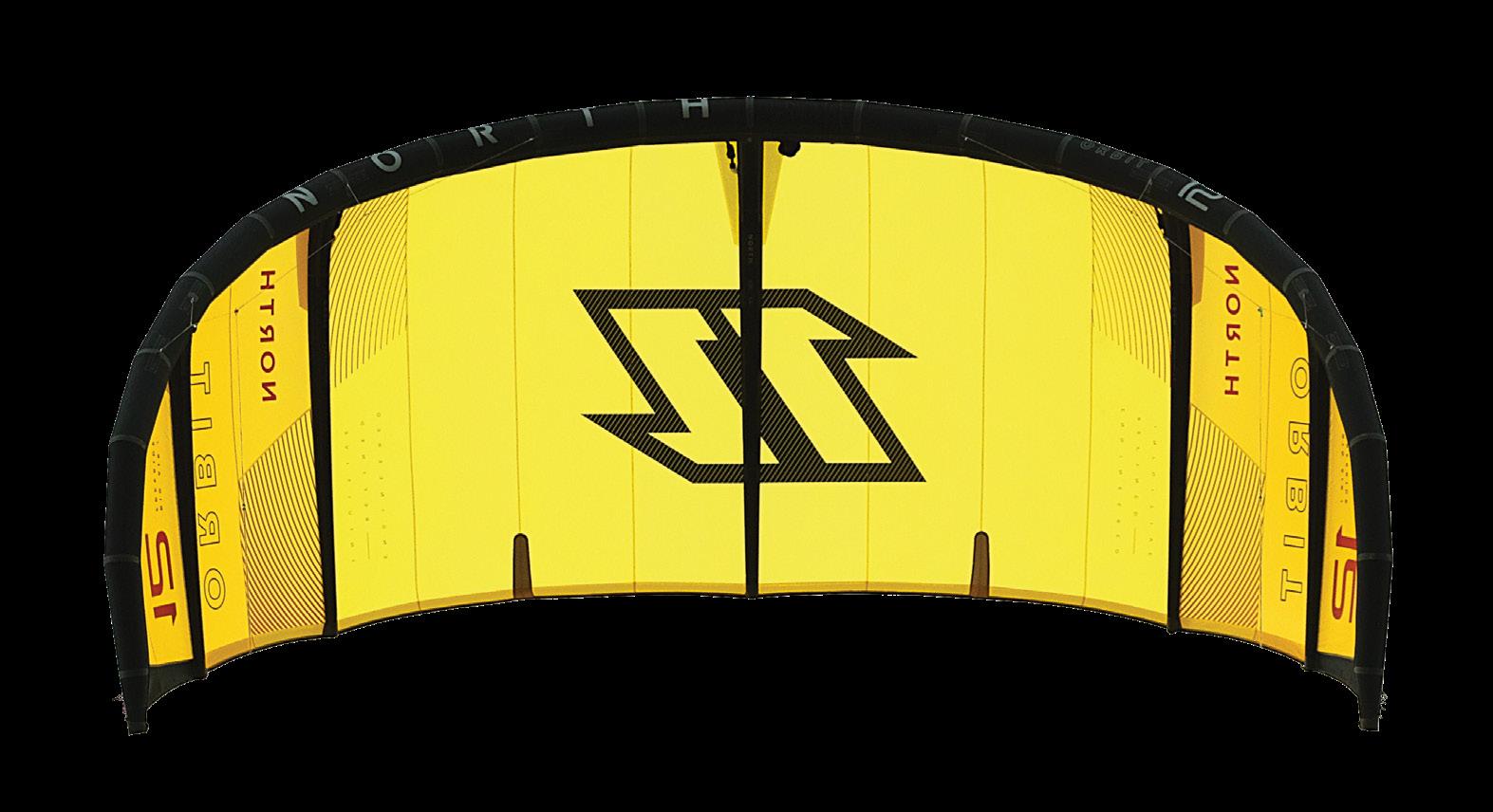


DRAWBACKS
Not as versatile or user friendly as some of the three strut, do-it-all kites, but for powered up twintip riding and boosting to the stratosphere with the most control and feeling available, the Orbit shines above the rest.
USERS
Intermediate riders that want that to learn to jump bigger and try some kite loops or simply want higher levels of comfort and control in the upper wind ranges should consider the Orbit a top choice.
CONTROL BAR: NORTH NAVIGATOR CONTROL SYSTEM
The Navigator Control System ticks all the boxes for functionality within streamlined design. The Connect Quick Release trim loop remains one of the quickest and easiest to reset and has patented, single motion reassembly with seat belt style push in to reset with no need to pull up the cup like some similar click in style models. The Navigator also offers one of the only completely tool free changing of the trim loop that lets you quickly change the loop to a larger freestyle loop or the surf loop that features a metal insert on the inside of the loop to avoid friction wear from using a rope slider bar on your harness.
kitesurfingmag.com - 87
Duotone
Neo D/LAB
Sizes Tested(m): 7, 9, 11
Sizes Available(m): 7, 8, 9, 10, 11, 12
Control Bar: Click Bar
SYNOPSIS
The Ferrari of all wave kites combines unparalleled drift and smooth power with refined control that breaks new barriers in drift.
LIKES
The Neo D/LAB is Duotone’s newest wave focused model that incorporates the light weight and reactive Aluula material in the leading edge and center strut. This new age material helps to cut around 30 per cent of the kite’s weight, making it ultra light for enhanced riding in waves or lighter winds with a foil or any designated lighter wind board. Three years in development, the Neo D/LAB breaks new barriers in performance for riding waves in lighter winds and has increased wind range with better drift action and heightened reactivity across the size range. But it’s not just about the weight reduction; the Neo D/LAB with Aluula material in the frame makes kites so stiff and reactive that many of the traditionally constructed Neo design parameters had to be reworked. Some of these included the bridle configuration changes, as well as the reduction in the diameter of the leading edge around the wingtips. Most visibly the employment of the two flex struts. All of these elements have combined to help the Neo D/ LAB break new barriers of handling. With more control and reactivity and smoother power delivery through the turns the kite is both reactive and stiff but also able to twist properly when pivoting. The performance enhancements of the Neo D/LAB are quite unparalleled, especially for riding waves or while riding underpowered in lighter winds. Test riders were blown away with the quick and reactive handling even while completely depowered or under lighter wind conditions with low line tension. Any experienced kiters can attest, trying to link turns with a larger sized kite was never really that fun or feasible. But with the Neo D/LAB 11 or 12 the drift action combined with smooth power delivery and turning response; it really opens up the ability to session on waves in lighter winds. The Neo D/LAB also gets top marks for being a great jumping and all around freeride kite with easy water relaunch and stable and predictable performance to help the intermediate level riders expand their skills to the next level. Any level of rider looking for the ultimate in tech designs with real performance advantages should consider putting a Neo D/LAB in their quiver.

DRAWBACKS
Sticker shock may ensue for some but barrier breaking performance comes with a price that many will find worth every penny.
USERS
Advanced to intermediate level kiters that want the ultimate wave kite or light wind specialty foil or wave kite for the most drift, reactive steering, control and wind range available.


CONTROL BAR: DUOTONE CLICK BAR
The Click Control Bar has all the advanced features of the top bars combined into a single control system plus it includes an internal trim system that lengthens the back lines with a click of a button. To reshorten the back lines, a half twist of the bar end winder gets your kite powered up. The Click Bar also features the auto untwisting front lines during rotations and it also untwists the flagging line for additional safety. New for this season, Duotone has a new seatbelt style, click in Iron Heart VI quick release trim loop.
88 - KITESURFING MAGAZINE / VOL 9 / ISSUE 1
Core Nexus3
Sizes Tested(m): 7, 9, 12
Sizes Available(m): 5, 6, 7, 8, 9, 10, 11, 12, 13.5
Control Bar: Sensor 3
SYNOPSIS
New feel and improved high end performance, the Nexus 3 ups its game with high levels of performance for any condition or riding style.
LIKES
The Core Nexus 3 kite is the newest design that offers no compromise, all around performance with quick turning speed, consistent jumps and top level handling for any situation. Whether you want a kite for riding waves or foiling, learning to pop and jump for un hooked freestyle or for sending it for big air hang time, the Nexus 3 can adapt to most situations. Core has the advantage of using their own exclusive high tech materials and build technology that push new levels of performance, durability and longevity into each new model. The new Nexus 3 reaps the benefits of both ma terial upgrades as well as some design tweaks to their bridles, profile and wingtip shape. The result is that the Nexus 3 feels lighter and more responsive, with faster pivotal turns and overall, a more high end, performance oriented feel for 2023. Ultimately, the new Nexus 3 feels more like a true high performance maverick that competes more directly against the industry’s long standing three strut legends. The new light and crisp feel of the Nexus offers even better drift action and more precision control for riding waves and even better stability in light air with quicker turn response and fast and reactive handling. The earlier versions had a bit more bar pressure and a more sluggish feel in the bar than this new Nexus 3. Any rider that wants to dabble in the full gamut of kiteboarding disciplines will appreciate the Nexus 3’s well rounded performance levels. It was a great kite for foiling with quick pivotal turns and easy one handed steering. Equipped with Core’s new Exotec2 Dacron, it’s well balanced. It easily relaunches in light winds and also floats and responds nicely in un derpowered riding conditions which are both essential performance elements for kite foiling. This was one of the test favourites in the all around category and shows the most change and improvement from previous ver sions. The light three strut frame drifts nicely for wave riding and it feels quick and reactive with nice light touch steering for kite foiling and riding with lower line tension. The Nexus is also easy to relaunch making it ideal for any level of rider that seeks to learn new skills.

DRAWBACKS
Slightly less low end power and high gliding hang time than the flatter profiled, XR7 freeride kite.

USERS
The modern multi disciplined kiteboarder that wants a high performing kite for any and every situation.
CONTROL BAR: SENSOR 3S
The Core Sensor 3 bar is packed with technical features and quality components. The quick release cup features a push away engagement and easy, single handed reassembly. The rubberized bar ends are nice and grippy when the kite needs to be aggressively turned by grabbing one side of the bar. With the fold away bar winders at the bar ends, the Sensor 3S’s very streamlined, low profile and is light in the hands. The main trim line features two lines coated with a soft PVC that protects the lines and also ensures that the front lines auto untwist as the bar is sheeted out towards the kite. The Sensor 3 work perfectly with a Section kite in the waves, giving great feedback and response from the kite while at the same time it feels light in the hands and less clunky when there is less line tension while riding down the line.

kitesurfingmag.com - 89
Reedin SuperModel HTF
Sizes Tested(m): 8, 9
Sizes Available(m): 5, 6, 7, 8, 9, 10, 11, 12, 14, 16
Control Bar: DreamStick X
For big air hang time or waves, carving it up on a foil or popping freestyle manoeuvres, whether you are expert or beginner the Supermodel HTF is for every rider, regardless of skill level, conditions or style.
The fourth evolution of the Reedin SuperModel HTF continues to push the boundaries of performance in the do it all, three strut category. New for 2023, the SuperModel HTF adds their new High Tension Frame technology. This new feature incorporates the kite’s narrow and stiff leading edge with a new panel layout and seam placement from the trailing edge diagonally through the canopy. By aligning materials and seams Reedin has found a way to more efficiently distribute canopy tension to make their kite more reactive to turn initiation and also increase and smoothen the kite’s turning speed. The leading edge also uses lighter gauged Dacron, shown in white coloured sections, on the leading edge near the wingtips. This feature along with the narrowed diameter of the struts allows for more twist through the kite which ensures ultra smooth and reactive turns. The kite test team was impressed at how the SuperModel HTF was so consistent and flutter free through the turns, with absolutely buttery smooth power and pull from start to finish. Where most three strut kites have some flutter through the canopy when aggressively looped, the SuperModel HTF has virtually no flutter or distortion of the canopy during aggressive manoeuvres. This is a very intuitive and easy kite to fly and feels familiar and builds up rider confidence quickly. The three strut frame is light and the SuperModel HTF is well balanced and drifts nicely under low line tension making it great for riding waves or pulling a rider on a foil. For boosting jumps, the SuperModel HTF blasts to the moon and offers that extra lift and added secondary boost when it’s really pumping and the timing is dialled. Ultimately, the SuperModel HTF has all the elements that the modern, multi-disciplined kiter looks for in a kite design that can handle everything from waves to freestyle, foil riding or big air. The jumping ability of the Reedin is quite remarkable and sets it apart from the pack with easy to access lift and amazing hang time. The SuperModel HTF also has some buttery smooth and consistent pull through turns of any kite on the test. It’s a kite that feels familiar and is intuitive to fly which quickly builds rider confidence to help push the limits and break into the next level.
DRAWBACKS
If you are trying to ride in ultra light winds for foiling, an ultra light weight kite, with a single strut, or extra light framing material will relaunch easier than three strut kites.
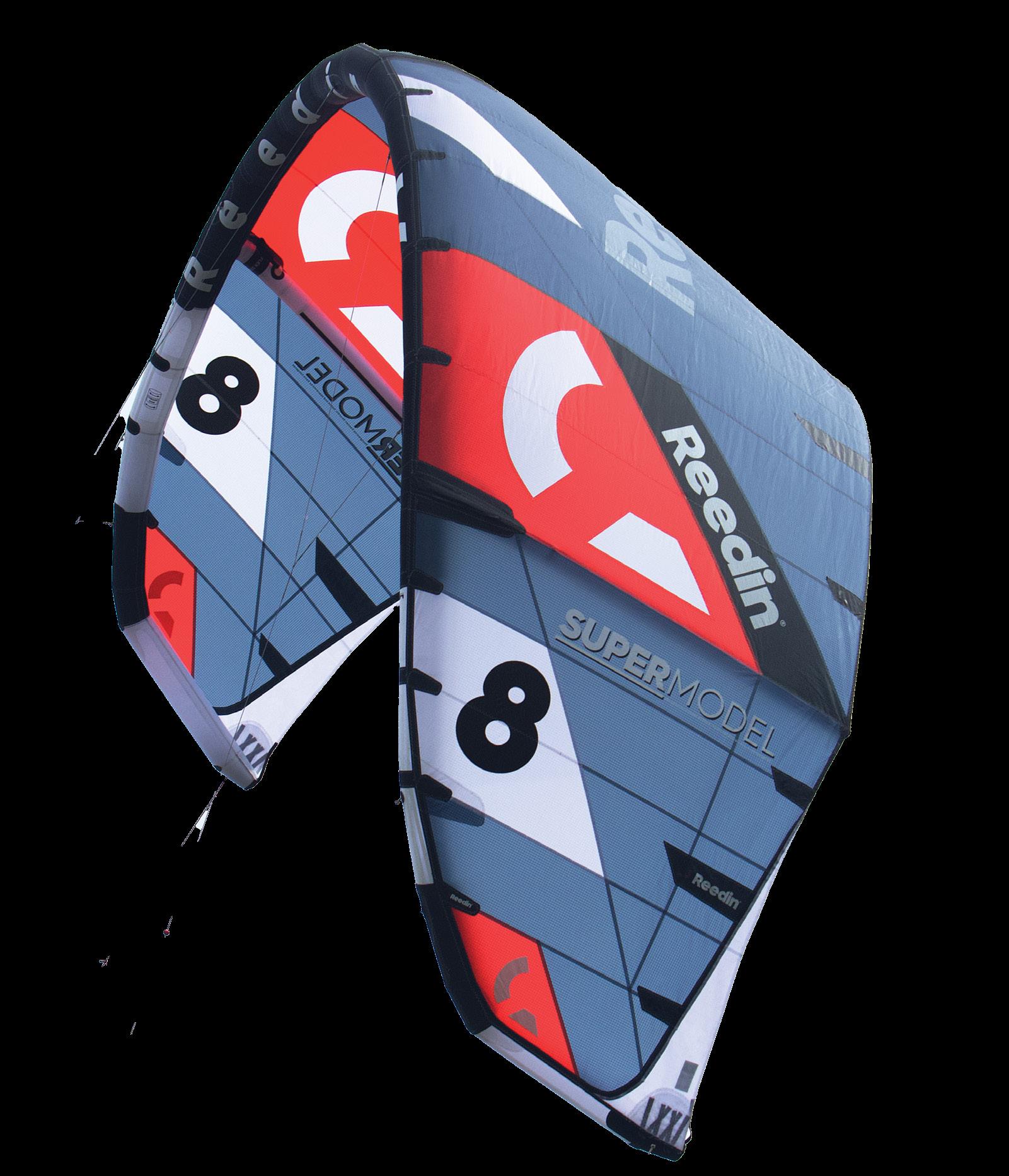
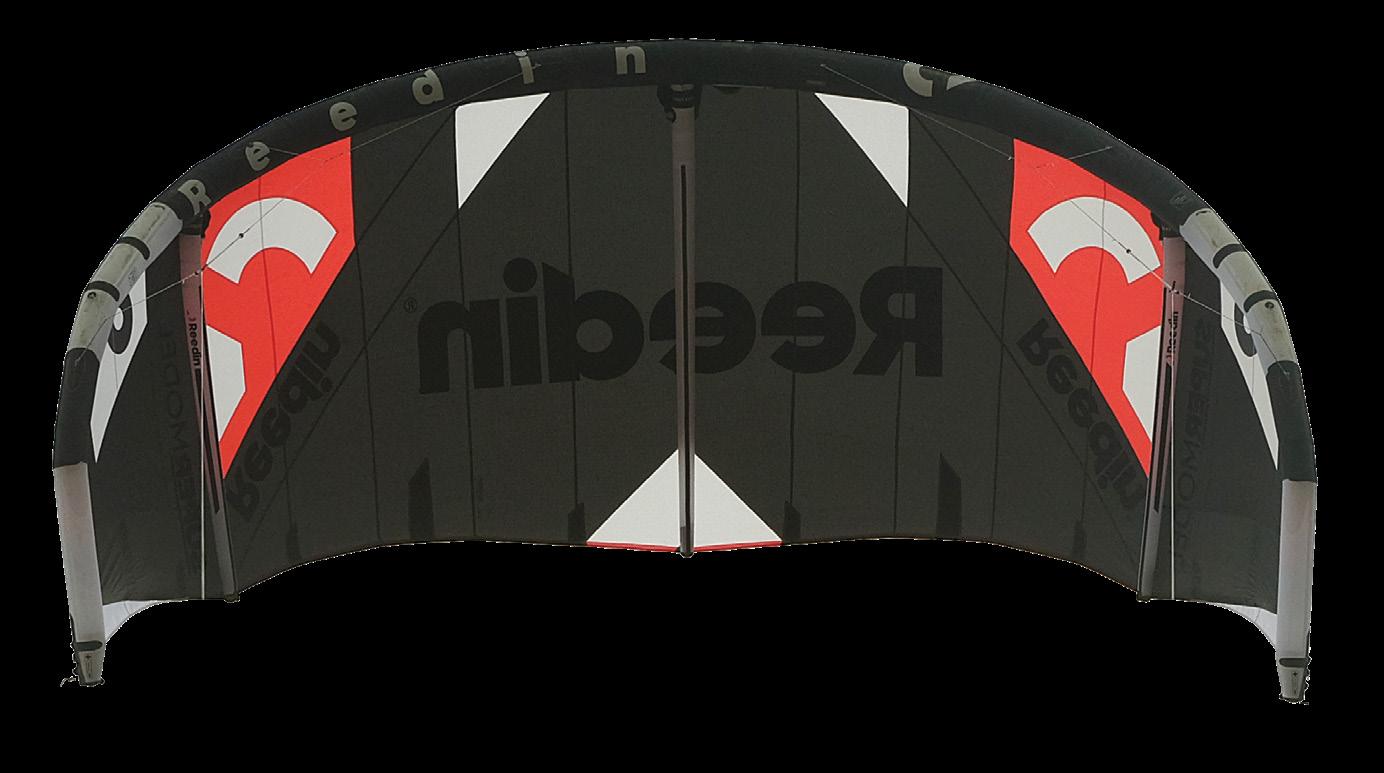
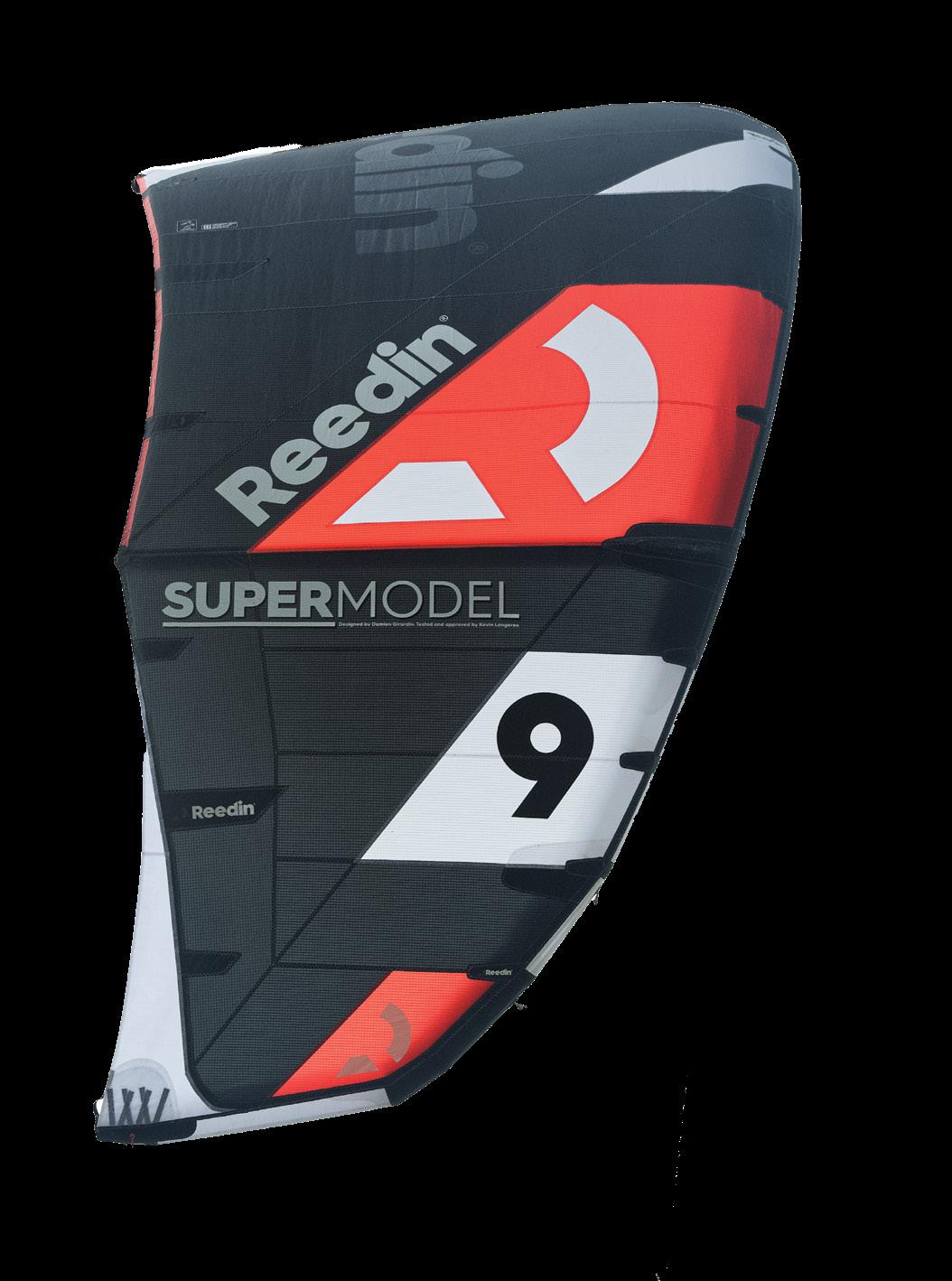
USERS
Intermediate to advanced level riders that want a kite to boost big, foil hard and slash waves with the best of them.
CONTROL SYSTEM: DREAMSTICK X
The DreamStick X is a bar that once you use a few times you will you want one. Not many companies have adopted the extra narrow grip but the comfort and control from this bar is amazing. From the seatbelt style, single click in trim release cup, the streamlined and well cushioned, adjustable bar length, bar ends, to the top quality pre stretched flying lines, the DreamStick is loaded with well designed and performance enhancing features. The grip itself is very ergonomic and comfortable and should come with a warning if you haven’t used a smaller diameter kite bar yet because it’s instantly addictive.
90 - KITESURFING MAGAZINE / VOL 9 / ISSUE 1
Cabrinha Moto X
Sizes Tested(m): 12
Sizes Available(m): 5, 6, 7, 8, 9, 10, 12, 14
Control Bar: Overdrive Trimlite
SYNOPSIS
The totally redesigned Moto X reaches new levels of high end performance with plenty of boost and hang time, nice feedback and light and crisp handling to excel in the full gamut of riding modes.

LIKES
The new Moto X received a complete redesign for 2023; it’s almost an entirely new kite with a new feel and all new level of breakthrough performance. The three strut hybrid kite, with no pulley, front bridles, the Moto X is one of three new designs from Cabrinha’s legendary designer Pat Goodman. The Moto X design aim was to provide a kite that has performance for any skill level, for versatile and accessible levels of performance that can adapt to any condition or riding discipline. Test riders were impressed with the quick and reactive steering, nice easy boost and overall performance of this kite. The Moto X kite definitely keeps pace with top, do everything designs available for 2023. It will be exciting to try the smaller sizes given the quick turning speed and crisp and reactive handling of this 12 meter. In fact, where often Cabrinha kites in the past seemed larger than their named size, this twelve meter felt more true to its size or even slightly smaller with quick and reactive turns and light touch steering. The Moto X 12 meter is easy and intuitive with good stability and forward pull, making it ideal for less skilled riders to learn the basics. Higher level riders can rely on the Moto X with nice feedback from the kite lines and with quick and tight turn through the loops. This a great kite for foiling or riding waves as well as boosting easy jumps with good control and consistent lift and glide. The kite has good low end power with fast and easy upwind drive and light touch steering. It rewards lesser skill jumps with easy and consistent lift and nice hang time. Fast pull and smooth pulling drive, this Moto X will get you back upwind quickly after some big lofty jumps. The new canopy and framing material makes the kite light and responsive. The pulley free bridle system is compact and offers nice feel and feedback from the kite with positive turning initiation. Overall, if the smaller sizes turn out to be as indicative of the high levels of performance offered in the twelve meter, the Moto X should become the work horse of the Cabrinha lineup this year.
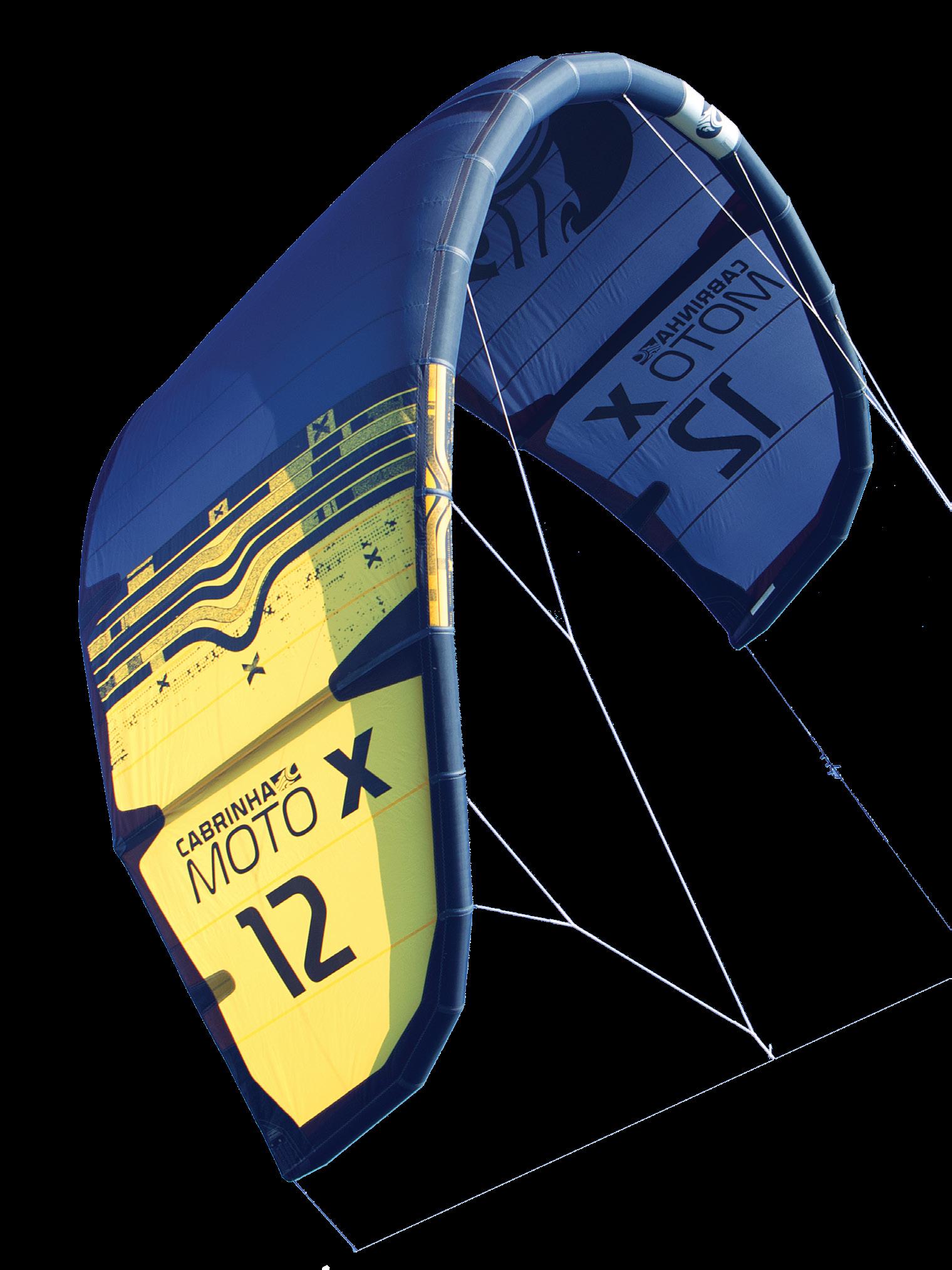
DRAWBACKS
May replace the Switchblade in Cabrinha rider quivers, especially in the larger size with its nice power band, quick turning and nice jumping and looping ability.

USERS
Great kite for any skill level, from beginner to advanced that want a kite to learn new tricks or riding disciplines from waves to big jumps to riding on a foil.
CONTROL SYSTEM: CABRINHA OPERATING SYSTEM
The Cabrinha Operating System is the new control system they call the COS and this bar is packed with quality features and high functioning componentry. Starting with the grip itself, the new control bar is nicely padded and comfortable on the hands. The EVA foam covering has left and right tactile differences so the rider can feel if the bar is in the correct hand after crashes or spins. The bar ends easily click back and allow for leader and 8 cm of bar length adjustments and feature nicely streamlined and functional bar end floats. The new quick release trim loop offers the seatbelt stye engagement for quick and easy, single-handed reset as well, and tool free changing of the trim loop sizing. The split PU covered, main trim line and below the bar swivel, offer automatic untwisting of front lines when the bar is pushed away. A simple and clean trim system is also ensured with the new Trimlite stainless steel cleat for above the bar trimming of the front lines.
kitesurfingmag.com - 91
F-One TRAX HRD Lite Tech North Trace
Size: 136 x 40

Bindings: Platinum 3
The TRAX HRD has pure freeride oriented performance that is well suited to any skill level. The solid, wood core constructed board is packed with smart technology to give it nice stiff and reactive flex. It’s a smooth and controlled ride with plenty of access to speed and high levels of control. Test team riders found this board really smooth through choppy waters with nice grip for loading up the lines or blasting some hard carving turns. When you lift off the edge though, the TRAX has a really smooth carving nature that can be hard to find in the more aggressive freestyle oriented, twintip shapes. The unique HRD rails consist of thicker and inverted rails under the feet that taper to sharper rails through the mid section and tail. This gives the board a floaty feel with easy release through board slides and transitions. Fast and controlled, with plenty of pop for freestyle or big air, the TRAX HRD is a solid performer for any level and is a board that you can learn and grow with. The Platinum 3 bindings complement the TRAX HRD Lite Tech’s performance with a nicely adjustable and locked in system. There’s lots of cushioning under the heel and on the straps to soften landings.
Size: 145 x 45
Bindings: Flex LX


The Trace is North’s light wind oriented twintip. It ensures that extra push of power and drive in less powered up conditions or for lesser skilled riders that need help in tracking and riding efficiently upwind. The shape and design of the Trace features a medium curved rocker line, with a wider outline that carries through the parallel rails and into the wide tips. The squared and longer outline helps drive some extra power from your kite and keeps you going in lighter winds with less effort. The Trace is a great set up for beginners but it is also a great design for the intermediate level rider that wants to practice tricks and transitions in lighter winds with a bigger kite. The bottom shape features a centred spine with quad channels that follow right through to the tips. This aids in the easy tracking of the Trace and helps it slice through some smaller chop. The Trace is well complimented by the new North Flex LX Binding, which are amazingly light and comfortable. This binding system is packed with features to ensure riders have the ultimate comfortable and locked in feel, regardless of foot size or shape.

92 - KITESURFING MAGAZINE / VOL 9 / ISSUE 1
Naish Traverse Core Choice 5
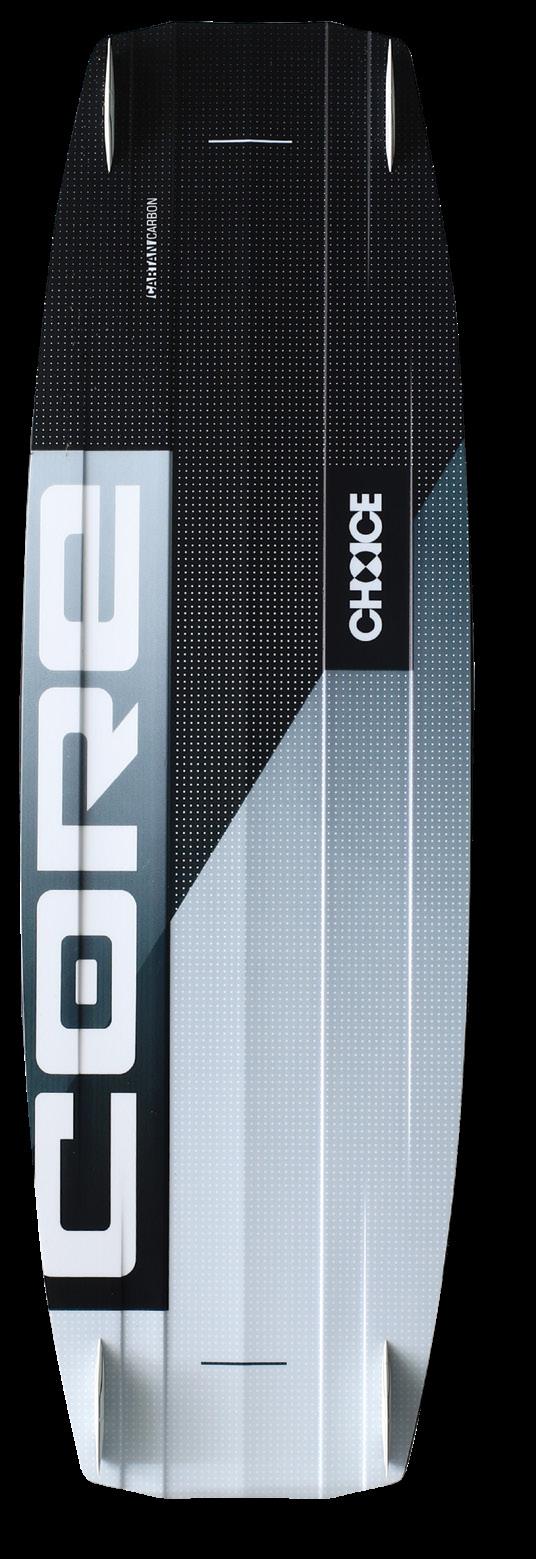
Size: 152 x 43.5
Bindings: Apex


The Traverse board is a unique Naish twintip shape, inspired by pro Rider Ewan Jaspan. Its mission is to provide a fresh new freeride feel that is both comprehensive and versatile. Not your standard pro freestye twintip shape, the Traverse is longer with more rounded out tips. It’s designed to utilize this extra width for better upwind performance and more pop and power for lighter winds. All these features, combined with a more moderate flex and continuous rocker allow the Traverse to slice through the chop and give the rider access to a more surf-like, carving feel. The Paulownia wood core provides plenty of pop and reactivity though and the board is easy to stick those off axis landings with its additional length in the tips. Super fun for freeride cruising and easy to rip upwind, this is a shape that will let you ride for long sessions with comfort and control through sloppy water conditions. No need to worry about foot fatigue either; the Naish Apex binding is very adjustable and offers nicely cushioned footbed support. The micro adjustments for stance angle also set the Apex apart from some of the competition’s bindings that have more limited settings.
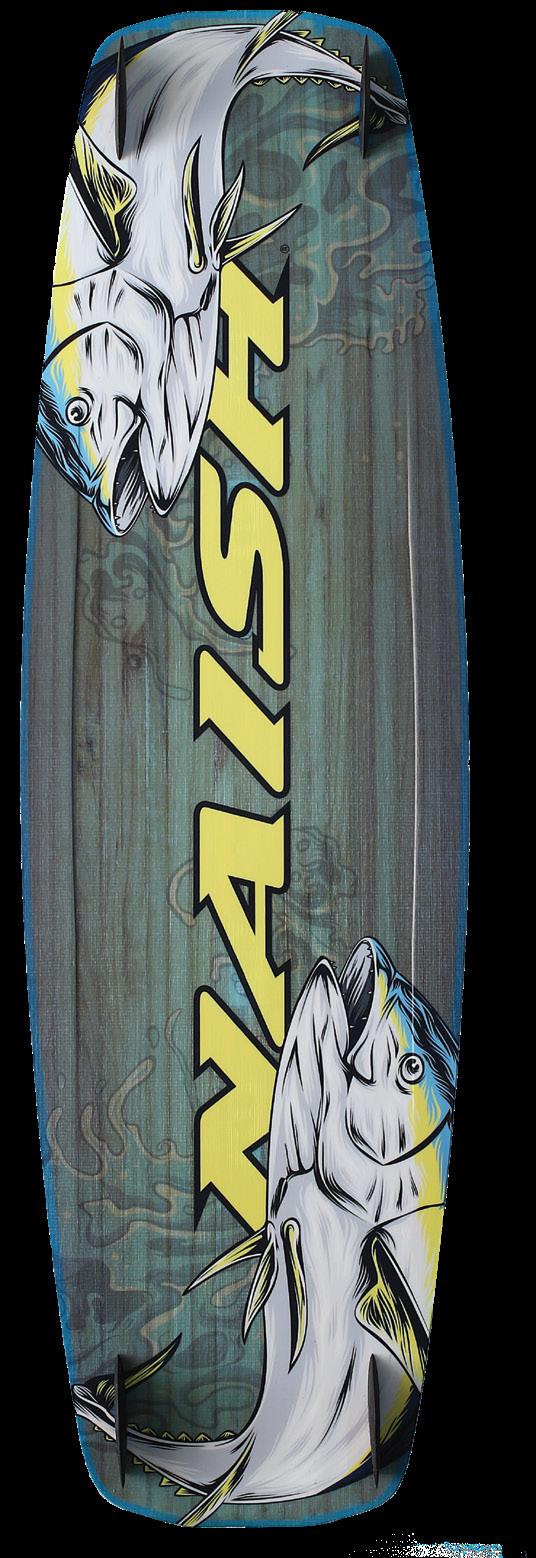
Size: 139 x 42
Bindings: Union Comfort
The Choice 5 from Core is a highly evolved twintip shape that offers outstanding levels of performance. With superior comfort and control through the chop it has explosive pop for jumps that ends with a nicely cushioned landing platform. The Choice 5 is also absolutely loaded with high tech materials that keep it light as well as stiff with excellent reflex response. The bottom shape is very complex with lots of channelling and a V through the central spine that creates this magical ride beneath your feet. Whether you’re a beginner looking to learn the basics or a fully booted up, wake stye ripper, the Choice is one board that will elevate your twintip experience. Test riders were fighting for more sessions on this new board with its explosive pop provided by the wide tail combined with its quick drive and chop eating mastery. The Choice has a unique combination of being grippy and powerful for jumps but also comfortable with nice edge to edge carving and control. The test team rode the Choice with the new Union Comfort binding system that is light and comfortable. The no frills strap works nicely for most regular foot sizing. The cushioning is nice and thick and the diamond shaping and toe ridges provide plenty of grip.
kitesurfingmag.com - 93
STUFF WE LIKE
MANERA Halo Harness ADAPTIVE SHELL TECHNOLOGY

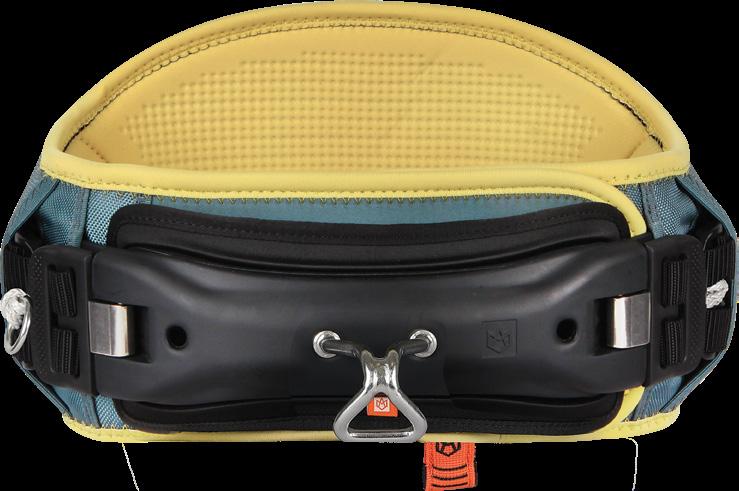
The Manera Halo Harness has an excellent combination of support and comfort. It’s a great alternative to the full-on, hard-shell harnesses that offer additional stiffness and reduced flex and compression but are also a less comfort able fit for certain body types and waist shapes. With the Halo’s innovative and patented Adaptive shell technology, the Kitesurfing Magazine test team found the Halo fits nicely and is really very comfortable even when the body is moving in areas where traditional harnesses may be more restrictive and uncomfortable. The hard shell component of the Manera Halo is a rigid arc that prevents the harness from bending and compressing your sides, much like a hard shell harness. Its function is to manage the mechani cal pressure that the harness receives, while the Adaptive skin ensures that the harness adapts perfectly to your movements. This technology eliminates the need for large, thick foam for comfort, providing a more direct feeling, less bulky contact, and a lighter feel, even when wet. Manera Halo’s components are assembled without glue or seams, making each part easily replaceable. This reduces the carbon footprint and increases the life cycle, as you no longer have to throw away the entire product due to a worn or damaged part. The Manera Halo Harness is the ultimate solution for kiteboarders who want both comfort and support.
MANERA.COM
AVRO Pump
Introducing the AVRO Pump. After rigorous testing by the Wingsurfing and Kitesurfing Magazine test teams for 6 months, we can confidently say that it is not only faster than traditional electric pumps, but also faster than the time it takes to set up your kite lines or foil and put on a wetsuit. Its compact and lightweight design makes it easy to take with you to the beach, while the sand blocking filters protect the internal components from damage. One of the key features of the AVRO Pump is its ultra-lightweight design. Weighing in at only 2.4 pounds (1.1 kg), it is made of polymers, composites, and a lithium battery pack, making it the most compact automated portable pump on the market. Spread out over six sessions, we inflated ten wings and seven kites on a single charge! At $199 US it’s not a must have, but I don’t think we would want to go without ever again.
AVROPUMP.COM
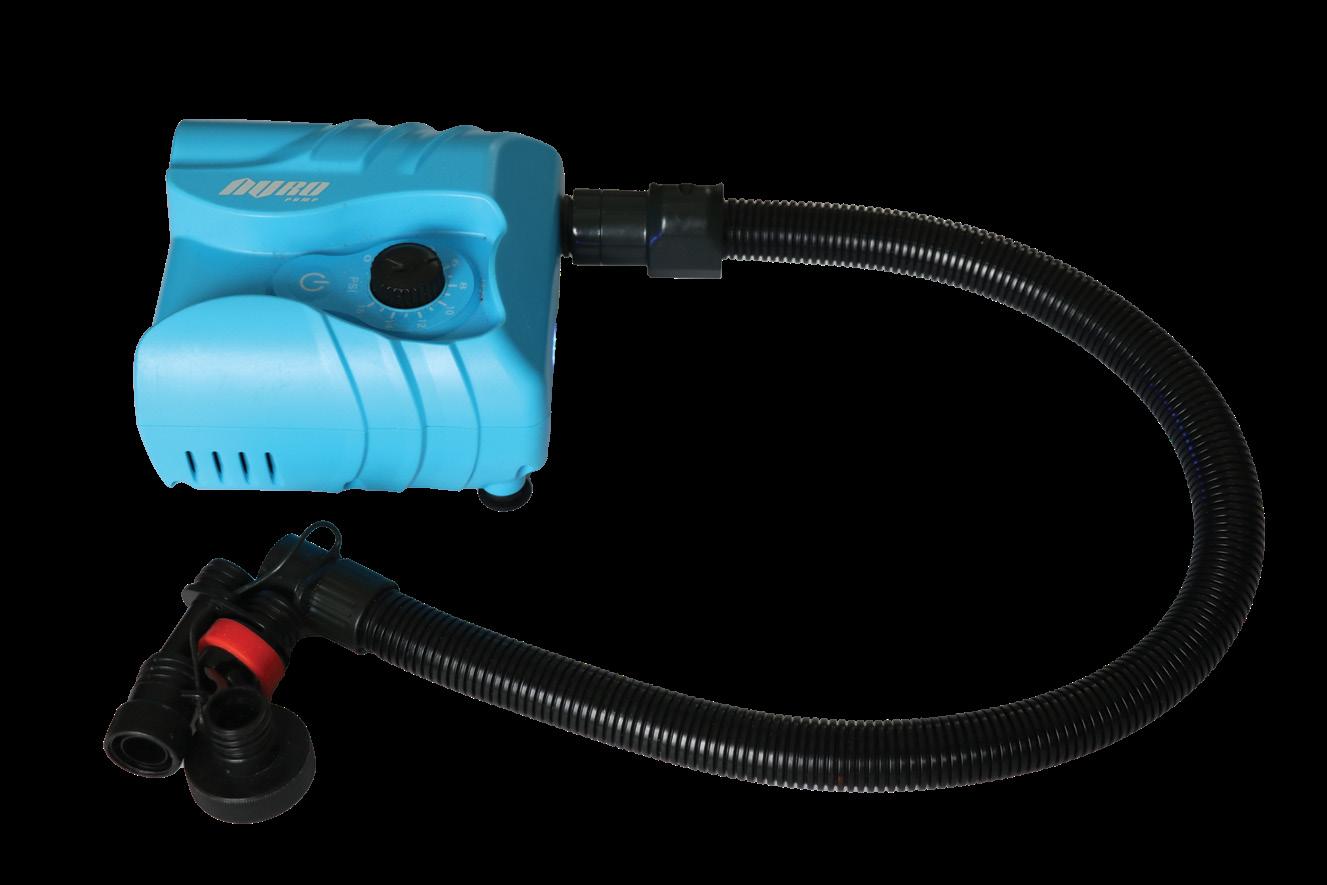
TRITON FOILS T1 Monowing
The Triton T1 Monofoil is a unique kite specific foil that features a single front wing with no fuselage or stabilizer. The T1’s stealth fighter jet look is built with a light weight, carbon construction, while the fuselage is an aluminum composite. The test team was excited to finally try out this interesting foil design. The benefits of the more compact set up for travel and the ability of it offering added manoeuvrability and tighter carving ability is very appealing. Up on foil, the T1 takes a bit to get used to and might not be ideal for the less experienced kite foiler, but after getting the right foot pressure dialled, the T1 is an absolute blast to ride. In a straight line the T1 is not the fastest or the slowest kite foil wing, but it gets up to speed nicely and doesn’t get unruly when you push it hard. It glides nicely through the lulls and has fairly low stall speed once you’re up and moving. The T1 may not provide the super early lifting or smooth drive as some of the newest freeride foils but it has some very fun manoeuvrability features that set it apart. It’s amazing how tight and hard you can crank the turns and transitions compared to many of the slower and maybe boringly, stable kite foils. It also has a very loose feel from toe to heel edge and will appeal to any foiler that’s had enough of just mowing the lawn back and forth and wants something with a more exciting turning radius. Great for pulling into waves and carving transitions, the Triton foil is a great and compact set up for traveling.

94 - KITESURFING MAGAZINE / VOL 9 / ISSUE 1




kitesurfingmag.com - 95 SURF SHOP •NAISH •DUOTONE •ION •MYSTIC •FIREWIRE Windance.com ALL THINGS WINDSPORTS 1-800-574-4020 108 Highway 35, Hoodriver, OR wing kite windsurf foil No sales Tax Open 7 days a week Free shipping on orders over $50 Get geared up JACKNJILLSSURFSHOP.COM




WIND SO PERFECT YOU MAY FORGET TO ENJOY THE SCENERY.
Enjoy 20 knots all summer long: scan the QR to grab Daily, Multi-day and Season’s passes Shuttle boat access to Pepahím island, rider rescue, and an accessible, scenic training ground Squamish is a mellow 1 hour drive from YVR. Season dates May 13 - September 15
Photo by: Luke Ostapiak


TO KITESURFING MAGAZINE FOR YOUR CHANCE TO WIN! *Full contest details available online. Enter Now... No Purchase Neccesary! SUBSCRIBE This issue Kitesurfing Magazine is giving away a complete foiling setup from Cabrinha. $3500 msrp SCAN THIS • • Special Agent – any size • 950 Fusion Foil (alloy mast any size) • 220 or 300 tail • Ultralight straps • 7m, 9m, or 11m Contra (pick ONE Trimlite bar
GENERATION NEXT
10 riders you should know
Global Kitesurfing Guide WINGING IT?

The 5 Best Bucket List locations for wind and progressing your riding.
Should it be part of your watersports quiver?
TRAVEL
Pack like a pro! Travel with more gear for less money.
Gear Head
Sneak peak at the best new gear for 2024.
What gear should go head-to-head this summer? Let us know on Twitter.
@kitesurfing_mag
Naish pro rider Louka Pitot sessions the hottest new kitesurfing destination Fuwairit Kite Beach . Look for an in-depth ride guide in our next issue, and an exclusive interview with Louka Pitot. Romantsova photo.

PUSHING THE BOUNDARIES
PERFORMANCE BIG AIR
In 2004 Cabrinha took big air kiting to a new level with the Nitro. A kite that was ahead of it’s time, it powered riders to the top of the podiums around the world. Nineteen years later we have broken the boundaries in the big air realm and are bringing it back to our roots.

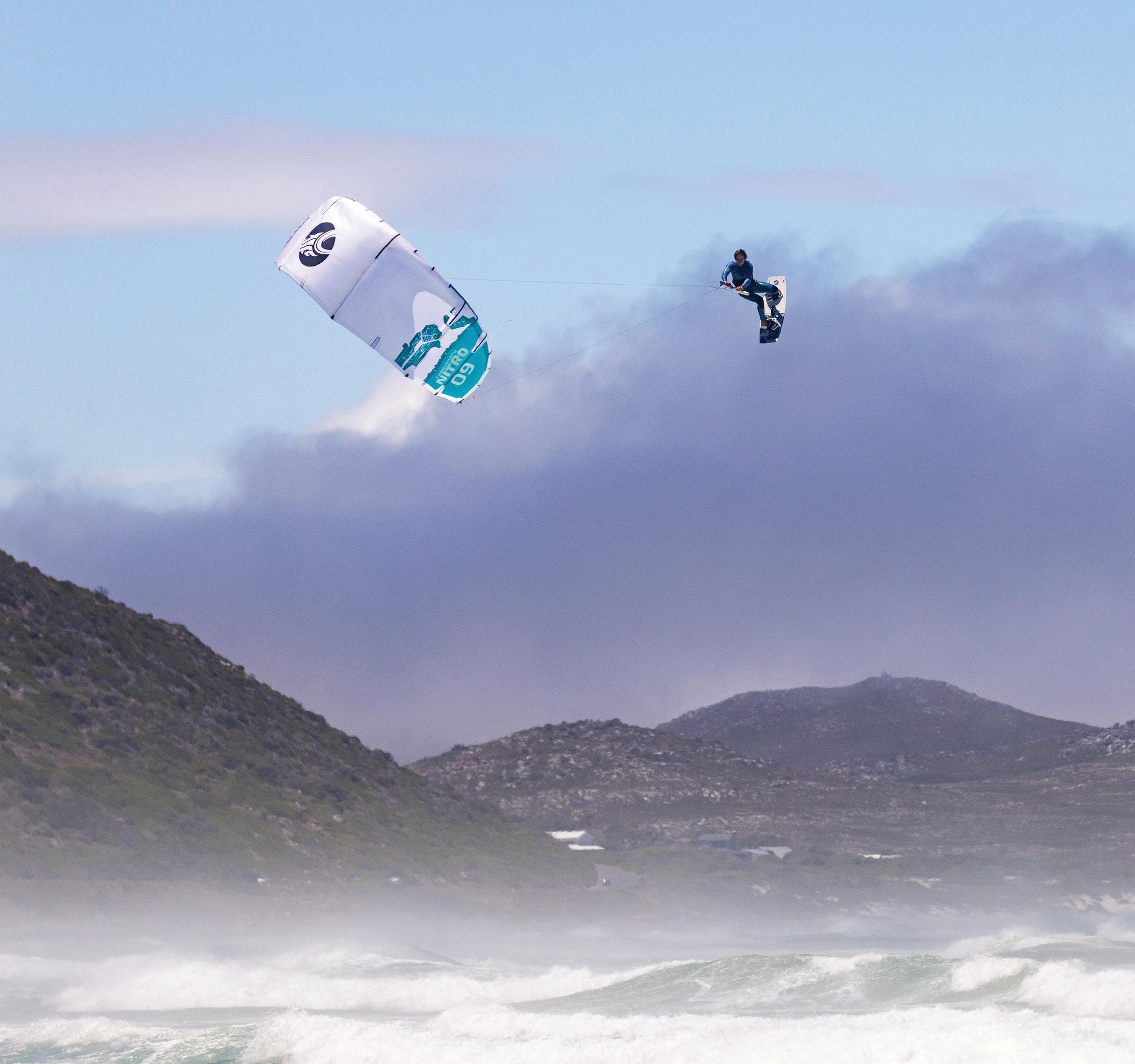
100 - KITESURFING MAGAZINE / VOL 9 / ISSUE 1
NITRO
6 / 7 / 8 / 9 / 10 / 12
NEW
cabrinha.com
Stijn Mul J. Boulding








 Amanda Cantor Ewan Jaspan: Triad Kite, Motion Twin Tip
Amanda Cantor Ewan Jaspan: Triad Kite, Motion Twin Tip



















 by
PHOTO: ANDRE MAGARAO RIDER: LOUKA PITOT LOCATION: TAIBA, BRAZIL
by
PHOTO: ANDRE MAGARAO RIDER: LOUKA PITOT LOCATION: TAIBA, BRAZIL

 PHOTO: NOÈ FONT
RIDER: XANDER RAITH
PHOTO: NOÈ FONT
RIDER: XANDER RAITH









 —John Bryja, Kitesurfing Magazine, Publisher
—John Bryja, Kitesurfing Magazine, Publisher


























 Australian Hood River transplant, Ewan Jaspan.
Dogtown and Z-Boys.
Australian Hood River transplant, Ewan Jaspan.
Dogtown and Z-Boys.






















 Jake Kelsick throws a sick wall.
Jake Kelsick throws a sick wall.


















 WORDS BY EVAN NETSCH PHOTOS BY NICOLE LAIBEN
WORDS BY EVAN NETSCH PHOTOS BY NICOLE LAIBEN



































 What we thought was a wave crashing into a rock was actually the blow-spout of a humpback whale just beyond where we were kiting. Port Orford, Oregon. Xander Raith photo.
What we thought was a wave crashing into a rock was actually the blow-spout of a humpback whale just beyond where we were kiting. Port Orford, Oregon. Xander Raith photo.

















































































